

FLIGHT REVIEW:



FLIGHT REVIEW:
H145-D3
– 5-BLADE
The sacrifices of Flying
Twins: Lethal Vmc training!
UAVs approved for Civil Airspace
Sling vs Airlines - Race to Cape Town
Do you need luck to fly?
Jim: Training: MORE Fuelish Mistakes
SAAF Choices - Repair or Replace?
What makes the PC-12 the most popular single-engine business aircraft? Experience. With a rapidly growing global fleet of more than 2,000 aircraft, the “World’s Greatest Single” has solidified its reputation for superior value retention, low operating costs and safe operation. With an aircraft this proven, the numbers really do speak for themselves.
pilatus-aircraft.com
Contact Pilatus PC-12 Centre Southern Africa, your nearest Authorised Pilatus PC-12 NGX Sales Centre for further information on
Tel: +27 11 383 0800, Cell +27 82 511 7312 or Email: aircraftsales@pilatuscentre.co.za

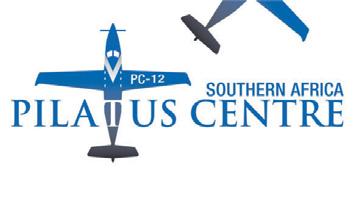
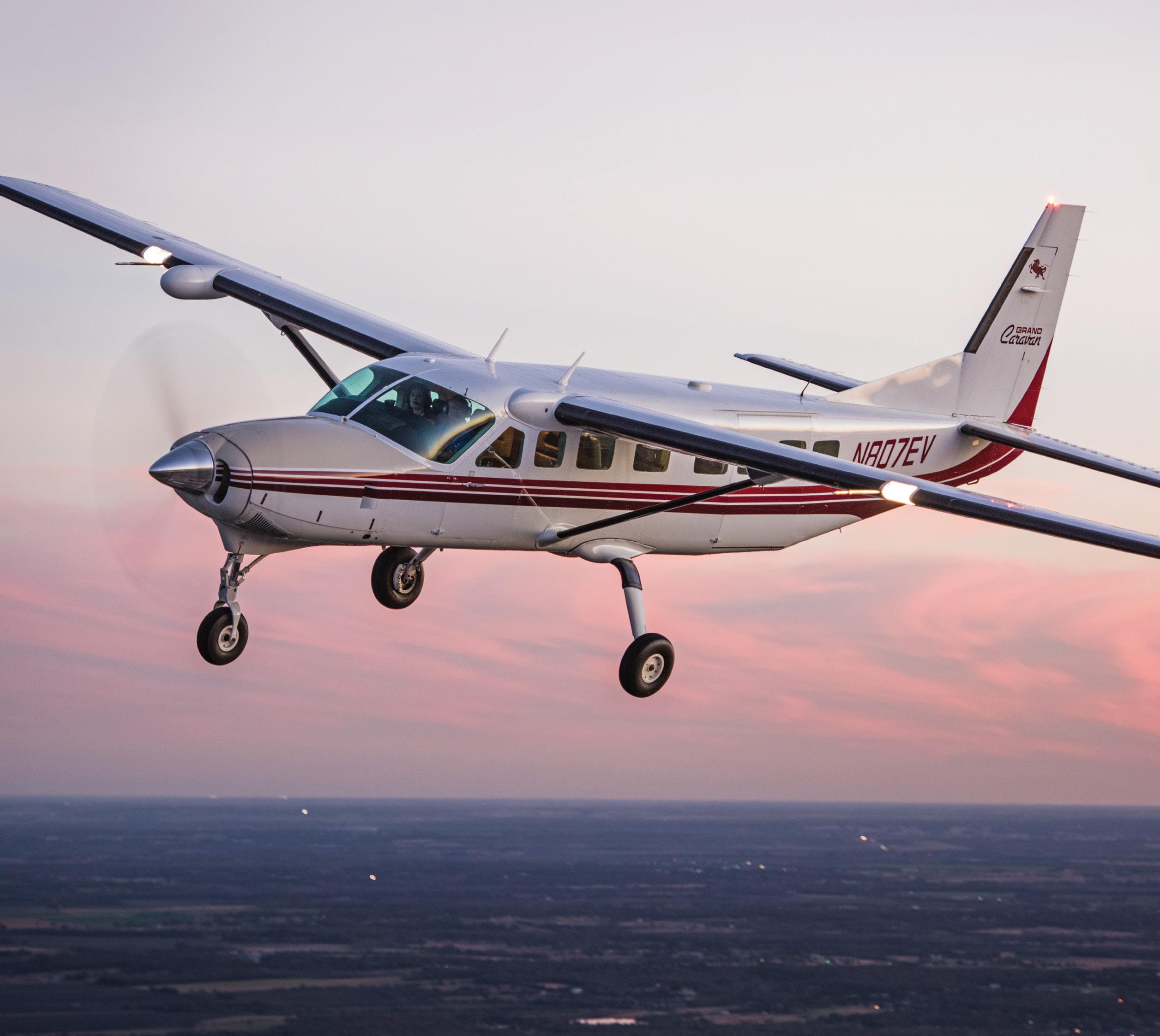
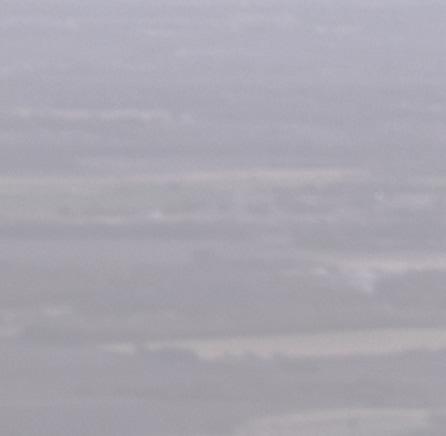
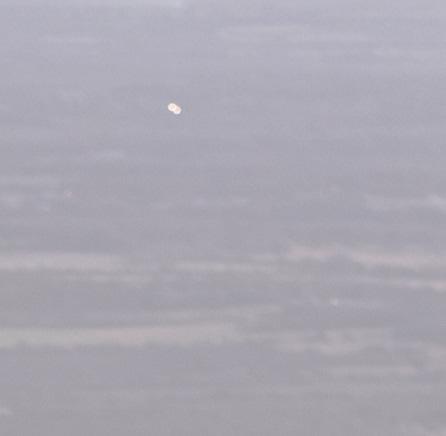












For many South African private pilots, flying is becoming too expensive for fun flying.
THE RECREATIONAL FLYING INDUSTRY has been steadily eroded by increases in the cost of living and Rand devaluation. And then there is my old favourite – the ‘buggeration’ factor –which is the difficulty of trying to get things done by obdurate CAA officials.
Flying has a large proportion of dollar-based costs, specifically: fuel, maintenance and aircraft prices. It’s now only the very rich who can afford to burn holes in the sky with 210s or Barons. I cannot believe that I managed to hire and fly a Baron when I was a 30 year old middle manager.
The reduction in private flying would have been catastrophic for the GA industry if it hadn’t been for the massive surge in demand for flying training from Africa and the Middle East. Part of the reason is that instructors and accommodation costs in South Africa have become cheap.
And so we continue to see fatal accidents by instructors who did not know better. The latest tragedy is that of a C172 reportedly doing stall turns at Joburg’s Baragwanath airfield. It stalled and spun in, killing the Tanzanian instructor and student.
I had almost 1000 hours before I learned the dangers of stall turns. While vertical, the plane can easily flick onto its back into an inverted flat spin. The only way to stop 200 hour instructors doing this, is to have a rigorous system in place that monitors the flight and the instructors’ actions. The gliding community has affordable software that does this.
Another solution is to put the fear of death into instructors and students. The SAAF did this with a particularly gory slideshow that showed the unsanitised remains of pilots who had reduced themselves to bits of raw meat.

There’s an old adage; ‘If you pay peanuts you get monkeys’. The problem of paying instructors peanuts continues to undermine flight instruction. Where are the professional flight instructors, such as Jim Davis, who made it their life’s mission to train pilots? They have almost all been made redundant by 200-hour comm pilots who are prepared to accept the proverbial peanuts for the sake of hour
Commenting on the Baragwanath accident, Jim Davis asked, “Where did they learn to do that? What sort of example had their instructor set? And how does he sleep at night? And who had to tell their mummies and daddies, who had possibly hocked their life savings, that their pride and joy was now strawberry jam? And will the CAA even invite the CFI in for tea and biscuits?”
If South African flying training is to continue to be world-class, it will have to improve its internal controls.
j


12 Guy Leitch - PLANE VS CAR RACES
18 Peter Garrison - RANDOM LUCKINESS
22 Jim Davis - RIGHT SEAT RULES 15
32 Jim Davis - ACCIDENT REPORT
36 Morne Booij-Liewes- REGISTER REVIEW
04 Hugh Pryor - STOP CARDS 2
08 Laura McDermid - IRIS JOINS SUNBIRD 2



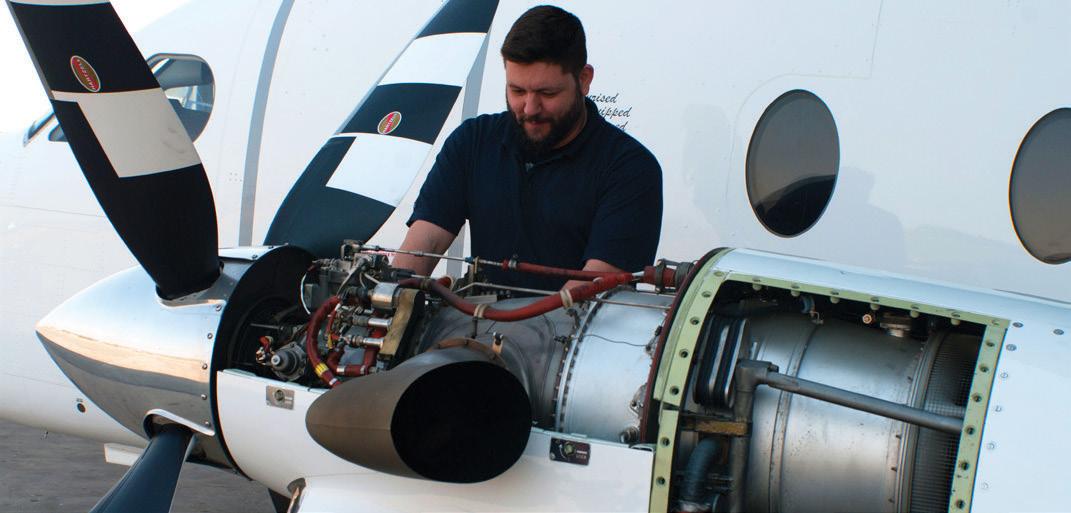
No surprise pricing
No surprise pricing
No compromise on quality
No compromise on quality
No sweeping exclusions
No sweeping exclusions
No wonder it’s so popular!
No wonder it’s so popular!
StandardAero Lanseria, a Pratt & Whitney PT6A designated overhaul facility (DOF) and the sole independent DOF approved for the PT6A-140, is pleased to support operators across Africa with P&W’s flat rate overhaul (FRO) program, which combines OEM-level quality with guaranteed “not to exceed” capped pricing. Meaning that you can plan your maintenance expenses with confidence, and without any compromises.
StandardAero Lanseria, a Pratt & Whitney PT6A designated overhaul facility (DOF) and the sole independent DOF approved for the PT6A-140, is pleased to support operators across Africa with P&W’s flat rate overhaul (FRO) program, which combines OEM-level quality with guaranteed “not to exceed” capped pricing. Meaning that you can plan your maintenance expenses with confidence, and without any compromises.
The FRO program does not incur extra charges for typical corrosion, sulphidation or repairable foreign object damage (FOD), and PMA parts are accepted.
The FRO program does not incur extra charges for typical corrosion, sulphidation or repairable foreign object damage (FOD), and PMA parts are accepted.



As the industry’s leading independent aeroengine MRO provider, StandardAero is trusted by airline, governmental and business aviation operators worldwide for responsive, tailored support solutions. Contact us today to learn more.
As the industry’s leading independent aeroengine MRO provider, StandardAero is trusted by airline, governmental and business aviation operators worldwide for responsive, tailored support solutions. Contact us today to learn more.


tailBeaconX
AV-30 panel display. With seamless integration, advanced features, and reliability at your fingertips, the destinations are limitless. uAvionix—your key to opening the skies.








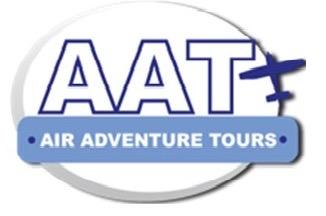


SA FLYER COLUMNIST John Bassi is one of the last of the one-man businesses to successfully operate a Bell 206 JetRanger. He uses ZS-HFD in an incredible variety of roles and has published a book called ‘Pilot in the Wild’ describing his experiences.
Apart from the fact that John has managed to perfectly expose both the inside and outside of the helicopter cockpit, we publish this picture in recognition of this month’s Helicopter feature and to warn pilots of the hazards of a low cloud base in the mountains. John got a passenger to take this picture of him taking on the winter weather in the Drakensberg in his trusty JetRanger. He used his Nikon D5000 with the lens at its widest 18mm. Exposure is 1/200th sec and F6.3 using the on-camera flash.

I reckon plane vs car races are usually pointless stunts.
AIRSHOW ACTS HAVE A CAR RACING up and down the runway burning rubber throwing U-turns while a plane roars overhead and does stall turns at the ends of the runway. Like professional wrestling, the winner is chosen beforehand.
This doesn’t mean that the whole idea of plane vs car races is a bad one. Thirty years ago, Aero Africa magazine did a proper comparison. And now Sling Aircraft have done a race between a Sling TSi and the airlines.
To their credit, the Sling race was a real challenge, and with typical Sling bravado, it was ambitious. They took on the airlines from their base at Tedderfield, south of Joburg, for the 660 nm to Stellenbosch. That’s a daunting distance for a light sport aircraft – even a Sling 916 TSi.
Naturally the Sling flyers won. They landed after 4h52, for an average speed of 146 knots. They quickly assembled their bikes, slipped out through a conveniently unlocked back gate, and beat Andrew to Spier by 10 minutes. The race was successful in that it showed off the Sling’s speed and range, despite having a 20-knot headwind.
The race was finely judged.
The race was finely judged. Andrew even had time for a quick pitstop in the Slow lounge at OR Tambo and may have won if they hadn’t hit Friday rush hour traffic out of Cape Town. It is a great endorsement for the latest Sling TSi 916 that it was able to compete against a Boeing doing 460 knots for a 1200 km sector.
Sling stacked the odds in favour of their plane by starting the race from their home base and ending it at Spier Estate - an easy 3.5 km bicycle ride from Stellenbosch. So Mike Blyth and James Pitman packed two dismantled Sling Tagati bikes into the back of the Sling TSi. They were racing against Sling Co-CEO Andrew Pitman, who had to drive to OR Tambo, check-in (also with a bike) and board a FlySafair 737-800 to Cape Town International. There he was met by a Guy for the drive to Spier.
The Aero Africa Magazine race thirty years ago pitted a Bonanza against a Boeing and also a car, for a race between Sandton and the centre of Durban.
I got to fly a V-tail, editor John Miller drove a BMW 530, and advertising salesman Nigel Brown flew SAA to Durban. Many years may have passed, but my report makes fascinating reading – even if just to recall how little things cost then.

I wrote; We all know that planes should cover ground at a great speed. It’s generally what they were designed for. But it may often seem to the frustrated air traveller that it would have been quicker to drive. This is particularly true for scheduled flights where you can spend more time in airports than in the air.
So, surely the antidote to departure lounges is general aviation, where the plane waits for you, not you for it? And not only does the plane wait for you, but flying yourself is actually FUN. This oxymoronic opportunity to mix work with pleasure is as rare as finding a sexy woman who can cook and raise children.
expensive toy, you can always travel by car like normal people. After all, South Africa still has the remains of great roads, so why not use them, even if only to dodge trucks?
You control the departure time
Why not indeed? For most distances less than 250 km, or 2.5 hours driving, the lowly car is better than almost any form of transport, other than the helicopter. But what about a typical business trip over say 250 to 750 km? For example a trip from Johannesburg to Durban. In South Africa this is by far the most common type of one day business trip, and one where the three transport options are frequently used.
But wait. I can already hear the many critics of general aviation taking a deep breath. Light aircraft are slow, noisy, uncomfortable and unsafe contraptions. Or else they are ridiculously expensive miniaturised versions of real planes whose sole function is to be a status symbol to stroke the chairman’s ego.
Okay then, if airlines have departure lounges and general aviation is either slow, noisy or an
A high performance single was felt to be the most typical conveyance for our hypothetical businessman, particularly if it was owner flown. The value of the V tail was, at R250 000, on a par with the car at R230 000. For the airline travellers, SAA provided two business class tickets, value R914 each.
Being a general aviation publication, we naturally made it as difficult as possible for private flying to compete with the other two options. By choosing the Johannesburg -

Durban trip we were pitting a light aircraft against a Boeing. Further, it is a near ideal trip for a car as the roads are about the best in the country. To further favour the car, we chose a starting point about as far across town from the airports as possible, and for the destination, a hotel in the middle of Durban.
While the flyers would have to hire cars, the drivers could drive door to door. The Boeing team had to drive from Sandton to Jan Smuts. They cut it very fine by checking in for their flight late – and thus avoiding departure lounge ennui. After 47 minutes flight time, the Boeing touched down 44 minutes before the Bonanza which, thanks to a tailwind, needed just 1h35.
It took the Boeing team 30 minutes to retrieve their bags and hire a car. As they were arriving at the finish at the Royal Hotel, the Bonny team were still waiting for a hired car to be delivered to Virginia.
Door to door the Bonanza team took 2h55, 20 minutes longer than the SAA flyers.
When the Bonny travellers were pulling up at the Royal Hotel, the car drivers were torturing the tyres down Van Reenen’s pass, all the while squinting like Clint Eastwood into the middle distance for speed trap spaghetti. Flaunting the
law, they wrung the Bee Em out, making it to the finish 5h15 after leaving home. They averaged 150 km/h.
So, there we all were in Durban, and what had we proved? Purely on time taken, there’s almost nothing between using airlines and flying yourself. If the airline flyers had a normal 30 minute check in, they would probably have taken the same time as the Bonanza flyers, but had a more comfortable and relaxing flight. The Bonny is more demanding, but then it’s also more rewarding, particularly if you fly it yourself. But on both time and comfort, the Boeing beat the Bonanza.
And now for the million-dollar question. What about cost? Here direct comparisons can be drawn:
AIRWAYS:
The SAA business class return airfare is R914. Car hire was R260 per day for a decent car plus R1,18 per km, or say another R80 to the city and back to the airport. Parking all day at Jan Smuts will cost about R20 and getting to Smuts and back in one’s own car about another R80, depending on car and suburb. Total airline cost for two people: R2268.

Owner flown Bonanza for 4 hours total utilisation at R350 per hour totals R1400. Car hire is the same as for airways, but with less distance: R260 + R60 being R 320. Parking at Rand no charge, but say R20 and travelling from and to home, same as for airways; R80. Total General Aviation cost: R1820
BY ROAD:
BMW 530i at AA rates of R2,87 per km for 1200 km is R3444. On top of this the drivers would not be expected to drive down to Durban, do a day’s work and then drive back the same day so add in at least one hotel room at the Royal for at least another R600R1000 for the accommodation depending on whether the room is shared. Adding the cost of accommodation pushes the already expensive driving costs into orbit. Total driving cost: R3444 upwards.
And so, not only is driving the most stressful and dangerous, it’s also the slowest and by far the most expensive. Obviously, costs come down dramatically when four pack into the car (although the accommodation cost would
be huge). The Bonanza was, for two people, clearly the cheapest. Like the car, it could have taken four or five people, thus reducing the cost even further and without the need for hotel accommodation.
The unassailable advantage of general aviation is its flexibility. You control the departure time, so you do not have to stop in the middle of a vital meeting to catch a plane. It is however more tiring and demanding than letting others do the flying for you by going airways.
We devised this exercise without any preconceived notions as to which mode of travel would be best. Clearly a different choice of destinations would have yielded different results. Number of people travelling, overall distance and distance of destination airports from airline served airports and general aviation airfields are absolutely critical components of any comparison. But for this exercise general aviation was, in terms of cost and convenience, the clear winner.
I can’t think of any reason to drive. j
guy@saflyermag.co.za


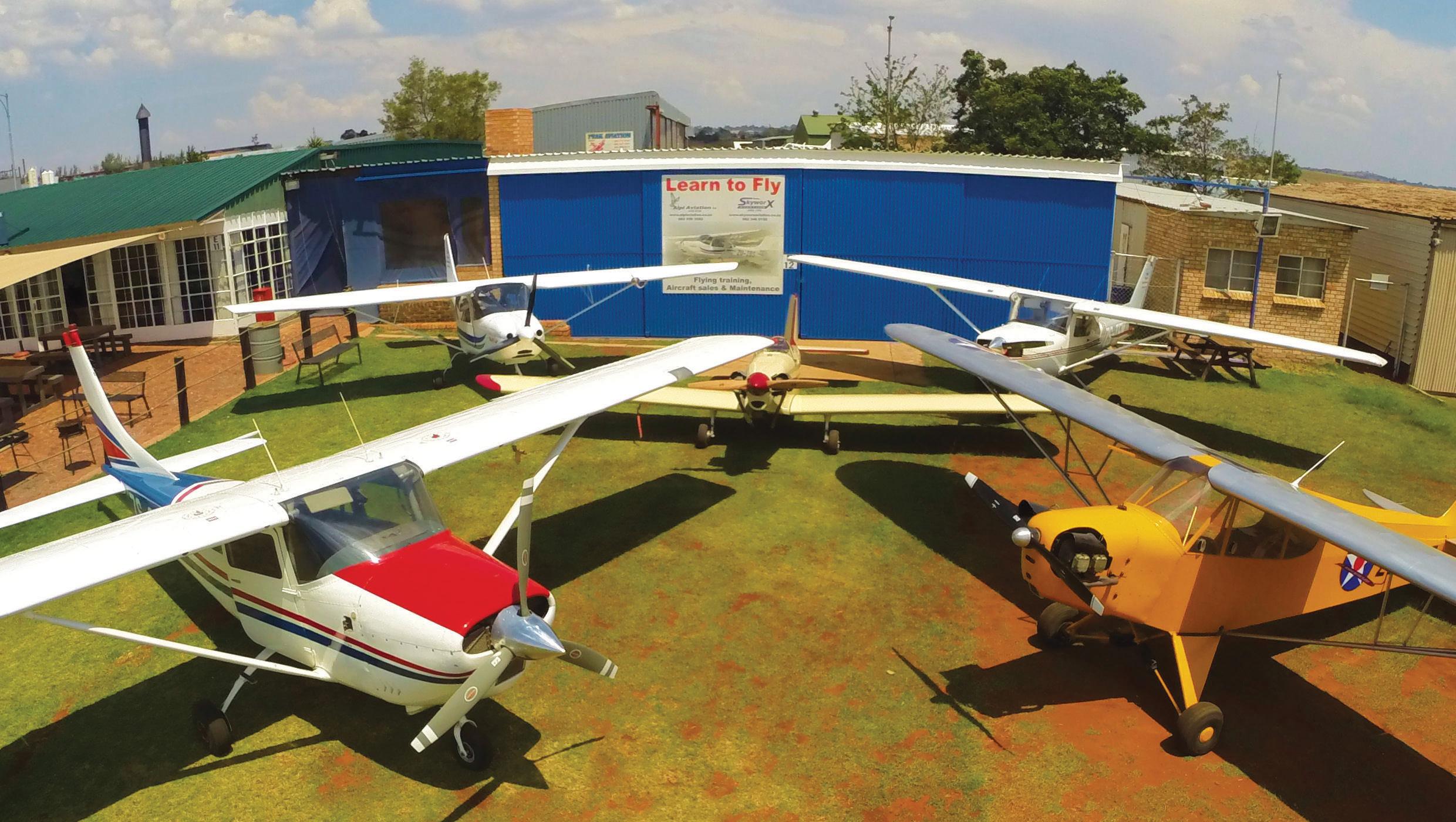






This beautiful 4 seater is on the market at Wonderboom.
ZAR2,200,000.00. (Vat excl)
Aircraft type: 1964 PA28-235.
S/N: 28-10415. Reg: ZS-DYV
Engine type: Lycoming 0-540-B4B5
Propeller type: Hartzell HC-J3YR-1RF
Airframe Total Time: 3745.5
Aircraft Hobbs: 3745.5
Engine S/N: RL-712-40E
Engine Complete new Engine TT: 250
Propeller S/N: PA832B
Propeller Complete New Propeller TT: 250
Garmin International GNS430W (LORAN/GPS)
GMA Audio Panel/Intercom
iCOM A200
406MHZ Elt
S-Tec Corporation System 50 (Autopilot)
CONTACT:
Alex McDonald +264 81 128 6821
Email: alex@namagri.com



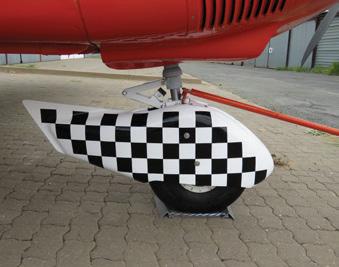



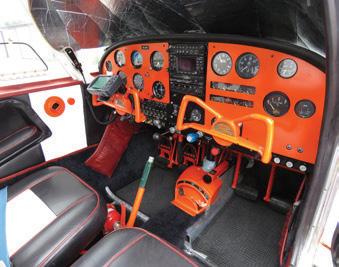




Someone once suggested that if you want to know how you would feel crossing an ocean in a singleengine aeroplane, you should just fly out to sea for a couple of hours and then turn around and come back.
THERE’S SOMETHING ABOUT being out of sight of land that, to parrot Samuel Johnson’s remark about the prospect of being hanged in a fortnight, “concentrates the mind wonderfully.” It also gives new and sinister meaning to random engine sounds.
My erstwhile flying companion Nancy – she has now changed her mind and sworn off flying in anything smaller than an A320 – had a strict rule that all flying in which she participated had to have a clear purpose. It couldn’t just be frivolous, like going up on a beautiful afternoon to enjoy the sights or “dance the skies on laughter-silvered wings.” You had to be going somewhere.
Hubris attracts the attention of easily irritated gods. Niobe boasted of her many and fine children only to have Apollo and Artemis kill them; Arachne claimed to be a better weaver than Athena, and was transformed into a spider for her pains. Those tales from mythology arise from some ancient superstitious stratum in our brains that warns us not to stretch our luck.
Luck is notoriously fickle. Another of those useful Greeks, the lawmaker Solon, told wealthy King Croesus, who thought himself the luckiest man alive, that no man could be counted lucky until he was dead. In other words, you never know until it’s all over when your luck might turn.
Flying out to sea for a couple of hours just to find out what automatic rough sounds like wouldn’t cut it. For some reason I share her view of that particular experiment, though I don’t know why. I have flown single engine across the Atlantic and the Pacific, and even Lake Michigan, but I would feel uneasy flying two hours out to sea for no reason at all.
I guess Nancy’s idea was that you shouldn’t be insolent toward the universe. The Greeks had a word for it: hubris.
Good luck or bad? It’s often a matter of framing. In 1982 I was holding short of a runway when an out-of-control 210, propeller whirling, slammed into me, cutting my plane to pieces. I emerged unhurt. A local TV news team soon appeared, and the reporter asked me if I didn’t feel lucky.
This was an odd question, it seemed to me. I was obviously the unfortunate victim of a very costly accident. An hour earlier I had had an aeroplane; now I didn’t. But the reporter was
looking at it differently. From his perspective, I had survived an aeroplane accident, an occurrence so reliably fatal that I was extraordinarily lucky just to be talking to him.
Another dose of mixed luck befell me one day at 11,500 feet over California’s central valley. I was cruising happily in fine weather when suddenly grey smoke started pouring from the cooling air outlets on the sides of the cowling. Convinced the engine was on fire, I shut off the fuel, popped the airbrakes and pointed the nose downward. A conveniently empty road presented itself, and in four minutes I was on it.
The aeroplane was covered with oil. Dripping onto the road, it made a Melmoth-shaped stain. I soon found the problem: a hose going to the turbocharger had broken off, squirting oil onto the hot turbo. It had made tons of smoke, but luckily no fire. No oil to speak of remained in the engine.
I left the aeroplane in the centre of the littletravelled road – it seemed to me that it was most conspicuous there, and therefore least likely to be hit – and hitched a ride to the nearest town. The first car to come along contained a trio of strait-laced Latina women; they deliberated for some time about the propriety of taking an unknown man aboard, but finally bought my story, which was, admittedly, far-fetched, but for which I had, I thought, very convincing evidence.
A few miles up the road in Dos Palos I found a pilot who gave me eight quarts of aviation oil and a ride back to the aeroplane with some tools. We did a temporary repair to stanch the bleeding and stop the turbo from spinning without oil, and replaced the lost oil in the engine; then my benefactor went on his way.

dozing in the cockpit, sometimes lounging on the wing, sometimes chatting with a passing Highway Patrol officer who turned out to be a pilot himself or with field workers who brought me a dinner of cantaloupe melons and salsa.
the engine was on fire
I’d been thinking that I would fly down to the next airport, Coalinga, and land to check the integrity of the repair. But it was dusk now, and I hesitated to risk another failure in darkness. So I pushed the plane onto a bare patch beside the road. There I spent a starry night, sometimes
I was back in Los Angeles by ten the next morning.
Good luck or bad? It’s usually bad luck when part of an aeroplane breaks, but that failed fitting had given me an uncommonly interesting night, full of emotion and mystery and the slowly wheeling Milky Way and the kindness of strangers, a night I will never forget. That’s the etymology of “adventure” – something that just comes to you, uninvited.
Sometimes luck is precisely targeted –something unusual that arrives just when it’s needed. One of those strokes of luck probably saved my life. It was during a period of ill-
advised experimentation with my first homebuilt. For some reason I got the idea I ought to mute the exhaust, and I built two mufflers consisting of concentric tubes, the inner one perforated, with fiberglass packing between them. I slung them underneath the belly, connected to the exhaust pipes by short lengths of spiral-wound flexible stainless-steel tubing
They were made of aluminium, because I had it on good authority that the gases leaving the exhaust were at 500 degrees Fahrenheit or so, which aluminium could tolerate. But that was for an open pipe. I failed to consider that enclosing the exhaust flow in mufflers might raise its temperature considerably.
began rising from the right side of the cabin floor. By the time I was on the ground it was getting hard to breathe.
What had happened was that my mufflers had lasted about half a minute before collapsing into solid plugs of crumpled aluminium and glass fibre. Not a wisp of gas could get through them. But by sheer luck the flexible steel link on the right side had cracked – or maybe it already had a crack –and just enough exhaust leaked from that crack to keep the three cylinders on the right side of the engine working. It was the jet of exhaust gas from that crack that was burning a hole in the cabin floor.
And so it did. I was at about 300 feet over a landscape of railroad tracks, power lines, trucks and cars when there was a loud thud and the engine lost power. But there was still a little left. I limped around the pattern without gaining another inch of altitude. As I turned base smoke
It’s said that luck favours the prepared, but sometimes luck just favours the stupid. Or maybe “luck” is just another word for “what happened.” j

A little remarked upon factoid emerged in the middle of February. SAA told parliament that it had lost R776 million in 9 months. Extrapolate it to a full year, and SAA is once again losing R1 BILLION a year.
R1 BILLION is how much SAA lost on average each year when it was trading ‘normally’ pre-Dudu Myeni’s wrecking ball. The key difference is that SAA was turning over R26 billion then and not the R6 billion it is now.
Guy simply remarked; “Deja Poo” – (which means, we have seen this shit before)



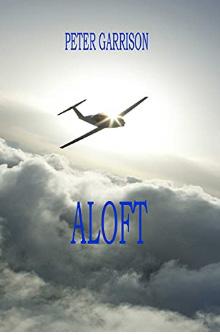
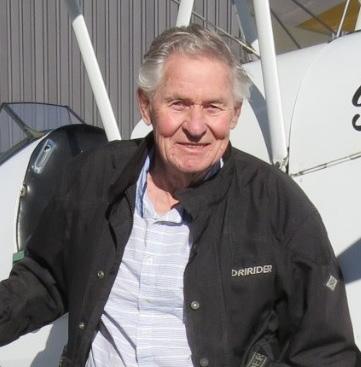
INSTRUCTORS, INSTRUCTORS, INSTRUCTORS – THIS IS FOR YOU (AND EVERYONE ELSE).
Most engine ‘failures’ aren’t – they are pilot failures. To a large extent this means instructor failures. Instructors are often not good at teaching the relationship between fuel management and life-expectancy. And, of course, to manage the fuel intelligently you have to understand the mechanics and idiosyncrasies of each aeroplane’s fuel system. If instructors don’t get it right – how the hell is everyone else going to?
CHEROKEE INSTRUCTORS HAVE A RIGHT – nay a duty – to grab the thigh of their pupils, m or f, when they change tanks. You have to pull their leg away from the selector so you can see that they have done it properly.
There was a recent case in the States when a Cherokee flew into a lamp pole at night. It crashed to the ground and burst into flames. Unbelievably everyone survived.
It was a training flight and the pupe switched the fuel off instead of changing tanks.
I’ve told the next story before, but it has so many life-saving lessons that it’s worth telling again.
both fuelgauges drifted to zero
Methinks a sexual harassment charge for grabbing their leg is less stressful than sailing into a lamp pole.
Bob Kershaw, a much decorated WW2 Spitfire pilot, was in the left hand seat, and Peter Anderson, a 1000 hour Private Pilot, was handling the maps and radios. Their wives were relaxing in the leather upholstery in the back of their new Twin Comanche. They were all in great spirits - this was their first trip in ZS-FAW.
I had done flight-tests for both of them in Peter’s Cherokee Six within the last few months, and found them both to be above average pilots.


They took off from George and headed west for Cape Town tracking parallel to the Outeniqua mountain range.
The first annoyance happened twenty minutes into the flight when the No.1 VHF packed up. No problem, they switched to VHF 2. A short while later this too began to disappoint. It was fading and not getting the range they expected at flightlevel 65.
Next, the ADF needle started wandering. Again no problem –the weather was great and you just stick between the mountains and the coast. But having three dodgy radios on the first trip was starting to take the fun out of things.
A couple of minutes later, as they passed Caledon both motors stopped simultaneously. There was no coughing or apology of any sort. One moment they were smooth as silk, the next - dead silence.
It was turning into a bad day - but not the end of the world - Caledon’s dirt runway was within easy gliding distance. Bob turned towards the field, made sure everyone was tied in and judged the descent beautifully.
Piper got it badly wrong.
Then, soon after half way, both fuel-gauges drifted to zero and stayed there no matter which of the six tanks were selected. This was puzzling because, although the auxiliaries were empty, the mains were half full and the tips were brimfull when they took off. They selected the tips and relaxed.
But fate had still not finished dealing her appalling hand.
They approached a little high – as one should on such occasions – and Bob only selected gear and flaps when certain of making the threshold comfortably.
The final crunch was just that – the crunch of alclad against gravel. They had done a wheelsup in their new aircraft.
Now, when I was a hangar-rat at Wonderboom in the 60s, my boss, and mentor, Zingi Harrison,
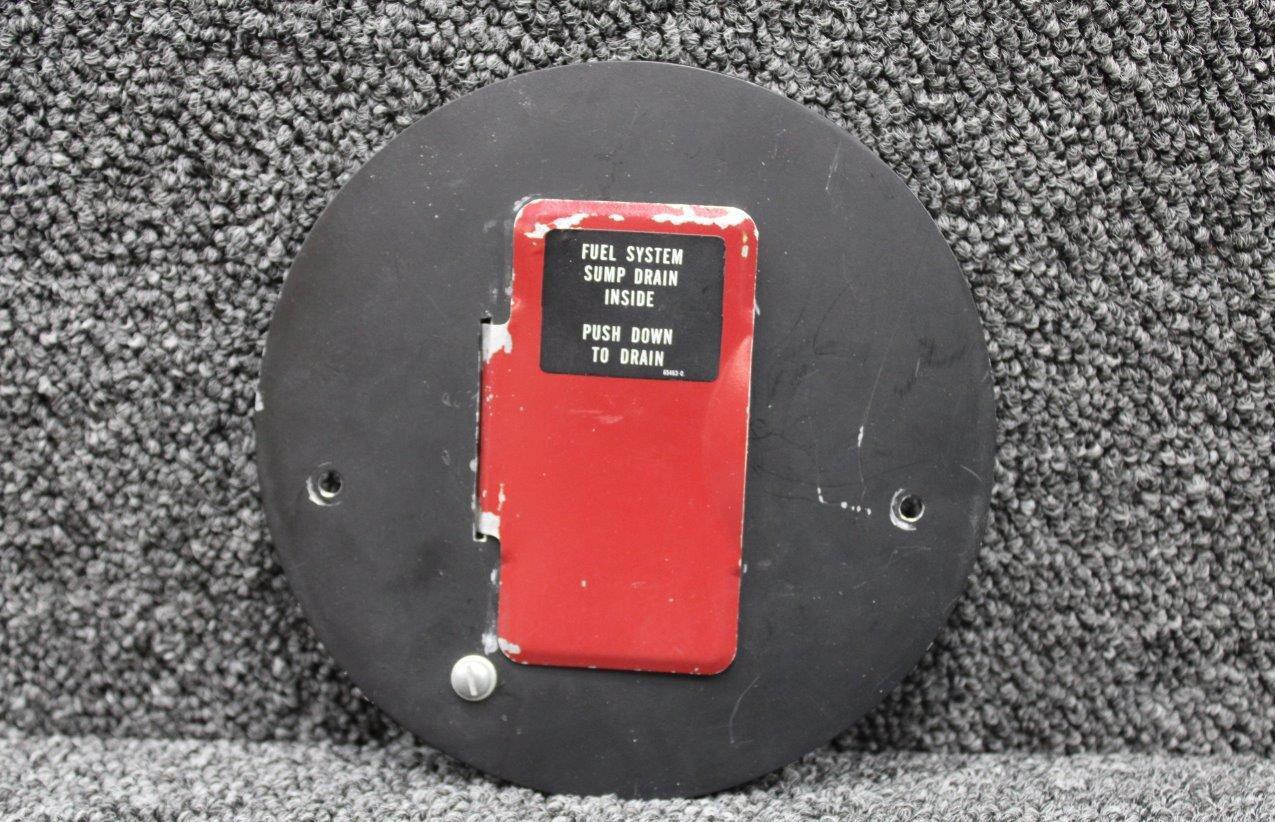
said, “Davis, when the dust has settled after an accident, there are only two things to blame. It was either the aircraft’s fault or the pilot’s. Don’t blame the weather, the dirty fuel, the crosswind or the slippery runway – those are pilot problems – the aircraft didn’t choose them.”
What Zingi said 60 years ago is still true for light aircraft accidents today.
So where does the blame lie for the broken Twin Comanche on that dusty Caledon strip? It seems pretty obvious that the aircraft was at fault.
But was it?
Bob was one of those guys who are a bit too slick around the cockpit. But the bottom line is that Bob didn’t understand the machinery he was flying.
He was not used to alternator switches. On most singles the alternator is switched on with the master. Twins usually have separate switches – one for each alternator, so you can test them individually. That’s right – Bob’s flashing hand never found those two blue switches.
this has to be about the stupidest thing
Here’s what really happened. That accident started two months before this flight. Bob had asked me to convert him to the twin; when I told him to expect around ten hours, he went to his buddy in East London who gave him a “quick conversion”. [Vomit].
After that, the events were predictable. First, the radios suffered from low voltage. Then came the fuel gauges. Next, the solenoids that select the tip-tanks dropped out, so fuel feed defaulted to the empty auxiliaries. Finally, there was no electricity to extend the gear and flaps.
How could two experienced pilots get it so wrong? Well, until the engines stopped there was nothing shouting; “Warning – look at me

– red flag”. Radios do pack up. Fuel gauges are not reliable. But both pilots had visually inspected all the tanks.
Electrical systems don’t wake you with clanging bells – they leave subtle clues, suggestions and innuendo. It is your job to understand these hints.
So the accident was caused by Bob not understanding the electrical system, or the fuel system. I see this as an instructor problem. I suspect Bob’s quick-conversion instructor was peering out from his hiding place in the woodpile.
Leon was a friend of one of my pupils at Phalaborwa. He bought a Tiger Moth from a guy who lives 30 miles inside the park. It was my job to collect the aircraft and fly it back to Phalaborwa with Leon as a passenger. Although he has bought the Tiger, he has never flown, or even sat in one before.
We take off from Letaba in the heat of the afternoon. The stifling air is red with dust from the feet of elephant and buffalo. I climb into a cooler, clearer atmosphere and level off before asking Leon if he wants to fly. Of course he does.
All is fine for a while but then he complains that the aircraft is trying to lose height. I tell him to trim back. He says that he has done that but it makes no difference. I bid him trim some more, and cast a beady eye on the duplicate trim lever in my cockpit. Nothing happens. He says he is trimming – and I say he is not. I decide to give him step-by-step instructions in this simple process, “you see the big lever next to your left leg? OK, now if you… Oh shit.”
The engine has stopped.
I tell Leon that I have control, and glance round for a landing field. We can make it to the lush green banks of the Letaba river – which is thick with hippo and crocodile – or there are a number of open patches between the thorn bushes. A landing should be no problem, but trekking through the bush amongst lions, snakes, elephants and buffalo holds little appeal.
I turn my attention inside the cockpit. A Tiger is a simple beast – there are no electrics, apart from the mag switches on the outside of the fuselage – both are ‘on’. The mixture richens itself automatically when you close the throttle. Carb-heat is also automatic. There’s only one tank – so I don’t need to check fuel selection, but habit takes my hand to the fuel cock which is out of sight below the panel. To my amazement it is switched off. I push it into the ‘on’ position and wait…and wait… and start thinking of buffalo again. Finally the engine, which has been windmilling, starts to splutter and cough. Eventually it gathers energy and becomes a healthy roar.
It’s easy to re-construct what happened. Because it was not a training flight I gave Leon no briefing, neither did I show him round the cockpit. When he thought he was trimming, he was actually switching the fuel off – both controls being near his left leg.

There are two lessons: always brief everyone, crew or passengers, who has access to any controls; and, if the engine just suddenly dies, without warning or unpleasant noises, it is almost certainly a fuel problem.
Piper got it badly wrong. Talk about briefing everyone – I do mean everyone. Those who know the Piper PA-32 Cherokee Six, Lance and Saratoga series should know where to look if you get a strong fuel smell, plus possible rough running, engine stoppage, massive fuel consumption etc.
Not sure? How about that drain that is hidden on the front of the rear spar? It’s protected by a spring loaded door that would fascinate a toddler – or even a more substantial citizen with an enquiring nature. If you open the door and then push the lever down, you will drain fuel from whichever tank is selected.
Much as I am a Piper fan, this has to be about the stupidest thing they have ever done. Not only can it be activated by someone who is out of sight of the pilot, but also because it has no practical application. Let me explain.
We drain fuel samples from each tank so we can check it is the right grade of fuel, it contains no water or crud, and it smells like avgas.
The POH claims that you can carry out these checks by watching the fuel as it moves through a section of plastic pipe.

This is BS. It’s to satisfy lazy or fat pilots who don’t fancy grovelling. South Africa is one of the few countries in the world where you can drain fuel on to the tarmac and get away with it. In the UK you would be invited to the office of the club’s flight safety officer who would raise an eyebrow at you – even if you aren’t a club member.
In Australia you would be reported to ATC by a policeman (all Australians think they are policemen). The guy in the tower will wait until you have taxied to the threshold and declared you are ready for takeoff. He will make the following call for all to hear, “Will the pilot of Cherokee VH-ABC report immediately to the airport manager to explain why he deliberately drained fuel on to the tarmac in contravention of regulation 128A, section 22 (iv) of the …”
In short – don’t do it.


You know how certain aircraft are associated with certain types of accident? Mention a wheels-up, and a C210 springs to mind. The early ones were guaranteed to disappoint at some stage when you selected gear down.
Mention an aircraft on its back with a broken nose wheel, and we know it’s a training Cessna. That little wheel from a supermarket trolly was designed for taxying only – not for students whose instructors have encouraged them to approach at 10 knots faster than book figure.
Mention a twin that has had both engines croak within minutes of each other and you must be talking about a PA-32 Navajo. Their fuel gauges are inveterate liars.
But why should this be? Hell, aeroplanes are enormously expensive things, and they have unbelievably expensive fuel gauges – surely one should expect some degree of accuracy –particularly when such gauges claim to predict the life-expectancy of all on board.
Even the cheapest car has gauges that will tell you within a few kilometres how far you can go
on the remaining fuel – why can’t aeroplanes do the same?
Well, there are several reasons, but strangely, one of the main ones is wing design. As the wings are the best place to store the fuel, the shape of the tanks must largely conform to the shape of the wings.
Now, ideally you want a fuel tank to be pretty much the shape of a shoe box facing fore-andaft with the float for the gauge slap in the middle. This gives you a situation where the float will read correctly in either a climb or a descent.
It will also read correctly when you bank in a turn. The thing to remember is that the fuel goes where the ball goes. So even in a steep turn the fuel will stay in the middle of the tank – as long as you have the ball in the middle – which you always do, of course.
So now we have to try fitting this fore-and-aft shoe box into the wing – and it obviously won’t go. We have to turn it sideways so it fits along the main spar – and stretch it so it holds enough gas. And squash it down so it conforms to the wing shape.
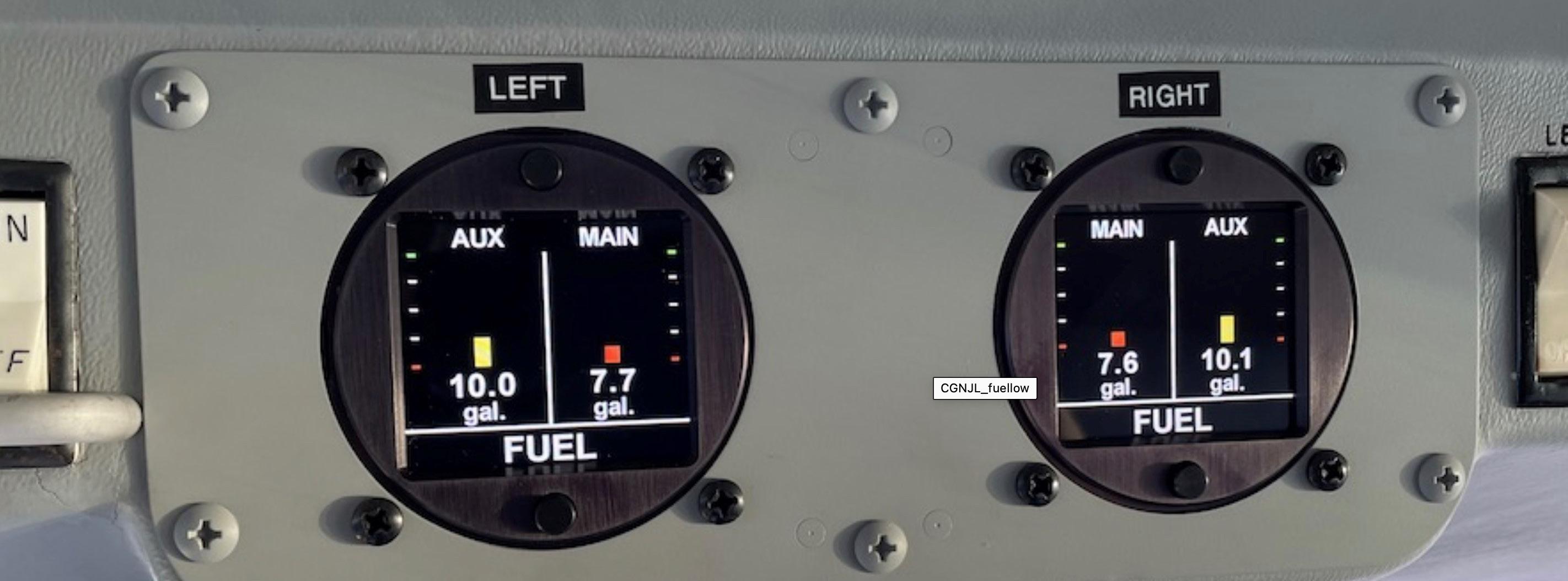
Older aerofoils had the main spar (and maximum thickness) fairly far forward so the fuel tanks were behind the spar (except for Bonanzas). Then the designers decided that a more symmetrical laminar-flow aerofoil, with the spar further back, worked better. This created more space ahead of the spar, so that’s where the tanks were put.
And of course most aeroplanes, particularly low wing ones, have some dihedral, so you end up with a long, almost sausage-shaped, tank that is tipped in towards the fuselage. Have a look at the diagram and you will understand the difficulty. On the Navajo the fuel gauge problem is so bad that even a dip-stick is pretty useless –it only gets wet if the tanks are more than ¾ full.
The diagram shows a tank that’s half full – it’s an exaggerated view of what fuel gauge designers have to cope with.
If they place the float in position A, the gauge is going to show full – even when the tank is way less than half.
If they place it in position B, the gauge will read correctly in the mid-range. But it will show full when the tank is far from full, and it will show empty when there is plenty of fuel.
Position C will give empty readings even when the tank is way over half.
Finally it’s absolutely no use looking in the tank, or dipping it unless it’s close to full.
Next time we are going to look at even more ways the fuel system can disappoint.
Instructors, I can’t do it from here – you have to understand each aircraft’s peculiarities – and then what do you have to do? Tell your pupes about them – NO. Show your pupes what the manual says about them – NO (actually you must do this). But most important – INVOLVE them by going to the aeroplane, or better still the AMO, and making your pupes get their hands green by probing every part of the fuel system. j


Aircraft registration: ZS-FET
Aircraft owner: Cape Aero Club
Date and time of accident: 25 April 2006; 1200Z
Type of aircraft: Beech D95A
Type of operation: Training
PIC license type: Airline Transport
License valid: Yes
PIC age: 62
PIC total hours: 9300
PIC hours on type: Unknown
• This discussion is to promote safety and not to establish liability.
• CAA’s report contains padding and repetition, so in the interest of clarity, I have paraphrased extensively.
Last point of departure: Cape Town (FACT)
Intended point of landing: Cape Town (FACT)
Location of accident site: Atlantis – near Cape Town 316 ft.
Meteorological information: Fine
POB: 2 + 1
People injured: 0
People killed: 3
Pilot undergoing conversion training.
Nationality: Sudanese
Gender: Male
Age: 21
Licence Type: Commercial
Licence valid: Yes
Type Endorsed: No
Synopsis:
THE INSTRUCTOR AND PILOT accompanied by a passenger (also an instructor) took off on a training flight from Cape Town. The training to be conducted was asymmetric circuits and engine failure during a missed approach.
Ratings: Night
Total Hours: 232
Total Past 90 Days: 5.4
On Type 90 Days: 5.4
Total on Type: 5.4
The flight was to be FACT – Delta 200(FADX) –Fisantekraal (FAFK) and back to FACT. The aircraft wreckage was found approximately 5.4 nm northeast of FADX. There was no post-impact fire. There were no eyewitnesses nor was there any emergency call.
Cape Town ATC radar recordings show the aircraft in and around the Atlantis/Philadelphia area until it disappeared from the radar when it went below radar altitude detection at about 3 800 ft.
The pilot’s training file showed he had completed all his conversion training exercises, and they were signed out by the instructor. The engine failure during the missed approach was the only exercise left to complete the type rating.
Examination of the wreckage revealed that the aircraft was rotating in an anti-clockwise direction on impact. The nose-down pitch angle at impact was approximately 15º. There was no horizontal movement of the aircraft, and the wreckage was not scattered.
The indication on the turn-and-bank [sic. - to be pedantic it is a turn-and-slip indicator] instrument showed that the aircraft was in a left turn.
The flap lever was set at 20º and the landing gear was extended. The control column was in the aft position with the yoke broken. The left-hand wing was destroyed, but the right-hand wing was still intact with wrinkles on the top surface.
The propellers were embedded in the ground. No sign of rotation on either propeller was evident. The planned exercise was for the pilot to demonstrate the capability of maintaining asymmetric climb with one engine inoperative. During the performance of the missed approach procedure and during climb – with the aircraft in the landing configuration – the instructor would simulate an engine failure by feathering one engine – the pilot is supposed to correct and maintain the flight.


The onsite evidence suggested that the aircraft entered into an anti-clockwise spin before crashing in a nose-down attitude, fatally injuring all onboard. The intention of the flight was to provide training as to how to conduct and maintain asymmetric climb of the aircraft during a missed approach procedure.
The possibility exists that the instructor feathered the left engine. The effect of this would have been a yaw of the aircraft to the left. If the pilot under training does not initiate the appropriate action or is not yet proficient in maintaining control of the aircraft, a spin can result. This would require considerable height to affect a recovery to normal flight.
By the nature of the exercise being practiced, the aircraft could have been at a low altitude, which would have precluded the instructor from being able to recover the aircraft to normal flight.
This is almost a carbon copy of another Cape Aero Club accident that happened ten years previously. The CFI, Ray Grinstead, was testing a candidate on this identical exercise in a King Air 90. They also spun into the ground with a third person in the back.
Interestingly, the families of the King Air crash sued the Department of Civil Aviation, claiming that Grinstead, as the testing officer, had caused the accident, while representing the DCA.
The Supreme Court of Appeal ruled that Grinstead may have erred in his judgement, but that did not amount to negligence and there was insufficient evidence to show that Grinstead had caused the accident. Further there was no merit in the argument that the Minister was vicariously liable for the damage, as there was no contractual relationship between Grinstead and the Department of Transport.
Having said that, I would not have been keen to sit in the back on either of these flights. They involved a training exercise that calls for sharp reactions – there is no room for errors and no back doors. Get it wrong and that’s the end of you.
But the worst of it is that the CAA approved of this exercise – in fact required it for the rating. To me this is criminal. Neither of the aeroplanes is capable of doing a go-around on one engine, in the landing configuration. The current Regs do not call for you to do it with the engine feathered. Even zero-thrust settings demand considerable finger-outness.
Certainly try it at altitude, at least 6000’ AGL, and note the rate of descent – not climb. This demonstrates that the manoeuvre is not within the climb parameters of that aircraft.
But beware, by doing asymmetric work at altitude you introduce another danger. The reduced engine power means that your VMCa (minimum control speed) is reduced, and this means that you may stall with full power on one side and none on the other. VMCa is normally faster than stall speed. So if VMCa is reduced to stall speed, then the two can happen simultaneously. This will almost certainly cause a spin.
Unfortunately, the report can’t tell us at what altitude they were practicing the exercise. Only that they lost contact at 3800 ft. We don’t know whether the aircraft was spinning at that stage, or only later.
I also have no idea what happened in the cockpit, but one, or perhaps both, of the crew

made a critical mistake from which there was no room to recover. We all make mistakes – the trick is not to do so without a back door.
I have only flown the Travel Air a couple of times, and that was long ago. So I don’t have a detailed impression of what it was like. Briefly, I remember it as having Beech quality, but being underpowered and heavy.
This means that with three up and say half tanks, you would not expect it to climb away from a go-around, on one engine, with the gear down and some flap. But that’s what the exercise called for.
I don’t have the graphs in front of me, but you can be certain that pretty much all light aircraft will go downhill during such an exercise. If you try to prevent it from losing height, you will run out of airspeed, lose directional control and spin.
Sadly this is what happened.
A quick reminder about my sheep story. A CAA flying inspector once asked me what I would do if I were asymmetric on final approach in a light twin, when a herd of sheep taxi into the runway.
I replied that I would take full power, retract the gear and flaps and do a go-around.
His reply was emphatic, “Wrong. The correct answer is, ‘Sir, I would start killing sheep.’”
Very wise words that all twin pilots should remember.
• No matter what you are doing with an aircraft, make sure you always have a back door. In this case, height – lots of it – could have saved the day.
• Don’t ask aeroplanes to do things that are outside their published performance parameters.
• Live Cowards’ Club members never shut down an engine, below 1000 ft agl. We use zero-thrust, and great caution.
• Instructors: never be in a position where you can’t rescue a student’s mistake.
Asymmetric work in a light twin leaves little room for either of you to stuff up. Make sure you have your finger well out before tackling any asymmetric training.
• You need TWO very specific briefings – one before takeoff and the other immediately before each exercise.
Travel Air specs:
• Crew: 1
• Capacity: 4 passengers
• Length: 25 ft 11 in
• Wingspan: 37 ft 10 in
• Height: 9 ft 6 in
• Wing area: 199.2 sq ft
• Aspect ratio: 7.16:1
• Empty weight: 2,555 lb
• Max takeoff weight: 4,200 lb
• Fuel capacity: 112 US gal (93 imp gal)
• Powerplant: 2 × Lycoming IO-360-B1B 180 hp
• Propellers: 2-bladed Hartzell 8447-12 constant-speed, 6 ft 0 in diameter
• Performance
• Maximum speed: 180 kts at sea level
• Cruise speed: 169 kts at 11,000 ft (65% power))
• Never exceed speed: 210 kts
• Range: 884 nm (1,017 mi) (50% power)
• Service ceiling: 18,100 ft
• Rate of climb: 1,250 ft/min
• Takeoff distance to 50 ft: 1,280 ft
• Landing distance from 50 ft: 1,590 ft
• Rotate speed Vr: 74 KIAS
• Minimum SE Control speed: 73 KIAS
• Best rate of climb speed: 91 KIAS
• Best SE rate of climb speed: 87 KIAS
• Never exceed speed: 208 KIAS
• Stall speed clean: 70 KIAS
• Stall speed: (flaps 28º, gear down, zero thrust) 61 KIAS j

The start of the new year has seen four fixed wing and two helicopters and three NTCA types join the South African civil aircraft register, while eight have been removed.
CIRRUS CONTINUES TO BE a popular choice for many local buyers, with two new Cirrus SR22s - a GTS model, ZS-CHD, and ZS-SES, a smart Platinum Edition G6 with a “custom lava colour scheme” according to Cirrus Aircraft South Africa - being handed over to their proud new owners.
ZS-CHD is particularly notable as it is a trade-in on ZS-TTD, a Cirrus with a history. ZS-TTD was bought a few years ago by the now 87 year old Denise Hellman, but it turned out that Piet van Blerk, the previous local Cirrus agent, had done a dirty and sold the same plane to two other buyers and pocketed the loot! The plane became the subject of a long and complex court battle, but was eventually returned to the Hellmans. Cirrus South Africa offered a good trade in on ZS-TTD. It has low hours and has been top overhauled and pro-actively treated for
any corrosion. The first G7 model is expected to arrive in South Africa end March.
Yet another Cessna Caravan has been imported, while a single Bell 407 and Robinson R44 Raven II round off the helicopter fleet additions.
Airlink has registered its first Embraer 175 ZS-YBG. This is one of four of the type acquired by the carrier to replace their older Embraer 170 model jets. The aircraft arrived at OR Tambo on 18 November and is expected to enter service in the second quarter of this year. It was delivered new to Alitalia in August 2012 and operated with this carrier until withdrawn from use at the beginning of Covid, in early 2020, and stored at Maastricht Aachen Airport in the Netherlands until its delivery to Airlink in the last quarter of 2023.
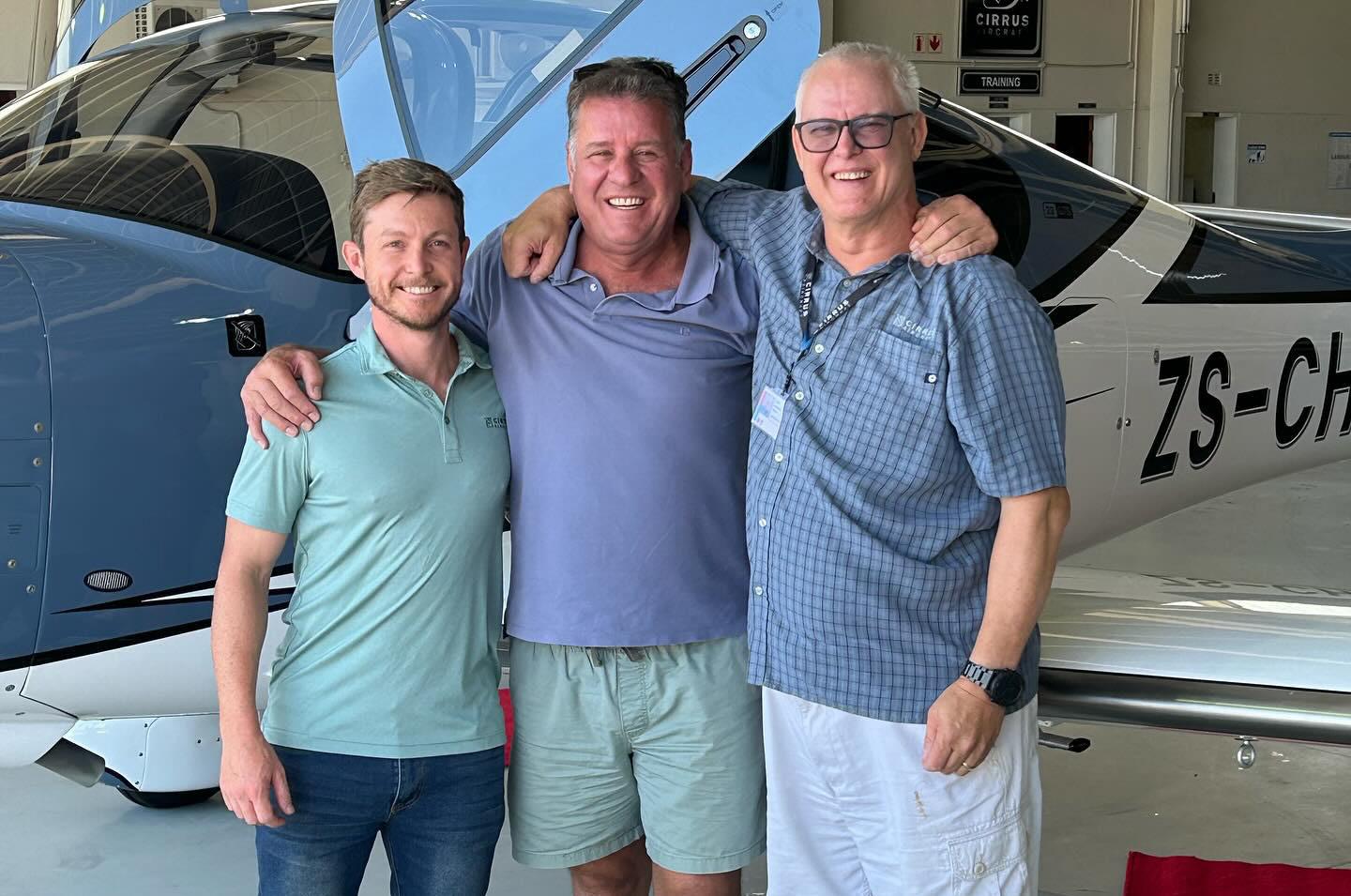


ABOVE: ZU-RUS a well known Yak 52, has been exported to New Zealand Pic Gary Shephard.
BELOW: ZS-MIA, a Cessna 210L, seen here at an air race in Mafekeng, has been exported to Guinea Bissau. Pic Bruce Perkins.

On the NTC front we have a new type: the DSJ Bushmaster 17, for which I can’t find any further details. Perhaps our readers can contact me with more information about this new aircraft type?
Other locally-manufactured types include a single Savanna S from Savannah Aircraft Africa, and a Kitplanes for Africa Bushbaby Explorer.
Turning our attention to the deletions, we see that another corporate jet leaves the ZS registry, this time an early-model Global Express, ZS-KDR (9023), being cancelled to the Isle of Man registry as M-KDRI. It is thought that the ownership remains unchanged as the registration remains almost unchanged and is therefore perhaps just a change of registration for the owner who is now believed to reside in the United Kingdom.
Other deletions include a second Cessna 172 being cancelled to Somalia; a Cessna 210 moving to the Isle of Man (M-) register, while a second Cessna 210L, ZS-MIA has moved to Guinea Bissau as J5-BAA. Two planes have also been exported to the USA –an Air Tractor AT401 and a Cessna T206H. A Cessna Caravan moves to Kenya and will no doubt join the throngs of the type engaged in tourism operations or operating for the myriad of humanitarian service providers in South Sudan and Somalia. A single Yak-52 aerobatic plane also leaves our shores for New Zealand.
Aerodrome in the UK before departing to Dubai World Central International Airport in September; but it has never visited its country of registration, nor have I seen any photos of it with its ZS registration.
It was first tracked with its new Russian registration on 26 November, routing from Moscow’s Vnukovo Airport to Abu Dhabi. Industry sources claim the jet may also have been allocated a San Marino registration before becoming ZS and then may also have had a Turkish registration before becoming RA. Clearly an attempt to mask its true country of ownership. This would not be the first time, as there are also at least three Embraer Legacy 600/650 corporate jets flying in Russia with ZS registrations, and none of these have ever been near our shores!
first G7 is expected end March.
In closing this month, I would like to point out that a few questions have been raised by our readers about the completeness of the monthly register review with specific reference to an Airlink Embraer 190, ZS-YZA (19000651), and a recently imported Citation IISP ZS-IZB (5510360).
The Citation was noted on flight tracking apps flying from Wonderboom Airport to Lanseria as ZS-IZB on 11 January and I can confirm seeing this jet wearing this registration at Lanseria ten days later, but this registration has not featured in the January updates.
A bit of an aside and one that will soon feature in the registration cancellations is the curious case of the Bombardier Global Express 6500 ZS-BPG (60014) that has taken up the Russian registration RA-73575 following some very shortlived and rapid registration changes. It was test flown with the Canadian registration C-GKAO before being delivered new as VP-CFG to an Asian client. It was subsequently sold and reregistered as ZS-BPG in the latter half of 2023. While it spent a short time at Biggin Hill
The E190 has also been in service for some time now, but has not, to date, featured on this page. We receive this information by kind co-operation from the South African Civil Aviation Authority and perhaps these were just an omission from the records, but we strive to keep this page as accurate as possible. j




We
Acoustics ( eg. CEL 350 )
Vibration ( eg. Rion VA -11)
Human Vibration ( eg. Quest Hav Pro)
Electrical DC/LF Equipment – inhouse or on site (eg. Fluke Multimeters, Insulation Testers)





Fuel Prices as at 17/11/2023
Prices include VAT but exclude any service fees

Fuel Prices as at 13/12/2023
Prices include VAT but exclude any service fees


Fuel prices may change with every new delivery. Fuel prices updated courtesy of AviationDirect – Andrea & Kelly. Fuel prices and contact details can also be found in their products: EasyPlan and EasyCockpit – https://aviationdirect.co.za/
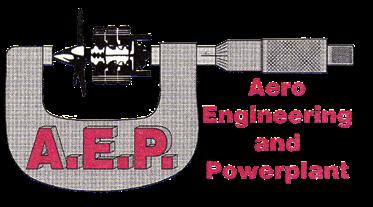


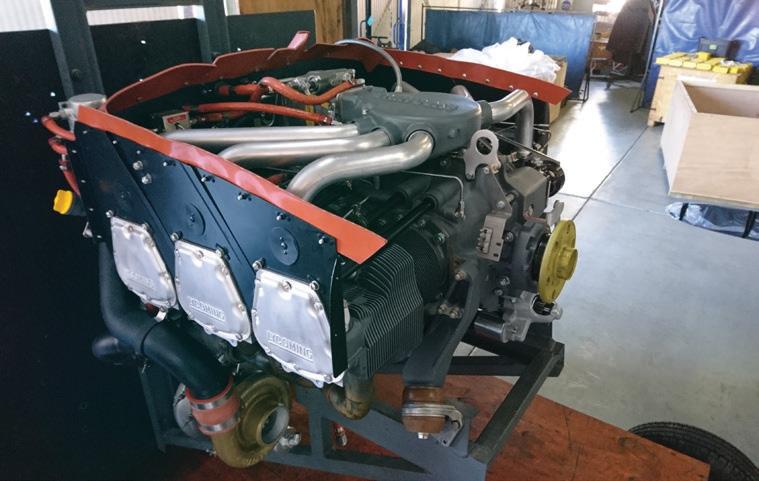
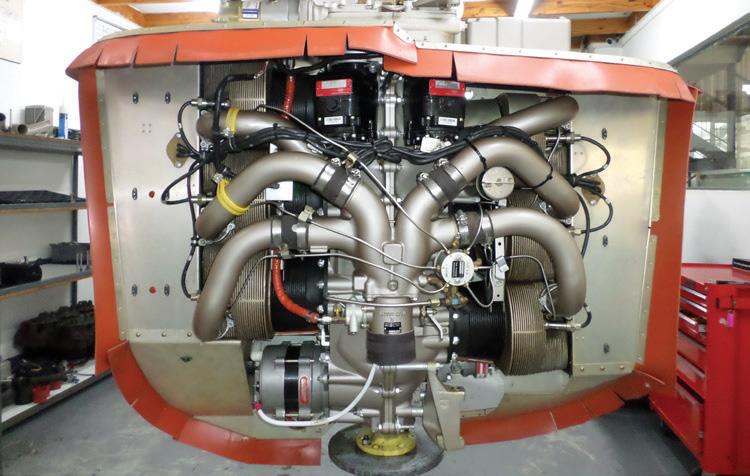


IN FEBRUARY, PIPER ANNOUNCED its toptier entry in the high-performance single world with the unveiling of the M700 Fury.
Naming it the Fury breaks with Pipers convention of naming the M-class names beginning with the letter ‘M’, viz: 350 Matrix, Malibu Mirage and the M500 Malibu Meridian.
Piper says the M700 Fury cruises at 300 knots at up to 30,000 feet and features a HALO Safety System that includes Garmin Autoland.
In performance, and now in price, it is now only marginally cheaper than the class leading Daher Socata TBM series. Base price is $4.1 million, but there are plenty of options to push that up substantially.
The M700 replaces the M600 and offers some performance improvements without going over
the 6,000-pound threshold for operation by those who fly under American BasicMed.
The 700 stands for the horsepower rating of the PT6A-52 that powers the refreshed airframe, which comes in six interior finishes. It takes off 24% shorter and climbs at 2048 fpm, 32% faster than an M600 and its 600-horsepower engine, but it also lands about 26% shorter.
“The M700 Fury is a beautifully efficient, crosscountry thoroughbred that gives our customers a performance-based flight experience with economics never seen before,” said Piper Aircraft’s president and CEO, John Calcagno.
Owner-flown and corporate markets are both in Piper’s sights for the M700. U.S. certification is planned for later this year.
j


8 to 10 March
Middleburg
Sandra Strydom
E-mail: sandra@aeroclub.org.za
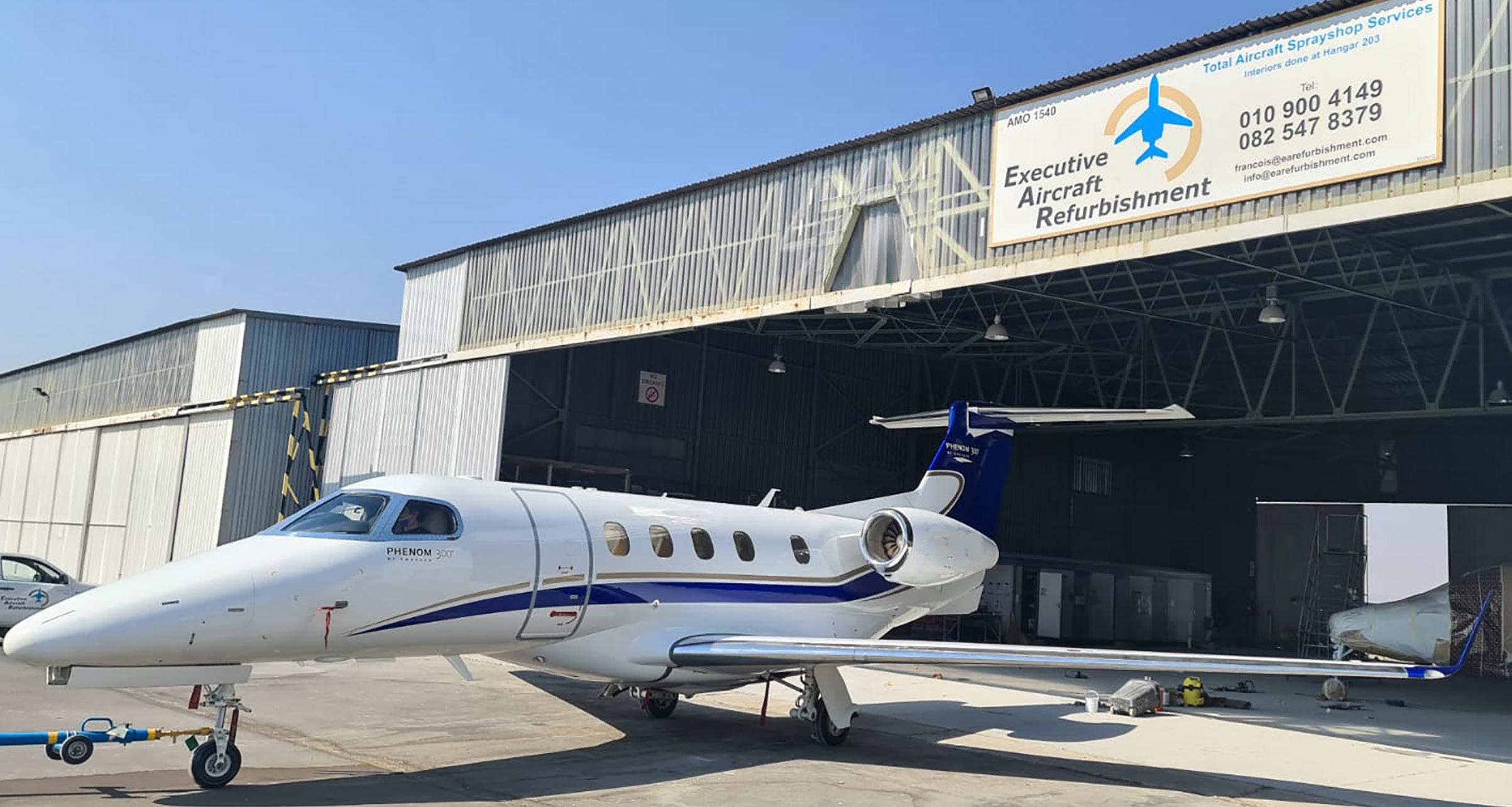
4 May
AFB Zwartkops
Major Michael Church
E-mail: mike.church172@gmail.com Cell: 072 720 0700
22 - 23 March
Stellenbosch
Anton Theart: E-mail gm@stelfly.co.za Cell: 079 873 4567

25 May
Bloemfontein
Conrad Botha
E-mail: rowco24cc@mailbox.co.za Cell 082 465 4045
8 June
Lanseria International Airport
Neil Bowden
11 May
Nelspruit
Contact: willemein.hodgkinson@kishugu.com

E-mail: airadventuresa@gmail.com
3 -5 July
Wonderboom National Airport
Website: www.aerosouthafrica.com
20 April
Wonderboom
Chris Theodosi:
E-mail: chris@creativespacemedia.co.za Cell: 071 220 1245
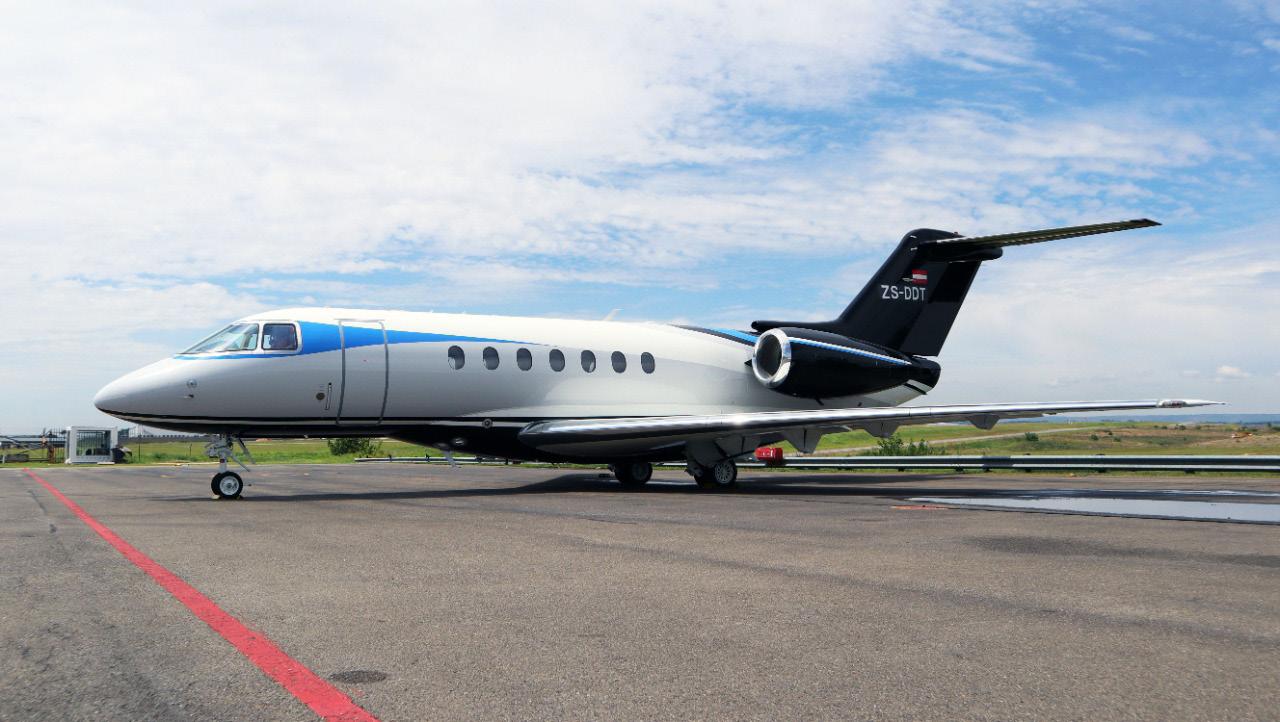
1 June
Newcastle
Johan Pieters
E-mail: Johan@champ.co.za
Cell: 082 923 0078
15 June
Maputo
Gavin Neil
E-mail: gavin@haps.co.mz

23 to 25 May
Louis Trichardt
David@pilotinsure.co.za * 073 338 5200 race@sapfa.co.za • 082 449 2531
6 - 10 June
Zimbabwe
E-mail: zimairrally@gmail.com
Website: www.zimairrally.com

22 - 28 July
Wisconsin, USA
Airfield camping contact Neil Bowden
E-mail: airadventuresa@gmail.com
28 -30 June
Warmbaths Airfield
Richard Nicholson
Richard.nicholson1963@gmail.com
Cell: 082 490 6227

27 July
Durban
Chris Theodosi
E-mail: chris@creativespacemedia.co.za
Cell: 071 220 1245
The General Aviation Manufacturers Association (GAMA) reports that new aircraft sales were up in all categories in 2023.
TOTAL FIXED-WING general aviation aircraft sales were up by 9.6%. Piston models lead the pack at an 11.8% increase compared with 2022. While the ongoing pilot shortage and its resulting focus on single-engine training aircraft no doubt played a role in overall fixed-wing sales, the fact that billings increased by 2.2% (to $23.4 billion from $22.9 billion) across the category suggests that increased sales of higher-priced business jets (up by 2.5%) indicate an improving market in that segment, as well.
Deliveries of turbine helicopters also jumped by double digit percentage points last year—up
Piston sales showed good growth in 2023.
by 10.4%. Piston rotorcraft also increased by a slightly more modest 7.7%. And in good news for the bean counters, billings increased by 11.2% to $4.4 billion from $4.0 billion.
GAMA said that more than 4,000 GA aircraft rolled off the factory floors last year. “While 2023 numbers were encouraging, GA still faces challenges from continued supply-chain issues, workforce shortages, uncertainty over the paths chosen by global regulators and “short-sighted efforts aimed at curbing business and general aviation, particularly in Europe.” GAMA CEO Bunce said.
j
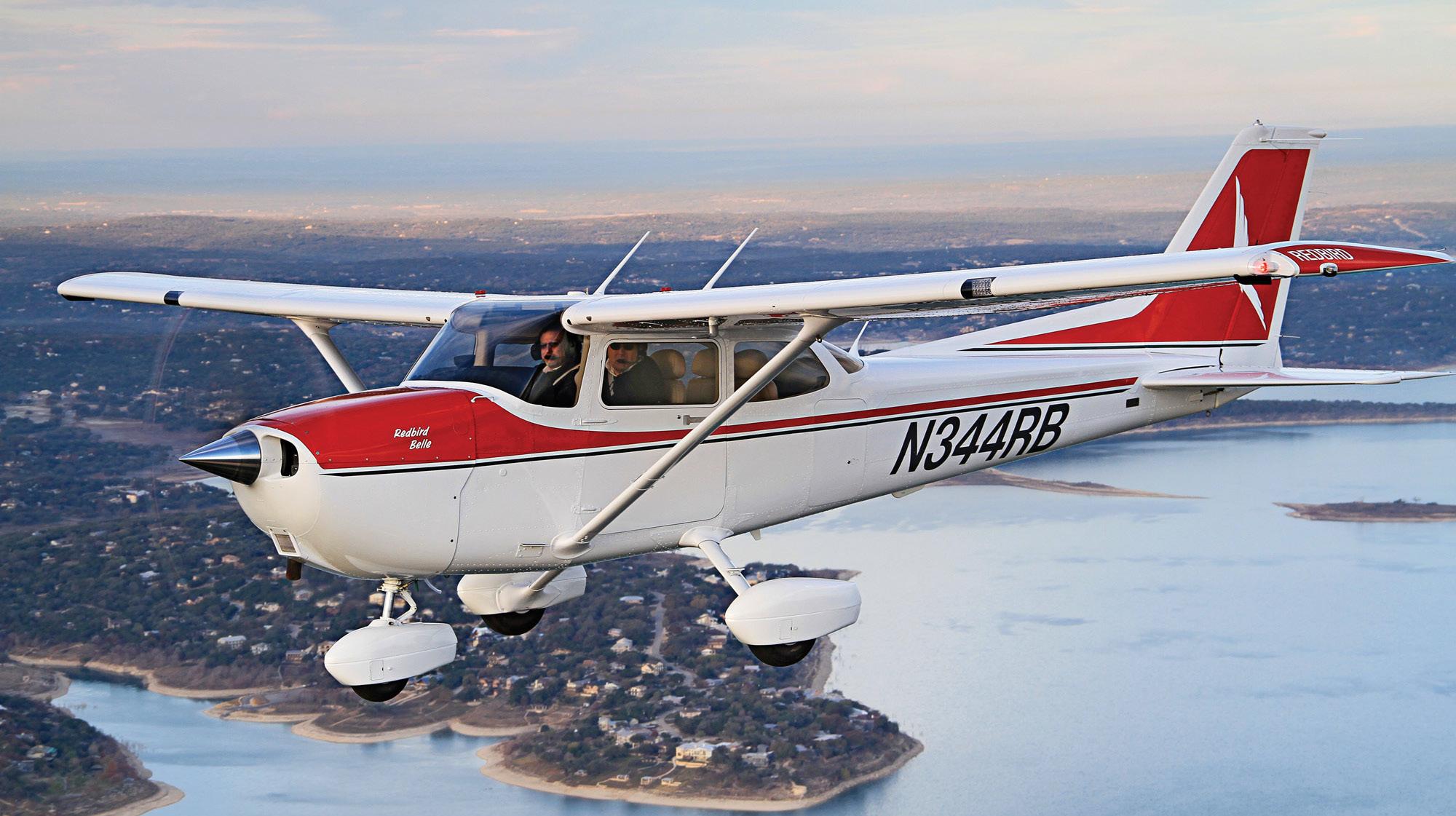
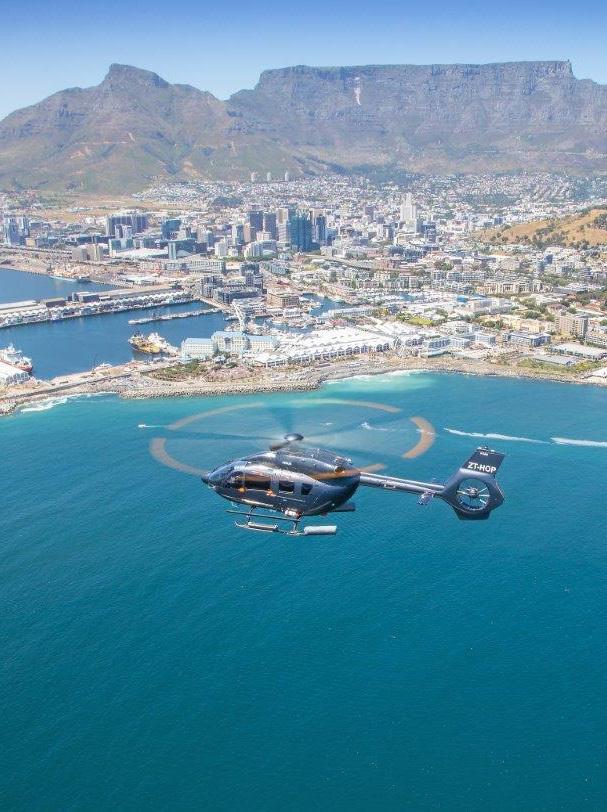

To showcase the international helicopter industry, the Helicopter Association International (HAI), , has been providing assistance to the industry for almost 75 years. The highlight is the annual HAI expo.
THE INTERNATIONAL VERTICAL AVIATION community gathered at HAI Heli-Expo 2024 in Anaheim Georgia USA, demonstrating a strong demand for sales networking and new product insights.
The show featured products and services ranging from the largest aircraft and engine manufacturers to the smaller businesses that are the backbone of the vertical aviation industry. HAI Heli-Expo 2024 provides a firsthand glimpse at vertical aviation’s biggest
players and innovators. HAI estimates that over $2 billion in business was conducted at HAI 2024. The show featured products and services ranging from the largest aircraft and engine manufacturers to the smaller businesses that are the backbone of the vertical aviation industry. Aircraft on the floor ranged from small but capable personal aircraft to some of the largest helicopters. Several companies displayed advanced air mobility (AAM) mockups, uncrewed aircraft system (UAS) models, and other emerging technologies.

More than 12,500 industry professionals from 100 countries attended the four-day show produced by Helicopter Association International (HAI). At an initial count, the show featured 645 exhibitors and 52 aircraft. HAI estimates that roughly $2 billion in business occurred at HAI Heli-Expo 2024.
The show’s key focus of education and training sessions drew large numbers of attendees, with over 2000 people attending over 100 sessions. “Workforce development are always a huge part of this show,” says Jeff Smith, chair of HAI Board of Directors. “Our Helicopter Industry Career Fair hosted more than 15 companies that were actively seeking new employees as well as several thousand job-seekers.”
The Professional Education courses provided in-depth professional development for pilots, maintenance technicians, and other aviation professionals. With a focus on supporting its small-business members, HAI again held its Communications for Small Businesses, which offered free sessions in digital marketing, social media, crisis communications, and building better relationships with elected officials.
Visitors thronged the busy aisles of the show, keen to conduct business in person. “I loved hearing exhibitors say they were so busy at their booth that they barely had time to see others on the floor,” says HAI President and CEO James A. Viola. “Everyone I talked with was enthusiastic about the excitement and level of activity at the show.”

support aerial work and tourism, while the H145s will be used in a variety of roles including air ambulance and corporate transport.
the grand scale of everything
HAI continued its strong focus on safety with the Rotor Safety Zone concept continued form 2023. The Zone featured presentations and demonstrations on a variety of safety-related topics. Visitors could also test virtual-reality simulators and meet with representatives from safetyfocused organizations to learn how to fly and work more safely.
On the first day, Airbus announced orders for up to 130 helicopters. Notably, Saudi Arabia’s The Helicopter Company (THC) signed an agreement for up to 120 helicopters over the next five to seven years. The new H125s will
HAI also offered an extensive range of free safety education sessions in its Rotor Safety Challenge, providing opportunities for everyone in the industry to learn or improve skills for safer operations.

The conferences on the sidelines of the Expo included several events focused on Advanced Air Mobility (AAM), including a three-part showcase and a forum that featured senior leaders from the organizations working to make AAM a reality.
HAI also released a Roadmap of Advanced Air Mobility Operations, a white paper describing the next steps necessary for AAM development in areas such as regulations, infrastructure and airspace use, and vehicle development.
Their impressive presence included the light single H125/H130, the H160, and the large twin H175 “oil and gas industry bus,” all of which added to their already strong order book. Additionally, Airbus’ H-Care product was a big hit with customers, providing guaranteed parts for maintenance needs.
in a range of utility roles
From all the premier helicopter manufacturers to base components, maintenance, overhaul, and crew training, everything helicopter-related was covered at the show. The immense floor layout housed 600+ exhibits and 60+ helicopters on display – with Airbus Helicopters’ stand being the most eye-catching.
American manufacturer Bell had a strong presence at the expo too, with their ever-popular B429 light twin flanked on the floor by the B407 light single and the entry-level B505.
Sikorsky’s display was also exceptional, with the large-twin, medium-lift S-92 (first unveiled at Heli Expo ’92 in Las Vegas) well-presented at its centre. Ironically, Sikorsky dominated the show, albeit not from a factory perspective, but rather with the plethora of ex-military Black Hawk helicopters present, having been converted by after-market suppliers

for work in a range of utility roles. They seem to be the natural successor to the Bell UH1 ‘Huey’ workhorse, so familiar to us in South Africa.
MD Helicopters booked orders for 12 helicopters from the Nigerian federal government, recent commercial transactions involved MD530Fs designated for multiuse missions. These civil variants included VIP aircraft for Clemens Aviation and utility aircraft for the U.S. Department of Agriculture and WCF Aerospace on behalf of Skydance Helicopters, a company that specializes in power line services.
campaign underway to meet face-to-face with our customers, suppliers, and prospects to gather first hand feedback and to continue to strengthen relationships.”
MD has instituted a variety of process improvements over the last year, according to the company. They include improving customer support, increasing investment in direct communications with customers, enhancing manufacturing efficiencies, ensuring in-stock spares availability, and maintaining healthy supplier relationships.
“This achievement is a testament to our dedicated team and the trust our customers have in us,” said Jason Lindauer, MD v-p of sales and marketing. “We have an aggressive
Mesa, Arizona-based MD Helicopters emerged from Chapter 11 bankruptcy protection in 2022 and appointed a new board of directors, CEO, and senior executives with the stated intention of rebuilding product support and gradually ramping up helicopter production.
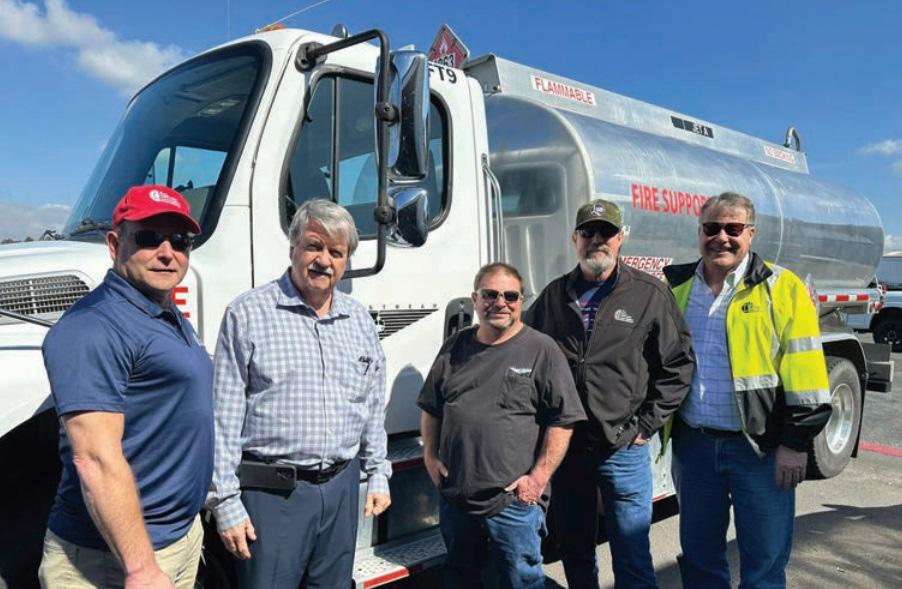
Italian manufacturer Leonardo had the largest hospitality suite, displaying the AW139 and AW169 alongside a full-scale mock-up of their latest acquisition project, the light single AW09. Initially developed by Kopter Group AG, the AW09 was later acquired by Leonardo in 2020 as a going concern. The purchase included three flying prototypes to ensure the integrity of the product.
The AW09 is a new, versatile, clean-sheet design, equipped with the reliable Safran Arriel 2k engine. Excitement was high as it is the first new light single to come out of Europe in decades – a fresh high-technology offering to the competitive market.
Unit, said that Hensoldt SA supplies IR sensors to police helicopter operations in Europe, South America and South Africa, all of which are manufactured at their Centurion HQ.
Apart from presenting the latest innovations, HAI Heli-Expo 2024 provided manufacturers with an opportunity to educate their clients and potential clients through seminars on a variety of subjects, from maintenance to flight safety.
South Africa was represented by Hensoldt displaying their military-grade mission sensors, electronic warfare, and support hardware. Bennie Steyn, senior marketer of their Optronics
The event’s smartphone app provided access to every delegate, attendee and exhibitor, allowing for the booking of seminars and the ability to organise them in a diary format with reminders. Manufacturers like Airbus, Robinson and Rolls Royce not only taught us about their products but responded to many pressing questions with honesty and integrity.
The conference portion of the show included several events focused on AAM, including a three-part AAM Showcase and a forum that featured senior leaders from the organizations working to make AAM a reality. HAI also released a Roadmap of Advanced Air Mobility Operations, a white paper describing the next steps necessary for AAM development in areas such as regulations, infrastructure and airspace use, and vehicle development.
Attendees could also test virtual-reality simulators and meet with representatives from safety-focused organizations to learn how to fly and work more safely. HAI also offered an extensive slate of free safety education sessions in its Rotor Safety Challenge, providing opportunities for everyone in the industry to learn or improve skills for safer operations.
The show’s education and training sessions also drew large numbers of attendees, with over 2000 people taking 120 courses. The Professional Education courses provided in-depth professional development for pilots, maintenance technicians, and other aviation professionals. With a focus on supporting its small-business members, HAI again held its Communications U for Small Businesses, which offered free sessions in digital marketing, social media, crisis communications, and building better relationships with elected officials.
j


Helicopter Association International (HAI) was formed seventy-five years ago. Now it has rebranded itself as Vertical Aviation International (VAI).
ANNOUNCING THE CHANGE at Heli-Expo, HAI’s annual conference –which in the future will be known as VERTICON–VAI Chair Nicole Battjes said, “Our industry has never settled for the status quo. Technology is expanding the definition of vertical capable aircraft in ways our founders could never have imagined and our association needs to expand as well. To honour our past, secure the present and embrace our future, we’re taking on a new name.”
for a broader range of members, including developers of uncrewed systems.
Founded in 1948 to promote civil rotorcraft, HAI has grown to include more than 2,500 member organizations in more than 68 nations. Although these already include several electric vertical takeoff and landing (eVTOL) developers, the association says the name change will make it more inclusive and boost its ability to advocate
“We will fuel the growth of the vertical aviation industry by connecting individuals and organizations, providing valuable education, advocating for our industry at state, federal and international levels, supporting our businesses and above all, prioritizing safety. Ultimately, we can strengthen communities globally, leveraging the power of vertical flight to make a positive impact,” she adds.
The rebranding began three years ago as part of a broad new VAI strategic plan which centres around five basic targets. The first of these –underlined by the renaming exercise – aims to better unify the vertical lift industry.


Other targets include improving advocacy to help the industry across the board on issues ranging from performance-based certification standards to the adoption of sustainable aviation fuels; better safety; improving business resources and attracting the workforce.
Describing the transition of Heli-Expo to Verticon, Battjes said, “New technologies will be unveiled that will change the world’s perception of vertical flight. The valuable education and training courses will still be there. Most importantly, there’ll be plenty of opportunities for our members to expand their network.”
Offering reassurance to the conventional rotorcraft builders and supporting companies, she said, “Helicopters remain central and integral to our mission, and they always will. However, what we define as vertical aviation is rapidly expanding. We have an opportunity to embrace uncrewed aircraft systems and an increasingly diversified fleet for the benefit of all vertical aviation. Beyond the name change, our commitment to offering the industry’s best advocacy, communication channels, safety programs, education and network opportunities remain unwavering.”
Our vision at VAI is clear and audacious: to be the world’s most vital membership association leading the evolution and expansion of vertical flight. We are resolute in shaping the future of our dynamic industry, fostering its growth, and ensuring that communities worldwide reap the benefits of vertical flight’s remarkable capabilities.
By uniting, we can amplify our voice, more effectively advocate with legislators and regulators for our unique contributions, and better serve our communities.
HAI says, “The decision to rebrand was unanimously endorsed by the Directors as part of a comprehensive long-term strategic plan approved 18 months ago. The rebranding process has been methodical, including meticulous research, member outreach, workshops, and interviews.
“This transformation encompasses more than just a name change. We are evolving into Vertical Aviation International, complete with a fresh logo, vibrant colours, and a revamped annual conference and trade show, VERTICON.”



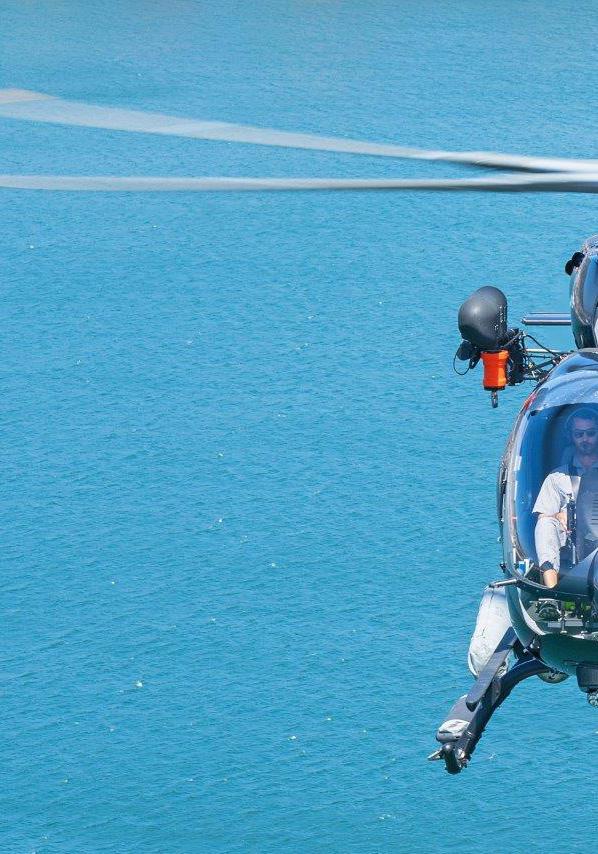
H145
– 5 BLADE: THE EVOLUTION OF THE OLD BK-117.

South Africa has had a long and happy relationship with the Airbus H145 series and its progenitors. In its MBB BK-117 form the helicopter was the mainstay of SA Police operations in the urban centres, where two engine safety was considered essential. Since then the type has undergone many improvements, to get to the current Airbus H145.
THE SUBJECT OF THIS EVALUATION is ZT-HOP, the first H145-D3 to be delivered to South Africa. It is owned by Aerios Global Aviation (AGA) the well-respected offshore helicopter operator based in Cape Town, who acquired it for ship support and many other roles.
The H145 began life in 1979 as a joint development between Messerschmitt-BölkowBlohm (MBB) and Kawasaki. Called the MBBBK 117, it was developed from the MBB Bo 105.
the blades have a unique foldable design
Despite its US10m plus price tag, the H145 is Airbus’s best-selling helicopter, notching up 186 sales in 2023. So the design is clearly one that has stood the test of time.
This helicopter pioneered the use of a revolutionary hinge-less fibreglass main rotor developed by German engineer Ludwig Bölkow. Having established a reputation for reliability and safety, during the early 1970s, MBB, along with major shareholder, Boeing Vertol, began studying options for producing an enlarged derivative of the type to grow out from the Bo 105 base.
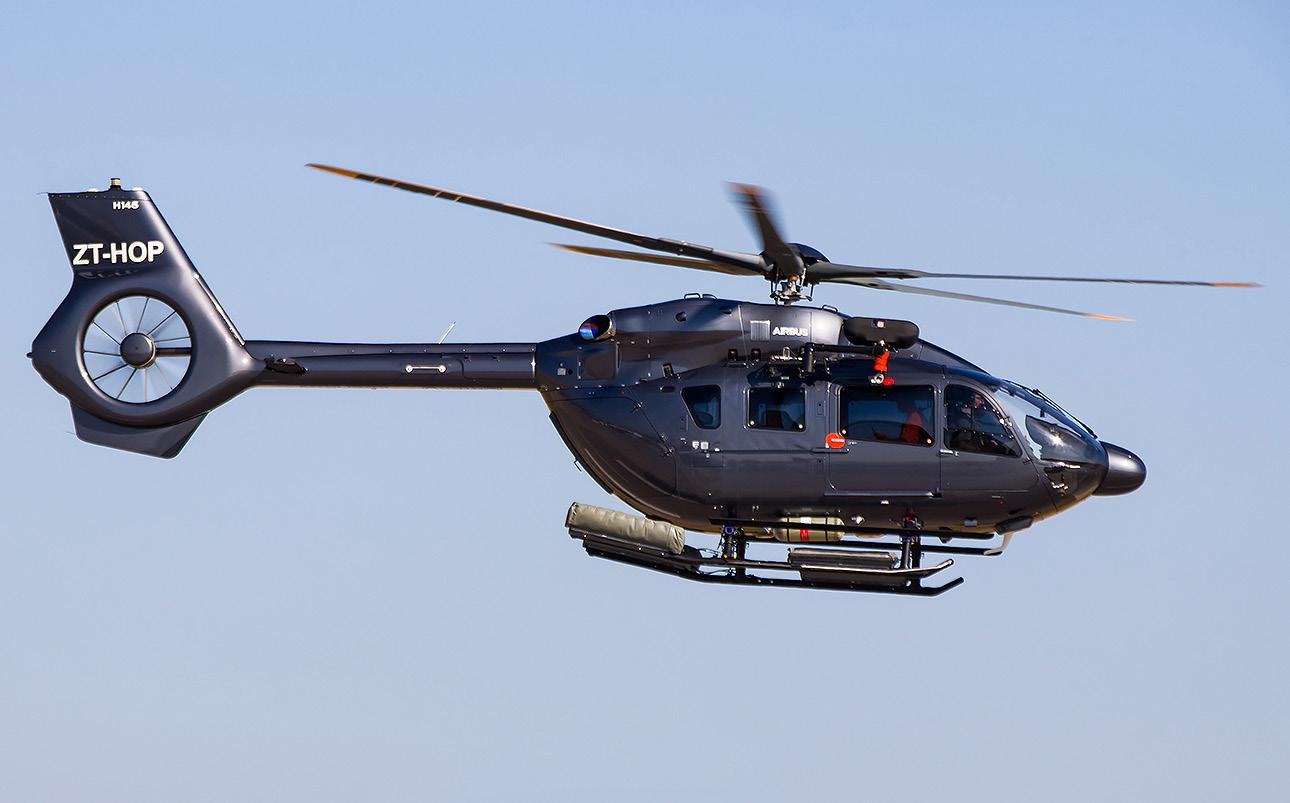
However, Boeing withdrew from the project and so MBB partnered with Kawasaki for the development of the BK-117. MBB was then acquired by Daimler-Benz and eventually became a part of Eurocopter, which in 2015, became Airbus Helicopters. With the change of ownership and branding, the helicopter’s designation changed from MBB-BK117, to EC-145C2, and now to H145, which, in recognition of its original type certificate, is certified as a BK117 D3.
MBB provided their expertise with the rigid rotor system they had gained from the earlier Bo 105 to develop the majority of the dynamic systems and flight controls, while Kawasaki focused on the airframe and structural elements. On 13 June 1979, MBB’s prototype conducted its maiden flight at Ottobrunn, Germany; while the Kawasaki prototype first flew in Japan on 10 August 1979.
In the 45 years since, the helicopter has been continuously developed – a testimony to the quality of its original design. Airbus has delivered over 1,800 helicopters from the H145 family with the worldwide fleet recording six million flight hours.
A big-step upgrade was the EC145-T2 which debuted in 2011. The most obvious external change was that the T2 replaced the earlier models conventional tail rotor with a longer tail boom and a Fenestron tail. This was particularly welcome, as it prevents people who are loading cargo or patients through the rear clamshell doors from walking into the tail rotor. The T2 also featured a more powerful version of the Turbomeca Arriel 2E engines, rated at 894 shp each.
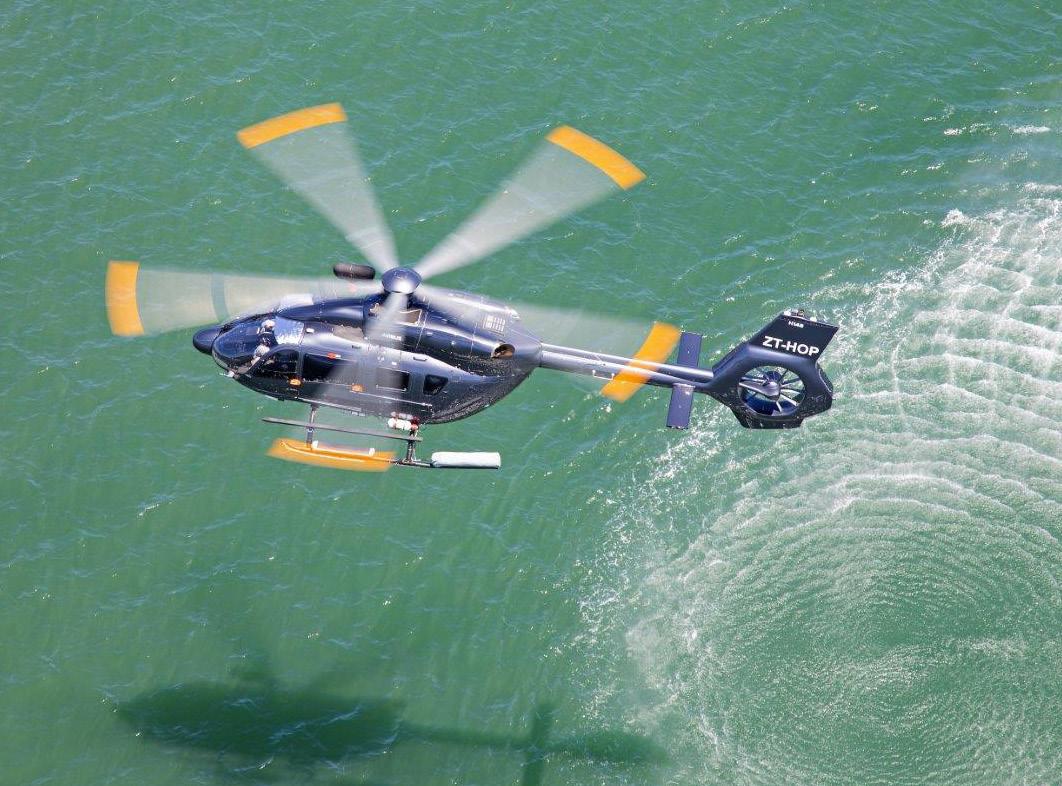
To the casual observer, it’s easy to dismiss the upgrades as small marketing changes, or even as just a name change for the sake of branding, from MBB to Eurocopter to Airbus Helicopters. The switch to a Fenestron tail rotor being considered the only noteworthy difference. But progress has been steady, and the latest H145-D3 is far removed from the early BK117.
Airbus Helicopters first showed the 5-blade H145-D3 to the public at Heli-Expo 2019. The 5-blade development builds on the company’s Bluecopter environmental demonstrator, combining the performance of the additional blade with weight reductions to provide a remarkable 150kg useful load increase. Airbus achieved the aircraft’s increase in useful load by reducing its empty weight by 110 lb. (50 kg) and increasing its max takeoff weight from 8,160 lb. to 8,380 lb. (3,700 kg to 3,800 kg). At HAI 2019, Airbus pointed out that the useful load is almost the same as its empty weight.
The H-145’s new bearingless main rotor system features a fully composite flex-beam and main rotor blades, doing away with a main rotor system design that had been used on previous generations of the H145, BK117, and Bo.105. It dispenses with the main rotor head entirely, and the accompanying oil and grease needed to lubricate it.
In addition to providing increased lift with the latest airfoil design and material technologies, the blades have a unique foldable design that provides storage and potential cost replacement benefits.
For owners of the earlier 4-blade helicopter, there is an upgrade option through a retrofit. However, earlier versions without a Fenestron tail rotor are not eligible for the retrofit.

Visibilty forward and to the sides is excellent.

On the ramp the helicopter is both substantial yet compact. The large slab sided fuselage gives a main rotor height of well over 2 metres, almost eliminating the chances of a main rotor strike.
The cabin can accommodate a 2-crew cockpit plus 10 passengers in a highdensity arrangement or a spacious medivac configuration.
Thanks to its cabin size – versatility and load carrying capability, Airbus markets the H145 as being a utility helicopter capable of performing a number of different missions, including aerial work, HEMS, energy support—offshore wind energy, as well as both offshore and onshore cargo and passenger transportation— law enforcement and private and business transportation. Aerios Global Aviation CEO, Malcolm Pitcher says , "The H145 is the best utility helicopter. It takes just 20 minutes to change it from VIP, to HEMS, to a cargo transporter. This means that having just one helicopter is often all you need as it does the job
of many different helicopters." It has also gained a niche following as an aerial tender for super yachts. You can order an H145 with a 6-place cabin worthy of carrying billionaires to floating pleasure palaces.
All the MBB-BK117 to H145 variants are powered by two Safran Arriel engines (formerly Turbomeca). The Arriel 1E2 engine is used on the C-2 and C-2e, and the Arriel 2E for the D-2 and D-3. On the H145, the engines have an upgraded takeoff power of 894 shp each.
Both the C-2 and C-2e were certified to the same 7,900-lb maximum weight. That was increased to 8,378 lb for the D-2 and D-3. However, the 8,157-lb and 8,378-lb maximum weights for the D-2 are described in the EASA type certificate data sheet (TCDS) as being alternative maximum weights, with the maximum weight of that variant without modification being 8,047 lb.
H145 airframes based on the D-2 and D-3 variants increase the usable fuel capacity in standard tanks to 239 USG. Airbus says that the H145’s maximum weight is the same regardless
of whether or not it is carrying an external load, with a total useful load of 4,200 lb.
Apart from increasing the useful load and reducing complexity and thus maintenance, the five-bladed H145 was designed to substantially improve the ride quality and performance of the legacy BK117 rotor system, which was considered by many to have high vibration levels, particularly for aeromed applications. The 5-blade hub mounts the blades directly to the mast, making the system simpler, lighter, and easier to maintain than the original rotor mast head.
The switch to the 5-blade head involved modifying the forward crosstube and horizontal stabilizer to minimise dynamic reactions on the airframe. Also, Airbus removed light anti-vibration absorbers, and installed an electrohydraulic actuator
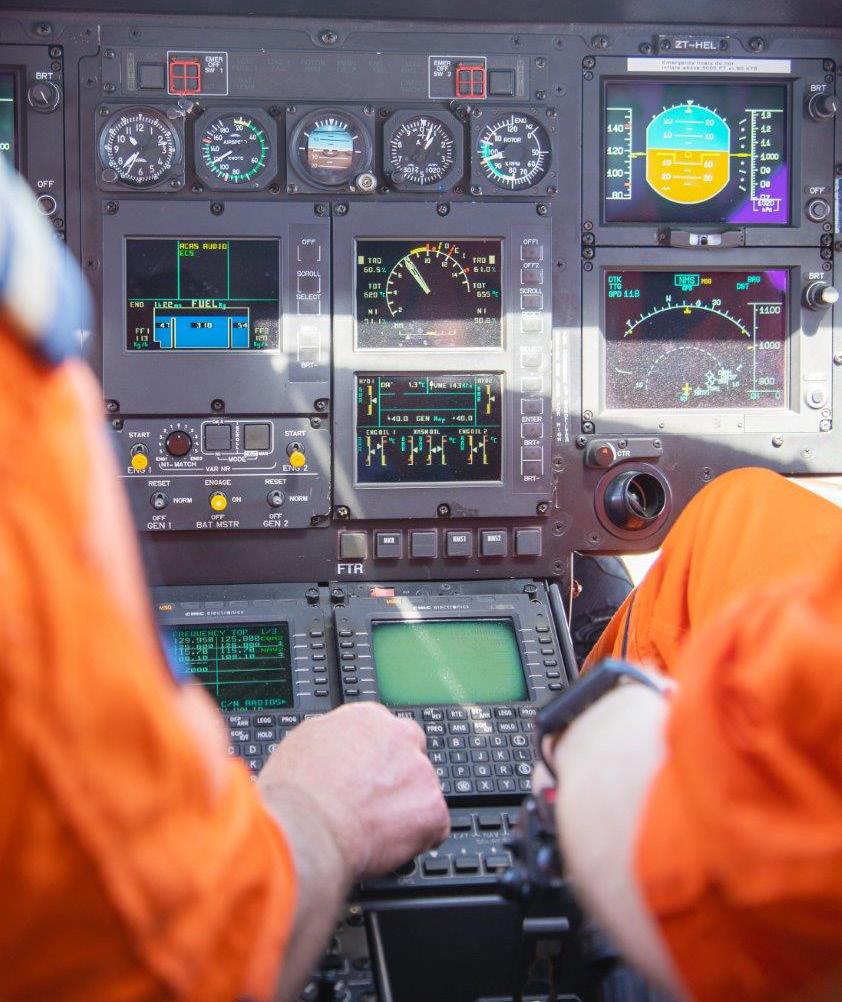

to help the pilot check the freedom of controls on the ground when the engine is off.
The blades incorporate the latest aerofoil design to produce more thrust than previous aerofoil sections for the same power. While five blades have more drag than four blades, improvements to the aerodynamics of the rotor cuff of the blade have enabled the H145’s blades to generate more lift.
The blades can be folded backwards, simplifying storage. With the removal of just one of the bolts the blade can be rotated backwards to within the wingspan of the horizontal stabilizer. The whole process takes just 10 minutes.
Thanks to the folding blades, which allows all five to be turned rearwards to run in the direction of the tail boom, the aircraft’s potential footprint and storage requirements have been minimized.

H145 flexible cabin configurations.
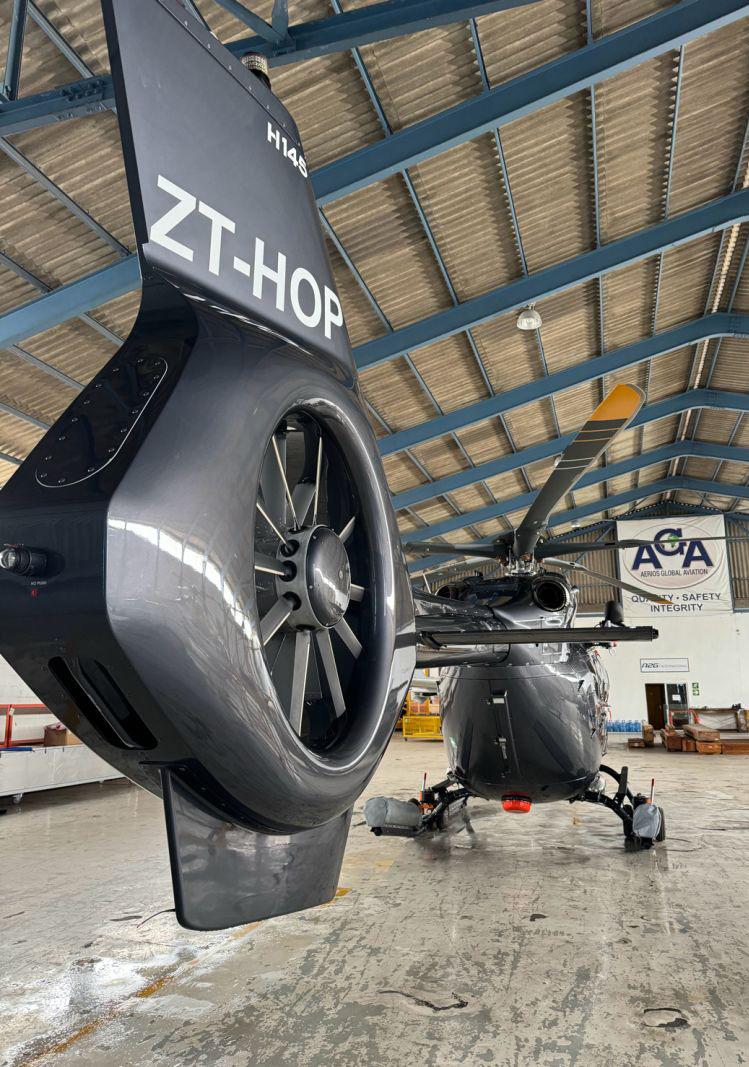
The new blades have slightly changed the dimensions of the aircraft — it is now 10 cm taller and 10 cm shorter from the tip of the blade to the rear of the Fenestron. The diameter of the rotor disc has decreased slightly, from 11 metres to 10.8 metres.
Each blade is made of two parts: a metrelong ‘control cuff’ at the base of the blade that attaches to the mast, and the remainder of the blade, which attaches to the cuff through the two bolts. The cuff contains a composite flex beam — and it’s this that replaces all the bearings seen in a traditional main rotor hub.
In addition to allowing the blades to fold, having the flex beam situated in a separate control cuff provides for potential cost savings if a blade is damaged. So if for example a blade hits the wall of the hangar, then only the outer blade needs replacing and this is much less expensive.
system has no rotor head and requires no oil or grease and little maintenance.
The blades have no life limit, with replacement determined on condition.
produce more thrust than previous
Although the maximum passenger seating capacity that is certified for all MBB-BK117 variants marketed as the EC145 and H145 is nine, MBB-BK117 C-2 airframes are able to carry 10 passengers if certain modifications are completed. According to Airbus Helicopters, possible configurations of the H145’s cabin include an eight-passenger layout—which features both forward and aft-facing seats, and is promoted as being ideal for offshore operations and passenger transport.
Aside from its light weight and easy stowage, the new rotor system has many advantages over the legacy design which featured a maintenance-hungry titanium, oil-filled main rotor head with bearings. The new bearing-free
H145 has particulary good ceiling - here on the highest point of the Andes.
For law enforcement and military applications, the cabin can accommodate 10 or 11 personnel—in addition to 1 or 2 pilots—while one of the possible layouts for helicopter

emergency medical services (HEMS) operators can carry a pair of stretchers, 1 or 2 pilots and as many as three medical personnel.
All variants of the MBB-BK117 are certified for single-pilot operations, with the pilot flying from the right front seat.
Inside the cockpit, the H145 features Airbus Helicopters’ in-house-developed Helionix avionics suite that is promoted as improving the pilot’s situational awareness.
The H145 includes the installation of Airbus’s Wireless Airborne Communication System, which allows navigation and mission database information to be imported from a tablet and has the capability for cockpit Wi-Fi. On the ground, it can automatically export flight data and generate flight reports.
Apart from the 5-blade rotor, the H145 D2 to D3 upgrade addressed many of the user feedback
requests. These included improvements to the air conditioning, increased mast moment limits, some minor autopilot adjustments and automatic flight control system tweaks to address yaw oscillations while on steep approaches descending through ETL, and the addition of an auxiliary hydraulic pump for the flight control check.
While the five-bladed H145 D3 is a progressive improvement to the type, pilot reports note that, when combined with the large advances made with the D2, it improves the whole package and puts the aircraft in a class of its own.
As a medium-sized twin engine Single Pilot IFR (SPIFR), approved helicopter, a key objective was to reduce pilot workload. For single-pilot instrument flight rules making those operations not only safer, but exponentially more feasible for pilots with minimal actual instrument time making the transition to an IFR operator.


The engines are full authority digital engine control (FADEC) controlled, with a quick start procedure.
Standard Avionics include two Garmin GTN 750 touchscreen flight navigators, synthetic vision, better visibility, Helionix multi-function displays, and four-axis autopilot, not to mention the vastly increased performance and range. The H145’s maximum endurance and range—both of which are based on standard fuel tanks and sealevel altitude—are 3 hr. 34 min. and 351 nm, respectively.
The operating limitations of the H145 include a Vne of 150 kt, with a recommended cruise speed of 129 kt. The certified maximum operating altitude is 20,000 ft.
Given that a key objective in the 5-blade upgrade was a reduction in vibration, it is relevant to note that while some vibration is still evident, particularly when passing through effective translational lift (ETL), vibration levels are dramatically reduced and mostly noticeable only when actively focusing on them. Pilot reports say, “If it’s not outright the smoothest helicopter I’ve flown, it’s certainly close.”
With the improved performance of the fivebladed H145 D3, any concerns about power go from being rare, to almost a non-factor for all but high-altitude mountain operations. Even there, the H145 D3 is capable of operating in many areas that were previously only accessible in high-performance single-engine helicopters such as the Squirrel AS350 B3, which landed
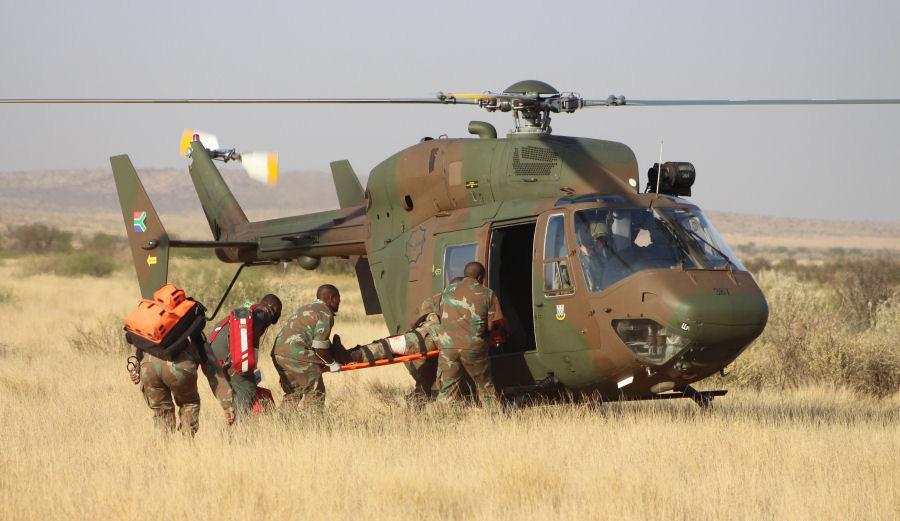
on the top of Mt Everest (8850 metres). The H145 has been similarly tested, but just in the southern hemisphere, in the Andes, having landed on Aconcagua, at an altitude of 22,840 feet (6961m), setting an altitude record for twinengine helicopters.
It maintains single-engine out of ground effect (OGE) hover capabilities throughout a substantial portion of the flight, leaving a good safety margins.
Training for engine failures in varying flight regimes is made easy using the ‘training button’ which creates an accurate simulation of a singleengine failure. At all but the highest of gross weights in an OGE hover, this is very much a non-event, and pilots report that “even then, it’s much less of an emotional moment than in many other twins. As someone who regularly conducts rooftop helipad operations in heavily congested metropolitan areas with limited escapes, this type of performance is comforting, to say the least.”
While the continuous development has improved the already impressive MBB / BK117 base, they
have not made much difference to the cruise speed. The H145 is still most comfortable with a cruise of 120 knots. Maximum range with no passengers is 351 nm and with full seats is 260 nm.
The H145 is a U$10 million helicopter and as such unfortunately it often challenges the limited budget of South African helicopter employers. For this reason, it finds limited use in South Africa, apart from its role in supporting offshore shipping, for which its twin engine, single pilot, IFR capability and compact size make it ideal.
While the five-bladed H145-D3 is a progressive improvement, when considered with the drastic advances made with the D2, it brings together the whole package and puts the aircraft into a class of its own. It may be a descendant of the venerable BK-117, but its performance, safety, and capabilities have improved so much that it will become increasingly difficult for operators to justify keeping the older models. j


Crew: 2
Capacity: 10 pax / 1,793 kg (3,953 lb) payload
Length: 13.03 m (42 ft 9 in)
Height: 3.45 m (11 ft 4 in)
Empty weight: 1,792 kg (3,951 lb)
Gross weight: 3,585 kg (7,904 lb)
Fuel capacity: 723.0 kg (1,593.9 lb)
Powerplant: 2 × Turbomeca Arriel 1E2 turboshaft
Power: 550 kW (740 hp) each for take-off
Main rotor diam: 11 m (36 ft 1 in)
Main rotor area: 95 m2 (1,020 sq ft) root:
Blade profile: NACA 23012; tip: NACA 23010
Cruise speed: 246 km/h (153 mph, 133 kn)
Vne: 268 km/h (167 mph, 145 kn)
Range: 680 km (420 mi, 370 nmi)
Ferry range: 855 km (531 mi, 462 nmi)
Service ceiling: 5,240 m (17,190 ft)
Rate of climb: 8.1 m/s (1,590 ft/min)


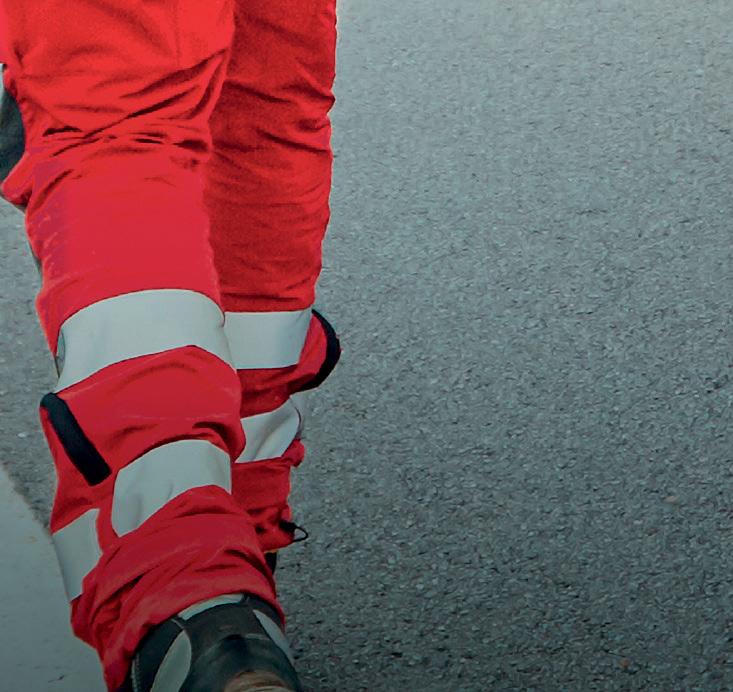

Seconds count when lives are on the line. It’s why every feature of the Airbus H135 has been designed for safe, effective, and fast operations. With easy patient loading, state-of-the-art avionics to reduce pilot workload and a safer working area on the ground, the H135 ensures people get the medical care they need as fast as possible. All of this has made the H135 the emergency medical services market leader around the globe – helping people every single day and making sure the world remains a beautiful place.












The Armaments Corporation of South Africa SOC Limited (Armscor) is an acquisition agency for the South African Department of Defence (DOD), and other organs of state and entities. Armscor's mandate is to provide the armed forces with state-of-the-art defence matériel, delivering innovative defence solutions efficiently and effectively. The organisation manages the strategic capabilities of the DOD, producing research and vanguard technological solutions required to provide safety and security for South Africa, its citizens and the continent.
Armscor has a proven track record of delivering on its mandate. It has extensive experience in product development, technology development, enhancement, sustainment and disposal of products. The organisation has world-class facilities that can be used by both local and international clients to test and evaluate the performance of their defence and security related products. Armscor prides itself on maintaining high-quality international standards through rigorous testing and evaluation processes on all its technology management projects.
Over the years Armscor has saw its technologies evolving from the defence sector to both commercial and domestic sectors. It has capabilities and skills to meet the needs of the changing global landscape.
One of Armscor’s core businesses is acquisition. Its key functions include requirements analysis, technology development, design and development of products and product systems, the industrialisation and manufacturing of mature products and product systems that fully meet user requirements. It also entails procurement of existing and qualified products, as well as

the acquisition of product system support for user systems during the operational lifetime of the systems. The organisation has capability to perform independent, centralised coordination of the acquisition function; and play a management role in technology acquisition and technology commercialisation undertakings.
Through its Aero Systems Division, Armscor plays a key role in providing the South African Air Force with the necessary equipment and support required for mission readiness, which includes but not limited to conducting humanitarian operations in countries such as Mozambique. Armscor provides cost-effective and safe provision of aircraft product systems and logistic support that creates defence capability.
Aero systems capabilities offered at Armscor include:
• Contract and project management expertise
• Providing maintenance and storage management
• Holistic over view of the life cycle of equipment
• Technical (systems and logistic engineering) expertise
For more information contact:
Corporate Communication Division
370 Nossob Street, Erasmuskloof X4, Pretoria, Republic of South Africa
Tel: +27 (0) 12 428 1911
E-mail: info@armscor.co.za
www.armscor.co.za j

In a survey conducted in late 2023, global investors reckon the first commercial passenger electric Vertical Takeoff and Landing (eVTOL) aircraft will be operational “in the next few years.”
THE FUTURE AIR MOBILITY MARKET continues to advance rapidly, according to research from New Horizon Aircraft Ltd. The survey included 200 senior private equity, venture capital and family office professionals representing institutions with more than $1.787 trillion assets under management to capture their views on their eVTOL market.
Its global study reveals increasing optimism about the Urban Air Mobility (UAM) market with two in five (40%) investors stating they think the first commercial UAM routes will be operational by 2026, and 11% believing that the first commercial flights could be as early as 2025.
world, combined with the need to reduce the environmental impact caused by more vehicles on the road and advances in technology improving the safety and viability of eVTOLs, will drive improvements in the regulatory framework for the market over the next five years and ultimately fuel substantial new investment into the sector.
Only 1% of investors did not agree that overcoming any potential obstacles would inevitably see increased investment in the eVTOL market. Three percent were unsure.
Only 4% of professional investors believe the debut date for commercial passenger routes will extend beyond 2030.
New Horizon says that the anticipated progress in the eVTOL market and investors’ confidence to set ambitious timelines for the successful integration of small, highly automated aircraft in urban airspace requires careful navigation of a complex regulatory landscape, overcoming technological hurdles and the need to address any public concern over safety.
The global study reveals that nearly all (96%) professional investors agree that the growing demand for better and more efficient transportation systems across the
The main factors concerning the eVTOL market that will need regulation highlighted by professional investors are Information and Communications Networks followed by Air Traffic Control and Security.
Table showing key areas for regulation, in order of those deemed by investors as the most important to regulate first:

7 Environmental impact
8 Detect and avoid capability
Horizon is targeting the future production of a manned seven-seat capacity hybrid electric eVTOL called the Cavorite X7 which includes room for a pilot and six passengers. It has been developed in response to demand from potential customers in the medevac, business aviation and commercial cargo sectors.
Brandon Robinson, CEO of Horizon Aircraft, said: “Private equity, venture capital and family office investors have been closely monitoring the future air mobility sector for some time, but are now seeing an acceleration towards the launch of the first commercial eVTOL passenger routes. The sector has already attracted significant investment, and we anticipate that this will only increase as ongoing developments in technology and regulation will provide new investment opportunities in an emerging market that has the potential to revolutionise urban transportation.”
Its Cavorite X7 aircraft will have a gross weight of an estimated 5,500 lbs with a projected useful load of 1,500 lbs. With an estimated maximum speed of 250 miles per hour and an average range of over 500 miles with fuel reserves, Horizon believes that this experimental aircraft, if eventually licensed for commercial use, would be well-positioned to excel in medical evacuation, critical supply delivery, disaster
relief, and special military missions. The Company believes that the proposed aircraft would also be attractive for Regional Air Mobility – moving people and cargo 50 to 500 miles.
Unlike many in its category, the Cavorite X7 is being designed with a hybrid electric power system. The Company is designing the Cavorite X7 such that it could, after its vertical takeoff, re-charge its batteries enroute when it is flying in a configuration like a traditional aircraft. After a vertical landing and completion of a mission, the Company is designing the Cavorite X7 to recharge its battery array in under 30 minutes to be ready for its next mission.
Horizon believes that its innovative approach and technology will allow the Cavorite X7 to fly 98% of its mission in a very low-drag configuration like a traditional aircraft. The Company believes that flying most of the time as a normal aircraft is also safer and will make the aircraft easier to certify than other radical new eVTOL designs.
The Cavorite X7 will be powered by a hybrid electric system that will recharge the battery array in-flight and post-flight, while also providing significant system redundancy. The Company is continuing the testing of its 50%-scale aircraft that it believes will reduce technical risk moving forward as it continues to develop its full-scale aircraft.
j












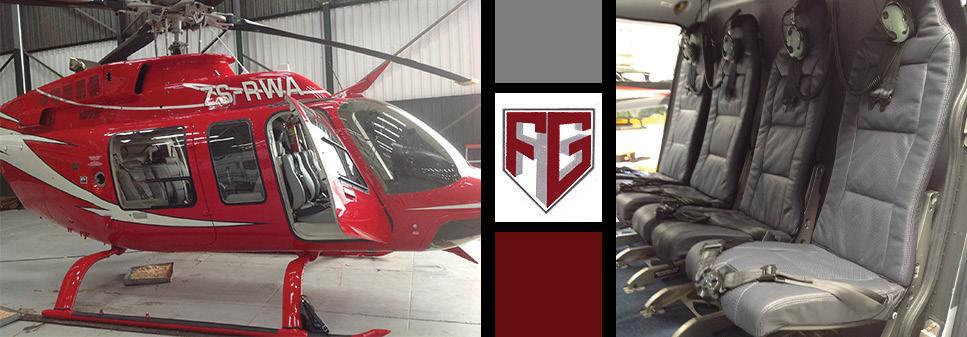

Landline:
011 614 2471
Mr. Gomes:
082 412 6669
Carla:
083 602 5658

A
team to meet all your requirements.
Refurbish your aircraft and / or helicopter. Best prices guaranteed

One of the spin-offs of installing modern multi function flat panel displays for older helicopters with legacy ‘big round gauges’ is that it has become possible to install state of the art autopilots.
PREVIOUSLY, AUTOPILOTS were considered an expensive and complex luxury for smaller helicopters such as the EC-130 or Airbus H125.
Now, with the availability of Garmin’s latest G500H ‘glass panel’ multifunction displays, it has become feasible and cost effective to install the Garmin GFC-600H helicopter autopilot. This not only reduces the pilot workload, and so enhances safety, but it means that the pilot can concentrate on tasks other than just hand-flying the helicopter and thus has a large pay-off in improved situational awareness.
Century Avionics handled the installation of the autopilot in an EC-130 and reports that the Garmin GFC-600H has surpassed the customer’s expectations. The first test flight proved the installation to be immediately 100% functional and the pilot interface is ergonomically excellent.
feasible and cost effective
The GFC-600H is a 2 or 3-axis autopilot with a self-contained digital controller-attitude based computer with advanced AHRS technology and cross-checking sensors for improved stability and responsiveness. A yaw axis servo supplements tail rotor pedal input by the pilot to help maintain heading and keep the helicopter in smooth, coordinated flight.
The test pilot noted that this GFC-600H installation compares very favourably to the functionality and performance that you find on the much larger dual autopilot helicopters.
The GFC-600H has safety features such as attitude hold with speed stability, overspeed and low speed protection, a dedicated return-to-level (LVL) mode, Helicopter Electronic Stability and Protection (Garmin H-ESP™ technology) and hover assist.
The return-to-level mode (LVL) feature is an acknowledged game changer and key safety tool.

As a top-level feature, GFC-600H includes stability augmentation inputs to help stabilise the helicopter. The subtle corrections provided by SAS serve to improve the helicopter’s basic handling characteristics by maintaining a commanded attitude. In addition, when the system detects that you’re hovering, the innovative hover assist feature will automatically provide flight control inputs to help maintain that position over the ground. It will also hold heading in hover when equipped with the available yaw axis control.
With the phasing out of the well-loved Garmin GNS-430 series, the GTN-750H, GTN-650H, are in steady demand. Other popular options which Century Avionics has expertise in include the GNC-255, Audio panels such as the GMA350H, and crucially for pending legislation requirements, ADSB in/out transponders such as the GTX-345 and the Passive Traffic system, the GTS-800
Over the years Century Avionics has had developed a great depth of experience in helicopter upgrades, on models which include: the EC-130 and Airbus H125, Enstrom 680, Bell 206 and 407, and even the venerable Bell UH-1.
The most popular avionics upgrades include the now industry-standard Garmin Flight and Multifunction displays G500H. Popular options includes electronic standby instruments such as the Garmin GI-275 or Mid-Continent SAM MD-302.
In addition to the GFC 600H autopilot, there are also helicopter autopilot and stability augmentation systems such as the Genesys HeliSAS.
Century Avionics in-house design organisation and designated approved representative (DAR) is able to compile, review and approve the documentation for the required supplemental type certificates and Minor modifications, making light work of the certification and approval process.









Century Avionics Helicopter upgrades -
Century Avionics has had the priviledge to upgrade a number of Airbus EC-130’s, Airbus H125’s, Enstrom 680’s, Bell 206’s, Bell 407’s and UH-1 with a wide variety of Avionics over the years.
These included Garmin Flight and Multifunction displays ie G500H, Electronic Standby Instruments ie Garmin GI-275 or Mid-Continent SAM MD-302, Garmin Navigators ie GTN-750H, GTN-650H, GNC-255, Audio panels ie GMA-350H, ADSB in/out transponders ie GTX-345, Passive Traffic system ie GTS-800 and Helicopter Autopilot and Stability Augmentation systems ie Garmin GFC-600H or Genesys HeliSAS to name a few.
The most recent Autopilot we installed, the Garmin GFC-600H, pictured in the H125 here above, satisfied the customers requirements beyond all expectation. The first test flight proved the installation to be 100% functional and the pilot interface ergonomically well appointed. The testpilot mentioned that this GFC-600H compares very well to the functionality and performance that you find on the Dual Autopilot Helicopters. The return-to-level mode (LVL) feature is a game changer.
The GFC-600H is STC’d from Garmin as well as Airbus for the successful interface to the Garmin Avionics suite.
The GFC-600H is a 2- or 3 axis autopilot with a self-contained Digital Controller-Attitude basedComputer with advanced AHRS technology and cross-checking sersors bringing safety enhancements, superior stability and efficiency.
The GFC-600H has safety features such as attitude hold with speed stability, overspeed and low speed protection, a dedicated return-to-level (LVL) mode, Helicopter Electronic Stability and Protection (Garmin H-ESP™ technology) and hover assist.
Available yaw axis servo supplements tail rotor pedal input by the pilot to help maintain heading and keep the helicopter in smooth, coordinated flight.
Our in-house Design Organisation and Designated Approved Representative (DAR) compile, review and approve the documentation for the embodied STC’s and Minor modifications making light work of the certification process.
A small feather in the cap for the engineers on the first GFC-600H retrofit for Century Avionics, a well-deserved compliment to our thorough and highly experienced team!





Much was hoped for from SAA Version 2. The government made promises about no more bailouts, including no guarantees for debt and aircraft leases. Yet Minister Pravin Gordhan has now been given a further R1 billion for SAA – for “business rescue purposes.”
THE MAGIC BULLET FOR SAA was supposed to be the sale of a majority shareholding to the Takatso Consortium. This was supposed to provide the capital and skills to run the airline without yet more taxpayer money.
It is increasingly likely that the Takatso deal will never happen. In June it will be three years since the deal was announced and we are still waiting for the SAA Act of Parliament to be repealed. In his latest delaying tactic, Gordhan has withdrawn the SAA Bill from Parliament – so yet again the Takatso deal stalls.
are 20% more efficient and have far better in-flight entertainment.
Under Business Rescue, the headcount was slashed from 5000 to just 1000, and at first the new streamlined and debt-free company made taxpayers happy by claiming that it had made a profit and was cash positive.
it was short lived honeymoon
Only once the SAA Act is replaced, will government start the time-consuming process of applying for amended operating licences. If government was genuinely committed to selling off the airline, these steps would have been completed years ago – while it was grinding through the Competition Commission and Tribunal.
There are also unanswered questions about where Takatso will get the promised R3 billion from – and even whether it promised the funds at all.
Without Takatso, or government guarantees and subsidies, the airline remains undercapitalised, underskilled and uncompetitive. It cannot lease, or buy, new cost-efficient airliners for its long-haul routes. Instead, it relies on an obsolete 25-year-old Airbus A340 to compete against modern twin-engine airliners which
But it was a short lived honeymoon. For 2022 the airline produced a R122 million loss – and that was on a paltry R3.6 billion revenue, just 14% of pre-Covid levels. By 2023 the world’s airline industry had recovered to 95% of its pre-Covid levels, yet SAA remained the dunce of the class – and an embarrassment to all South Africans, apart from the tone-deaf government. For the 2023 financial year, the SAA Group loss had swollen to R761m, which was not as bad as it might have been without the quiet star of the show; SAA Technical, and a miraculous contribution from the defunct Mango Airlines. In 2024 SAA has reported a loss of R776m for just 9 months, and thus a probable loss of R1 billion for the year.
The government is deceiving its taxpayers. From its delaying tactics, it can only be concluded that it has no intention of completing the Takatso deal. And so SAA will continue to struggle along, with obsolete aircraft, and unable to attract quality management. The losses will continue. Pravin’s promises are meaningless.

Last month Hugh described the over-zealous application of stop cards. Here is Hugh’s reply:
OFFICIAL
Report on Stop Card ref 174/11/01
Raised on 9th-November-2002
Raised by Anon
On 9th-November-2001, a Stop Card was raised against the flight crew of the De Havilland DHC-6, which is currently on contract to the Company.
This expressed the concern of one of the aircraft’s passengers about the apparent practice of landing with the right main wheel touching down first. This he considered to be unsafe and he recommended that the airline procedure of ‘bringing all the landing gears into contact with the runway at the same time’ be adopted, in order to prevent an accident which might endanger the lives of the passengers who are compelled to use this form of transport.
Firstly, readers of this report should get one thing absolutely clear in their minds, before anything else is discussed. No modern airliner, with a tricycle undercarriage configuration, lands with all the wheels touching the ground at the same time. A large aircraft landing in that flight attitude would almost certainly require a ‘Hard Landing Inspection’, at the very least, after carrying out such an arrival. It is true to say that there are some specialised aircraft which do touch down with all wheels concurrently. One is a heavy bomber and the others are freighters designed for very specific requirements. None of them carry passengers.
In order to explain the need for the De Havilland DHC-6 to touch down with the left main wheel first, it is necessary cast our minds back to the early days, during the Construction Phase of this project.
Previously, during the Exploration Phase, only two of the nine destinations on the project were equipped with permanent runways. These were not paved but were constructed from Gypsum which was graded flat, sprayed with water, rolled and then compacted. Landings at all the other destinations were carried out on open areas of desert, adjacent to the various camp sites. The ability of the DHC-6 to be able to operate successfully in this environment was one of the deciding factors in the choice of this type of aircraft for the contract.
With the start of the construction phase, air traffic increased markedly and a need for a permanent runway, at Camps Kilo and Tango, was identified. Camp Tango’s landing ground was already sited and orientated conveniently for construction to start immediately. Camp Kilo, on the other hand required a completely new runway and so the air crew were invited to contribute their input to the calculations. Basically their recommendations, which were forwarded to the Client’s Management team, were that the new runway should be sited close to the main
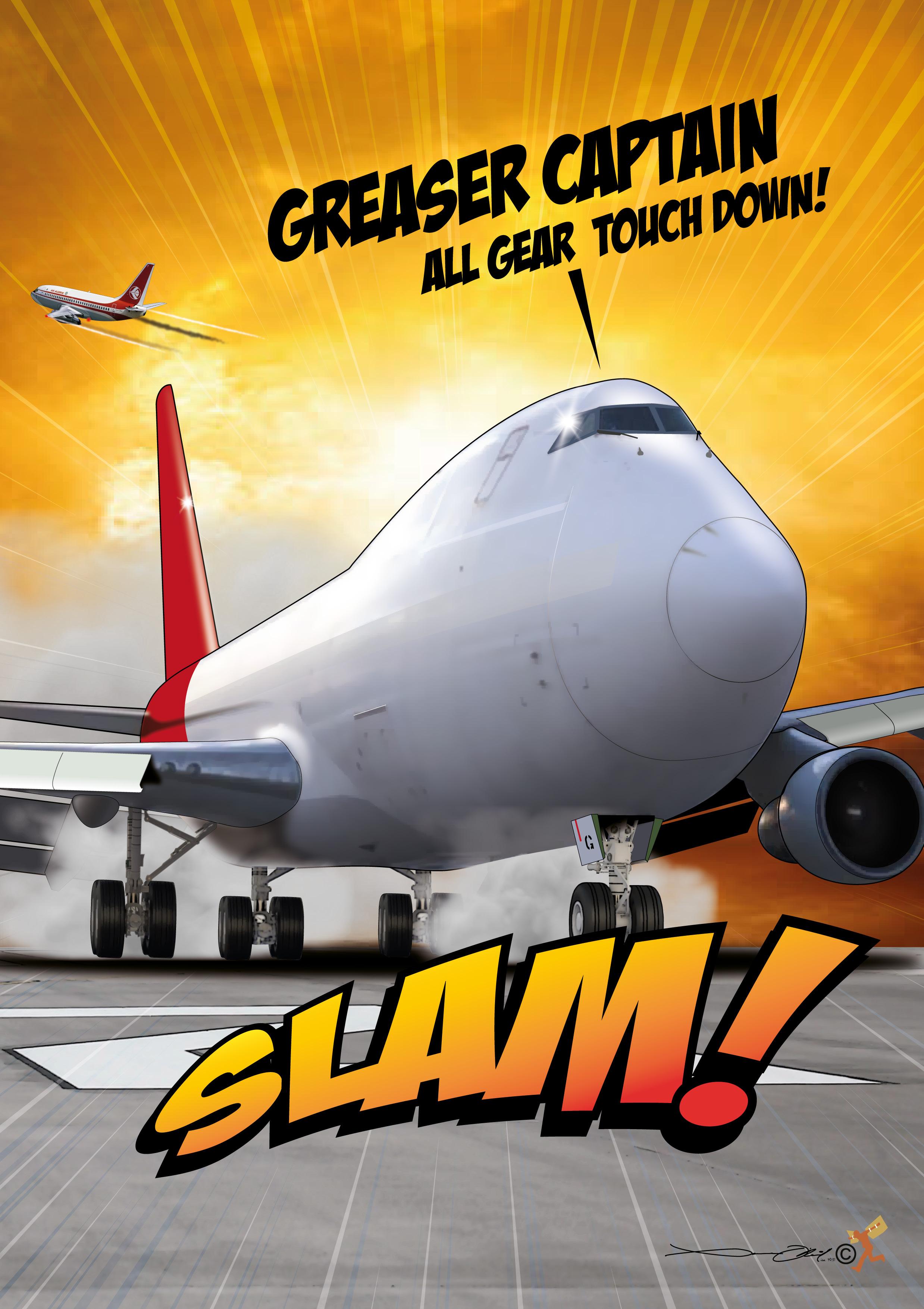
living area, for reasons of security and convenience and facing east/west, into the prevailing winds, which can reach speeds in excess of sixty knots at certain times of the year.
These recommendations were sent to the Client’s Head Quarters where a decision was made, by somebody who paid no attention to them at all, to position the new air strip seven kilometres away from the Camp Kilo construction site, facing north/south.
Only in conditions where the wind is straight down the axis of the runway or the wind is calm, can the DHC-6 be landed with both main wheels alighting at the same moment. For a landing with the wind across the runway, the upwind wing MUST be lowered into the wind, in order to keep the aircraft straight and therefore the upwind main undercarriage will perforce, touch the ground before the others. A cross-wind from the right will precipitate a landing with the right main wheel first. This is a fact of life. If a cross-wind landing should be attempted in a wings-level attitude, the aircraft will land sideways. Tyre damage and possible structural distortion may be expected in these circumstances. The aircraft may also depart from the runway and substantial airframe damage, injury and death could easily follow such an excursion.
My report was considered too aggressive and confrontational to be copied to management and so we, the aircrew, remained guilty as charged, until proved innocent.
This politically correct outcome got right up my nostrils and I resolved not to leave our condemnation unchallenged.
The person who had caused us to be forced into this situation was the person who had put the runway there in the first place, against our recommendation. I decided to raise a Stop Card against him for, if nothing else, causing so much trauma to one of our esteemed passenger.
In case you should run away with the impression that a Stop Card is no more important than a Valentine’s Day greeting, I must describe the recommended method of delivery.
the staff mess effluent riser spigot
Upon witnessing a dangerous act or the High Potentiallity (HIPO) of a dangerous act being committed, the witness shall approach the offender purposefully, catching his attention and maintaining eye contact. He shall then raise the Stop Card, and address him thus; -
“You have committed (or are about to commit) an unsafe act and I am raising a Stop Card against you.”
There are two possible solutions to the complainant’s concerns. Firstly, it would be necessary to construct a new runway, facing into wind, following the aircrew’s original recommendations, in order to facilitate landings with both main landing gears touching down simultaneously. The second, less costly, solution is to continue as we are and request that the anonymous complainant be required to travel by road in the future.
Hoping that this assists you in your search for a safe and efficacious solution to the problems raised and that you will feel free to contact me if you have any further points for discussion.
I remain........etc.
The miscreant should then desist from any activity in which he is involved, pending a thorough risk assessment. Only after a full risk assessment in the presence of a supervisor, can work proceed after the raising of a Stop Card. The urgency of a Stop Card delivery supersedes all other activities. A man, for example, kneeling to receive the honour of a Knighthood from Queen Elizabeth the Second of England, might be about to sink his knee into a potential hazard, left behind by one of the Corgis. Can you imagine the HIPO for scandal among the Palace courtiers, unless YOU had managed, at the last nanosecond, to reach into your back pocket, grab a Stop Card, purposefully approach the rostrum, gain the attention of the about-to-be-knighted and, maintaining eye-contact, announce in an authoritative tone, “You are about to commit an act which will make you and
you family and the general public laugh for a very long time indeed......”
So, it was with this in mind that I purposefully approached the office door of my friend Dermot, the Construction Manager. I knew that, at this time in the morning, he would be buried in deeply sleep-inducing discussions with his deputy, about the flange gasket washer valve on the staff mess effluent riser spigot. He would appreciate a little light relief, I was confidently sure.
His office door was ajar, as usual. I knocked and entered. Nothing gets in the way of the bearer of a Stop Card. Dermot looked up in some surprise as I advanced purposefully towards his desk. I produced a Stop Card from behind my back and raised it between us, maintaining eye-contact and intoning the ritual HSE litany as I approached him.
“Dermot Eliot. You have committed an unsafe act and I am raising a Stop Card against you.”
“You can’t do that, Hugh!”
“Why not?”
“We’re friends!”
the wrong direction is something which I told them myself. I have read all the correspondence, but they just told me to wind my neck in and get on with it. So I did. We’ve all got wives and families to support, you know!” He threw his hands in the air in a gesture of resignation.
I suddenly had a brain wave and stuck my finger up for attention. “Who was the guy who told you to put the airstrip where it is?”
“It was an old guy called Trent. I don’t believe he’s ever been out of Head Office. He has lost interest a bit, I suppose, since he was offered early retirement.”
“Do you think a Stop Card would grab his attention?”
Those stitches would have cost me
I couldn’t hold a straight face any longer.
Dermot’s face cracked into a smile. “What’s this all about, anyway? What have I done now?!”
“You built the airstrip facing in the wrong direction and this forced us to land on the left main wheel all the time and we have had another Stop Card raised against us for doing that, on top of the one about the cockpit fans and HSE won’t accept my back-away report about the left main wheel landings because it’s too aggressive and confrontational and the tenders for the new air transport contracts are in and they are coming up at the management meeting at 9 o’clock this morning and... and...it’s all your fault!”
“Well you can’t blame me, Hugh. I am just a Construction Manager. I do as I am told. They tell me where to put the airstrip and in what direction to lay the runway and I do it. The fact that it is pointing in
“Oh yes!” Dermot grinned, “Senior Management don’t like to be held up in public. Particularly old Trent. He was one of the founding fathers of HSE in the company. He was kind of brought in to start the HSE ball rolling and now that it has gathered its own momentum, there’s nothing much more for him to do, so they’re putting him out to pasture.”
“Have you got any Stop Card forms handy, Dermot?”
“I most certainly have, Hugh. Couldn’t happen to a nicer guy!”
It was fun watching the pin-ball progress of the Stop Card, as it bounced around the intrays of the mandarins in Head Office, but my glee was comparatively shortlived and HSE’s pay-back time came swiftly. Seven stitches had been necessary to staunch the flow of blood from my head when a heavy steel wrench slipped out the hand of Alex, our engineer, who was working, up on the aircraft wing, under which I should not have been standing.
If I had just been wearing a hard hat, I wouldn’t have needed those seven stitches. I’m just thankful that I was no longer on the Sahara gas project when it happened. Those stitches would have cost me an awful lot of beers!
EMBRAER’S PHENOM 300 has been the world’s best-selling light jet for 12 consecutive years, according to data released by the General Aviation Manufacturers Association (GAMA).
The company delivered 63 Phenom 300 series aircraft in 2023, making the Phenom 300 the most successful business jet of the past decade, having accrued more than 730 deliveries worldwide and operating in 40 countries.
With over 2 million flight hours logged, the Phenom 300 recently became the most-flown aircraft in the United States, with more than 360,000 flights in a 12-month period.
Recently, Embraer announced a new autothrottle feature that will be available for the Phenom 300E. The optional feature is set to enhance the already single-pilot-friendly cockpit, which includes the highly advanced Prodigy Touch based on Garmin G3000.
As the fastest light jet in production, the Phenom 300E has a high-speed cruise of 464 knots and a fiveoccupant range of 2,010 nautical miles (3,724 km) with NBAA IFR reserves.
Additionally, the aircraft offers avionics that includes a Runway Overrun Awareness and Alerting System (ROAAS)—the first to be developed and certified in business aviation—as well as Coupled Go-Around, Emergency Descent Mode (EDM), and more.
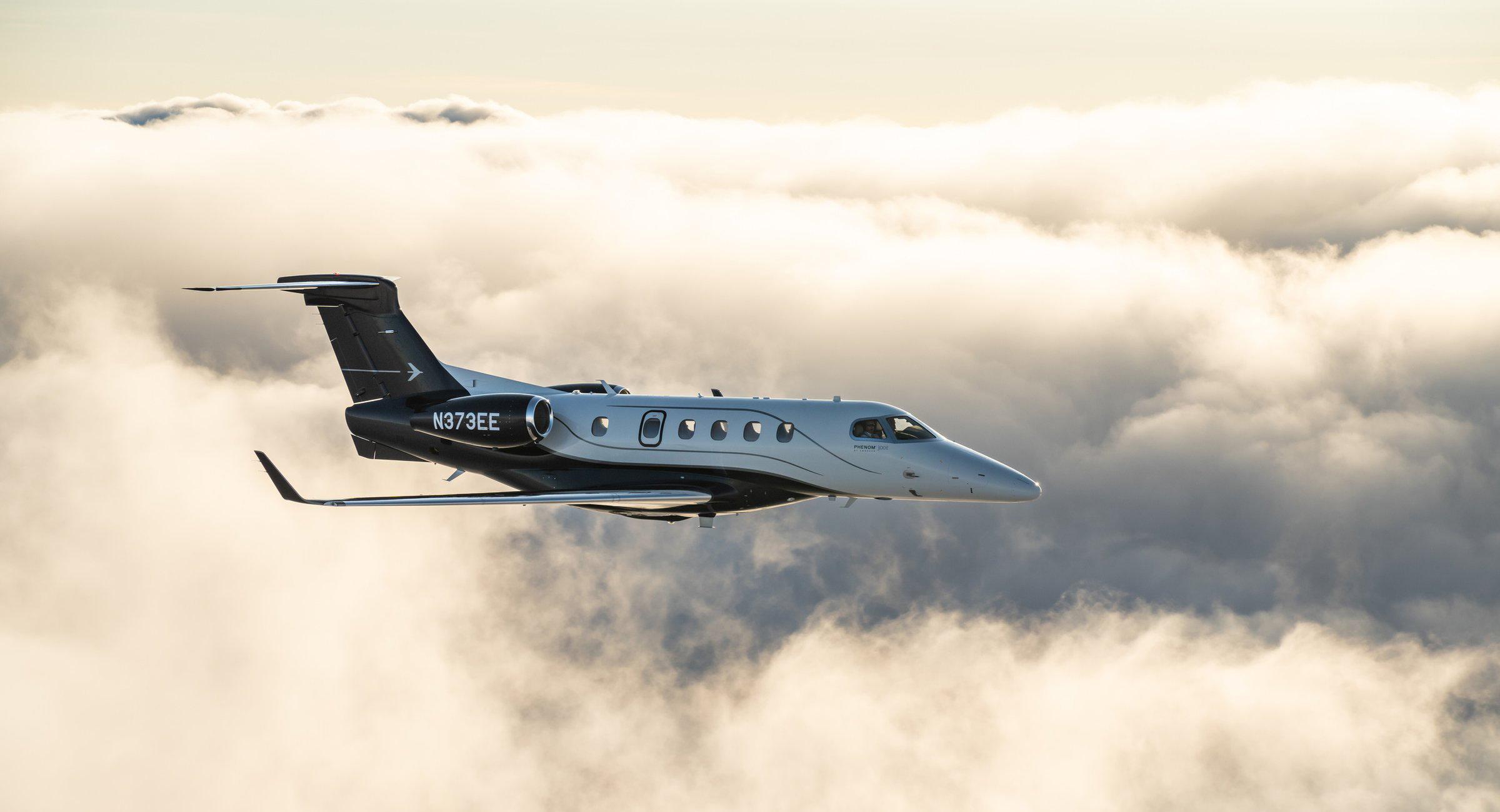
, Australian company Wedgetail Aerospace has successfully obtained the approval from the Australian Civil Aviation Safety Authority (CASA) to operate the Schiebel CAMCOPTER S-100 Unmanned Air System (UAS) in civil airspace.
This is the first large (>150 kg) Vertical Take-off and Landing (VTOL) UAS to attain this civil approval from the Australian authorities.
WedgetailAerospace, in close cooperation with Schiebel Pacific and the Australian authorities, completed the process to achieve experimental approval with a series of flight demonstrations in Western Australia.
Possible applications now being pursued include fire and disaster monitoring, cargo delivery, as well as inspections and surveillance.
In addition, Wedgetail Aerospace is a CASA approved training organisation and will offer an S-100 license for civil operations. Of note, the S-100 is regularly flying under a Defence Aviation Safety Agency (DASA) UAS permit, which the Royal Australian Navy obtained back in 2017 for their S-100 operations.

On the 26 August 1980 I was asked to fly charter clients in the Aztec: 5Y-ARN. This aircraft had a 12-volt battery which often caused me to have serious heart flutters when trying to start the engines. All the energy in the battery was used up in starting the left engine and I’d have to wait for it to charge up again before I could start the right engine.
ANYHOW, ‘ARN’ AND I were teamed up together for many trips and over time I learnt to manage his idiosyncrasies.
We departed Wilson Airport in Nairobi at 04h15Z, our destination was Entebbe, on a peninsula in Lake Victoria, in Uganda. I was nervous as I’d never flown that far north on my own before. My fellow pilots at Sunbird were very supportive and the day before we departed, Dicky Bird sat me down with a rudimentary map, and circled all the critical landmarks. These were the days before detailed maps and charts, all we had to go on was local knowledge which was passed down from pilot to pilot.
Laura McDermid continues her stories about Iris McCallum in East Africa. we’re
‘Your timing when flying into Moroto is critical Iris; there are a LOT of pointy rocks on that route.’
For emphasis he drew a big red circle around the word ‘Wagagai’.
in for a rough ride
‘At 14,177ft this is the highest peak on that range. Fully laden and with a high-density altitude, ARN might battle.’
Mount Moroto is one of a chain of extinct volcanoes along Uganda’s border with Kenya that begins with Mount Elgon in the south. Geologists estimate that Mount Elgon is at least 24 million years old, making it the oldest extinct volcano in East Africa.
The flight went smoothly, and I landed without any problems at Entebbe. I did my post-flight checks, refuelling from a private supply of Avgas that the International Committee of the Red Cross (ICRC) had organised.
The airport terminal building had been decimated; every conceivable fixture had been removed. Tentacles of wires stuck out from empty plug sockets. Basins and toilets had been ripped out of walls and floors. Even the window frames and panes had been stripped, leaving gaping holes in the walls.
Idi Amin, the third president of Uganda, had attempted to annex Tanzania’s Kagera Region in 1978. In response, the Tanzanian president, Julius Nyerere, ordered his troops to invade Uganda. In 1979, Kampala was successfully captured, and as a result one of the most brutal despots in modern history was ousted from power.
A massive famine ensued, and the ICRC were called in to assist.


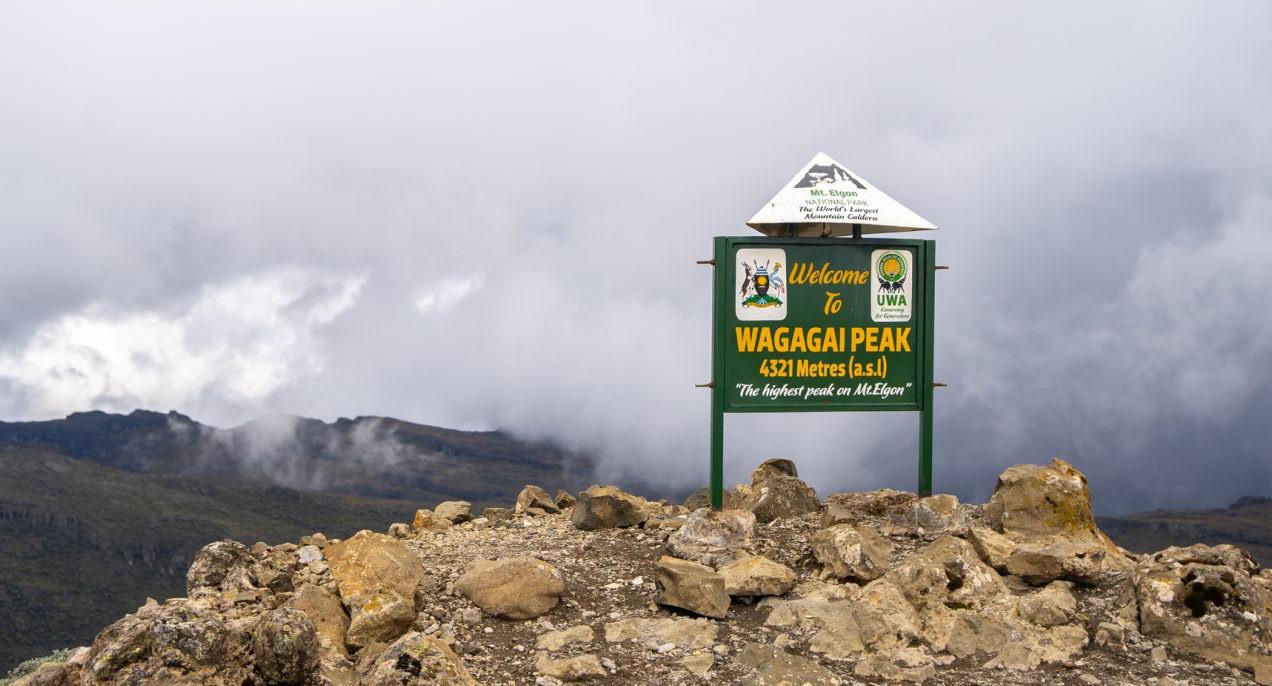
My VIPs were the head of the ICRC, and his adjutant, Christopher, who were both ex-military from Switzerland. Their aim was to conduct a recce of Uganda to determine the extent of the damage and to assess what relief aid would need to be deployed.
An ICRC driver was waiting to collect us and take us to the temporary headquarters on the outskirts of town.
We drove through numerous roadblocks manned by Tanzanian soldiers who were easily recognized by their bad attitudes, dark aviator sunglasses and machine guns that were casually slung over their shoulders.
The HQ was based out of a house that doubled as accommodation and offices. It was a great big colonial double-story house nestled in a canopy of emerald green trees and rolling hills, with a wraparound veranda that offered 360 degree views, a critical feature for safety reasons.
After freshening up, my pax were ushered into an all-day meeting and I was left to my own devices.
I always travelled with books, so I made myself comfortable on a sofa and had just immersed myself in a story when scraping sounds on the
wooden floor above me interrupted my concentration. I put my book down and went to investigate. I was greeted by the sight of the staff moving furniture around. I singled out the Major-domo and asked him what was happening.
His face split into a huge grin, his bone white teeth standing out in stark relief against his blue-black skin. He explained that they had expected the pilot to be a male and as such had arranged for shared living quarters.
My arrival changed all of that, and the gallant member of staff voluntarily gave up his room for me and was in the process of moving in with another member of staff.

My newly acquired bedroom was beautifully appointed with incredible views of Kampala’s hills.
That evening a cocktail party was thrown in honour of the VIPs. An entourage of guests, all NGOs affiliated with the ICRC, began streaming in. I felt a bit like a fish out of water amongst all the relief workers, so I put my experience of organising safaris into action and made myself available as a bartender.
The evening was a great success, and thanks to my heavy hand, everyone was very relaxed.
We took off from Entebbe at 06h00Z, and an hour and forty minutes later landed at Moroto in the Karamojong area. This part of the country was surrounded by mountains, rocky outcrops, and unique vegetation. My notation in my logbook read ‘a beautiful day’.
A chauffeured Landcruiser was waiting for us. We were driven to the local hospital where my guests met with the staff to see what medical supplies were needed. The smell of rot hung in the air and a few sick and wounded patients were milling around listlessly. There were no mattresses on the beds. A woman with a sick child was sitting on the bare springs. Bloated green flies clustered around the mucous that spilled copiously from the child’s nostrils. The mother looked at me, her glazed eyes imploring me for help. I shrugged my shoulders in a helpless gesture, feeling more impotent than I’ve ever felt before.
It was an eye opener for all of us.
After the visit to the hospital, the driver took us to an abandoned lodge in the Matheniko Game Reserve which had escaped the looting.
It was managed by a caretaker from the Karamojong tribe, Jonas, who kept the place spotless and had arranged a few sprigs of wildflowers in an empty tin can in anticipation of our arrival. We had brought rice, tea, and basic supplies with us, but Jonas was adamant that he would treat his distinguished guests to a nice meal.
I’ll never forget the spectacle of Jonas running around the outside of the building, knobkerrie in hand, in hot pursuit of a few scrawny Crested Guinea Fowl. Much to my amazement, he managed to catch one. The Swiss were suspicious of the blue hued meat, and ate the meal of the boiled, tough fowl in silence.
Jonas hovered around the table, his slanty Nilotic eyes darting expectantly from person to person, the taut decorative scars on his face glowing in the soft light of the paraffin lamps, lending him an otherworldly look.
The Swiss were too polite to complain, appreciating the effort that Jonas had gone to, to put this meal on the table.
Content with their survey, my passengers were ready to return to Geneva to begin making plans. My job done; I contacted the folks back at Sunbird to let them know that I’d be departing the next day.
We were airborne out of Moroto at 11h30Z, arriving in Nairobi late afternoon just before the last shard of orange slipped below the horizon.
It was trips like these that I remember fondly, selfless people doing their best to help others in times of hardships. I know that I was just doing my job, but I’d like to think that I was also contributing to this noble cause in some small way.

THE GHANA AIR FORCE is in the ongoing process of acquiring the Super Tucano training and light attack aircraft from Embraer.
The expected cost of the acquisition is $52.8m, according to GlobalData’s Ghana Defense Market 2024-2029 report.
Against the backdrop of heightened security concerns in the sub-region, the Ghana Air Force, in collaboration with Embraer Defence and Sierra Nevada Corporation (SNC), hosted an air show featuring the A-29 Super Tucano. The event at the Air Force Base Accra, aimed to highlight the aircraft’s versatility in close air support and aerial reconnaissance missions.
GlobalData forecasts an upturn in Ghana’s defence spending over the next five years, with an anticipated annual growth rate of 11.3% from 2025 to 2029, reaching $509.6m by 2029, after experiencing a decline in recent years. The country’s security concerns are exacerbated by instability in the Sahel region, prompting efforts to bolster border security and control.
In 2021 neighbouring Nigeria held an induction ceremony for the A-29 Super Tucano, acquired through the US Foreign Military Sales programme at a value close to $500m. The ceremony marked a milestone in enhancing Nigeria’s ability to combat terrorism. The aircraft is expected to play a role in Nigeria’s efforts to combat violent extremism and ensure sustained deterrence.

IN 2021, Australia’s New South Wales Ambulance decided to purchase two Pilatus PC-24s to further increase the organisation’s speed and distance operational capabilities.
The operator will use the PC-24 to provide aeromedical services to the people of New South Wales, covering an area of approximately 800,000 square kilometres. It is anticipated that the “Super Versatile Jet” will conduct around 800 flights, transferring approximately 6,500 patients, during its first year of service.

“The PC-24 increases the capability of our aeromedical operations and is ideal for the long distances we have to cover in Australia, it will be a great asset to our clinical staff and patients”, said NSW Ambulance Commissioner Dr Dominic Morgan.
“The PC-24 is no stranger to the aeromedical space, it’s a highly sought after platform for many of the top aeromedical organizations around the world. Like the aircraft, the aeromedical configuration has proven itself in some of the harshest operating conditions anywhere. We’re extremely proud that the New South Wales Ambulance has chosen our aircraft to save lives and serve their community”, said Pilatus Australia’s CEO, Sebastian Lip.
The PC-24 is the world’s first air ambulance jet with a patient loading door. Patients can be loaded and unloaded by means of an electrically powered loading device or alternatively with a ramp.

Many African governments have lacked the skills and resources to do major maintenance and repair work to keep older equipment up to date. With the carrot of foreign aid and industrial participation offsets being dangled over procurement departments, the preferred option has usually been to replace older equipment.

HOWEVER, THIS MAY BE a false economy. A recent discussion on a WhatsApp group dedicated to the SA Air Force provided interesting insights onto the subject of repair – or replace. The identities of the contributors have been withheld and contributions have been in many instances paraphrased.
It was noted that as warfare gets more asymmetrical, the value in less expensive means of doing the job becomes higher. The value of a mature system is that there are few teething problems and spare parts are usually plentiful.
Thus, for example, many older aircraft, such as the Douglas DC-3 and the AV-8B Harrier, have a long fatigue life and can operate from almost anywhere. While older aircraft require more maintenance hours, maintainers are relatively inexpensive and older people can be retained with incentives far more cheaply than hiring and training new.
Our defence columnist, Darren Olivier, noted that, “Every aircraft type has an operating cost curve. It’s high when first introduced, then reduces for the next 10-20 years as units become familiar with the type and learn the most efficient techniques. The original equipment manufacturers continually improve production techniques, and early issues are ironed out.
“By around 20-25 years of life the cost curves upwards again. You can prolong things with capital investments to replace some of the more obsolete and expensive parts, but you’ll never get back to the operating costs achieved earlier.
“After a few more years, with OEMs no longer producing parts, life extensions become increasingly non-feasible and key knowledge is lost through retirements. The cost climbs rapidly again until it becomes unaffordable for most forces. For example, in 2001 the cost to remove an engine from an AV-8B and take it apart to repair damaged fan blades, such as from a bird strike, was $500 000 ($860 000 today) and took 850 man-hours.
“That said, if your needs are modest and you don’t need much in the way of upgrades, new weapons integrations and so on, you can quite efficiently and effectively operate older aircraft for a while.
“This isn’t an argument to always have the latest and greatest. For instance, Nigeria is quite comfortably operating relatively old Alpha Jets after returning them to service a decade ago, and even re-militarised some ex-civilian examples they bought from US collectors. But the aircraft are also increasingly vulnerable to enemy forces.

Olivier concludes by noting that “by not funding a Rooivalk mid-life upgrade, which would reduce operating costs and improve availability, the South African government is basically ensuring an early retirement of the type.”
Another contributor discussed the retirement of the SAAF’s Cheetahs in 2008 in favour of the Gripen. He noted that, “They were already on wonky legs by 2008 with few of the original fleet going. It was still a capable aircraft with lots of knowledge on how to operate it, but it was becoming very long in the tooth. Add to that Denel’s current woes, and it would have left them in a proper predicament.”
It was pointed out that the maintenance costs on the Cheetah are probably higher than that on the Gripen. “If we can only afford a handful of airworthy Gripens, how many Cheetahs would be airworthy if they were in service?” Darren Olivier supported this question, noting; “I strongly believe that if the SAAF had continued operating the Cheetahs and never acquired Gripens, it would currently not have a fighter fleet.”
Those who argue that the Cheetah should not have been retired, often make the claim that they are still
flying in the USA and Ecuador and use this as a reason to justify why the SAAF should not have bought the Gripen. However, the reality is that the Cheetahs never flew in the USA, and Ecuador retired their fleet in 2021.
An interesting comment about the Gripen vs Cheetah capability was that, “It was more about the SAAF equipping themselves for the previous war, rather than fully embracing and committing to the new capabilities they have in a modern package. … the operators have complained about the lack of upper management understanding and appreciation. For example, having a dumb bomb capability is useful, but that should be secondary to the laser guided bomb. Yet it seems it’s the other way around in the SAAF.
“We bought a great product, but are choosing not to embrace it, at least not in the upper brass levels.”
This claimed resistance to fully adopting the latest technology may tip the balance in favour of repairing and maintaining older types, particularly in the increasing evident asymmetric warfare scenarios.

Some
•
•
•
•


”
a lot.”


Back in the early seventies, I started a charter outfit based in Johannesburg, which piggy backed on someone else’s licence on a royalty basis. As most of our passengers were male businessmen, I called it Esquire Airways. Then we moved to Gaborone in Botswana and changed the name to Esquire Botswana Airways.
the company was sold, and given a new, more appropriate name; Desert Airways.
We became principally involved with operating charter and scheduled flights on behalf of Air Botswana. Business picked up in the Okavango region, to the extent that we based a pilot and a twin piston Aero Commander 500B there with a pilot in Maun.
Early in our northern tenure, the famous, locally based hunter, Harry Selby, who had opened luxury Safari Game Lodges at Khwai River, Savuti and Xugana, offered us a contract to fly “Lindblad tourists” from Maun to the various lodges on a rotational shuttle system basis. These flights also carried a professional game guide.
outboard motor, refreshments, and several rolls of bright pink toilet paper to prepare for our arrival.
Once at the lake, Dougie would set about festooning numerous tree stumps, invisible from the air, with bright pink toilet paper to show the beginning of the useable landing area on the lakeshore.
we consumed more than our fair share of his liquor
One of the tour highlights involved taking off from Maun then landing at Lake Ngami a few miles to the south. There was no official runway there. Early in the morning Dougie Graham would set out in his Land Rover, complete with a trailered pneumatic dingy,
These short flights involved circling over the lake in each direction to allow those on board to photograph the flamboyant Flamingos. That done, we would fly the approach over the flagged pink tree stumps and touch down on the smooth, though unprepared, lakeshore.
A symbiotic relationship existed between cattle dung, and the shoals of bream and barbel (catfish) in the lake. The cow dung created a rich plant system which fed the rapidly increasing shoals of fish. Barbel carcasses littered the bank and their large heads caused a resounding thump when our main wheels ran over them.
Our game guide on one particular occasion was Tim Liversedge, an ex-game scout, turned wildlife sculptor and artist. Later, he achieved fame producing dramatic wildlife films, including a spectacular IMAX production, titled Roar.
One morning Tim and the five tourists set out across the lake, where the occasional dull thud of the outboard motor propeller was heard dissecting fish, bits of which floated to the surface and provided fine dining for Fish Eagles perched in nearby trees.
On one occasion, as Tim stood discoursing on the lakeshore, a baby Jacana flew up, and without interrupting his talk, Tim jumped with great athleticism and caught the bird by the legs. Holding onto the wriggling bird, he described its habits and pointed out its defining characteristics, then let it fly away. This feat amazed the tourists, and one asked him if he would do it again, as his camera had not been ready.
Prior to departure, several freshly caught bream were placed alive in buckets of water, which we stowed


under the aircraft rear seats. From the lake we flew to Khwai River lodge. There the bream was served as a delicious lunch.
Several years later Tim abandoned microlight flying and acquired a private pilot’s licence. Then he paid R6,000 for a Cessna 175 fitted with a 180 hp Lycoming and constant speed prop.
Having few hours of piloting experience, Tim asked me to accompany him on the delivery flight from Wonderboom to Maun.
However, Tim was delayed at Wonderboom, and as the hours passed it was agreed that we could no longer takeoff and reach Maun in daylight. At that time, no runway lights were available in Maun for night operations. But we felt that we should at least be able to reach Francistown for a night stop.
However the headwind had increased, so we arrived at Selebi in what may be termed late “Military Twilight,” about 5 minutes before total opaque night set in.
a large black shadow across our plane
Sadly, the ADF on the aircraft was unserviceable as I had hoped to intercept a QDM which would lead us to the west facing runway threshold. However, I was very familiar with the airport and its environs, so was able to direct the un-night rated Tim to the nearest runway for a straight in approach. We kept the speed up, and only slowed down to flap speed close to the landing area. Using the rudder pedals to slew the nose left and right we were able to discern the runway piano keys threshold in our landing light. With a little instruction, Tim did an excellent night landing, and we taxied through the enveloping blackness to the parking area.
All went well for an hour or so, but we then flew into a fairly strong headwind which meant our groundspeed dropped from about 105 Knots to around 85 Knots. Reaching Francistown before dusk became unlikely. However we pressed on, and after a while realised that it would now be necessary to land at Selebi Phikwe in eastern Botswana.
After clearing immigration (which had waited for us) we bumped into Ivor Scott, the ex World War 2 Spitfire pilot, who lived near the airfield. He had wondered who was taxying about in the dark. After explaining our situation, he extended his legendary hospitality and we dined with his family and consumed more than our fair share of his liquor.

The trip to Maun was uneventful, until crossing the vast Magadigadi Pans, we became aware of a large black shadow across our plane. When we looked at each other, the shadow disappeared, only to cover us again a minute or so later. We banked the aircraft steeply and looked upwards, but could not see anything between us and the sun. This lasted for about five minutes then stopped. The shadow had pointed portions in a form of a triangle. We both felt unnaturally perturbed, and after some discussion we could not apportion any reason for this phenomenon. There were no clouds above us, and the shadow had unnaturally sharp edges. Neither of us had encountered, or even heard of this anomaly before. I opined that the quick moving dark shadow, which sporadically changed directions, may have been cast by an alien spacecraft carrying marauding space cannibals, which had fortunately rejected us as being sub-quality fodder, unworthy of abduction.
The remainder of the flight was uneventful, and we landed in Maun without further incident. Tim parked the C175 in a hangar. Suspecting that a panel had come loose and was swinging about, causing the shadow, he used a ladder to investigate the top of the wing and fuselage. But all was tightly still in place. Neither had
there been any aerodynamic buffet, or unusual noises. So the shadow remains a mystery to this day.
Still, I got to spend an entertaining evening with Tim and his attractive wife June, at their comfortable riverside home.

they never come off, whether they can be seen or not. They fuse to the soul through adversity, fear and adrenaline, and no one who has ever worn them with pride, integrity and guts can ever sleep through the call of the wild that wafts through the bedroom windows in the deep of the night” – Author Unknown.
My wings were firmly attached since birth. Being born with invisible wings makes one eligible for a lifetime membership in an intangible fraternity, the brotherhood of airmen.
Those of us who were born to fly were also born with an innate sense of our destiny, fine tuning life’s trajectory early on so that its path would point us skyward. Nothing will throw you off course.
the headstrong determination of an angry badger. I couldn’t afford to start flying as early as I had wished (no money), which resulted in cutting my teeth on anything that even remotely resembled an airplane. As I grew, balsa wood and rubber bands gave way to Airfix plastic model planes which eventually yielded to flying their petrol powered aluminium and Dacron counterparts.
As an adolescent, I was far more enamoured with the idea of soaring with birds, and the heady aroma of burned paraffin, than I was the fairer sex.
To fly is to live at the outer edge. From the first twist or push of the throttle, flying seems to transform the mundane, to where all of life makes sense and is seen from a different perspective, where the commonplace reaches the summit. To fly is to know the perfection of a cloudless summer day when the warm gentle air currents push the graceful wings of a bird to the brink of the troposphere. To fly in pure harmony is the grace of notes that rise beyond a musical score high above the treble scale.
As with all of us born into the brotherhood, albeit often a lonely one, I pursued my passions with
Even now, after so many years, my world pretty much only feels in harmony as I walk around an aircraft, looking for anything out of place. Running my hands along the fuselage and wings, or blades, feeling mechanisms, connection points and fittings as if they are old familiar friends. A preflight walk before a mission is instinctive routine, but not without focus. The aircraft is so often the single most important part of any mission. It enables the success of the job, but more importantly it acts as the body of crew. Each person is tethered to the aircraft, relying on the machine (and pilot) for survival.
Decades later, I still feel my pulse race in anticipation of pressing the start button. But, deep inside, fears loom, the unseen enemies. The demons. Fear of possibly never returning home? Having to say goodbye. Finding
The world from above, for me it is an untouchable sacred place, worth all the hardships and I would do it all again.

the stamina to remain focused on the job at hand no matter what curved balls come, over and over again.
With all the adversity I find an almost child-like joy as I discover new places and look down, glimpsing moments of Google Earth in real time. I love them.
Africa. If it is in the blood then it too will not release its grip on your soul. Even though the romantic idea of the land that was, is no more. Somehow it won’t let go. And here lieth the problem.
The bureaucracy. After what seemed impossible, the order, approvals, military permits, compliances and clearances were approved for me to start the painful journey north.
If it were just about flying, fantasizing about the mysteries of the landscape unfolding with untold stories below, that would be happiness. The clearance window of 72 hours adds to the anxiety, since on-route weather seldom complies with the government administration.
it will not release its grip on your soul
Funny how it’s always hurry up and wait, all dressed up with nowhere to go, pacing, waiting for that last approval to appear, which happens somehow at five minutes before cut off time.
Rolling the throttle to full power and feeling the beast coming to life, literally pulsing to set itself free into the place where everything feels perfect again, rids the mind of all the bullshit. For a couple of hours, the entire world and heavens belong to you and earthly problems exist no more. That is until the anxiety builds as the dotted line of another CTR on the GPS creeps closer. “Will I be able to understand what the ATC is mumbling to me?” Expect the unexpected.
“Rhomo Kil pap, yoo musti dewert eastie end holdie toothousend end stanyby”
“Eh, copied approach will turn right now and hold until further instructions.”
Now I’m wondering what will happen next, singing to myself a tune from a song: Turn, turn, turn…. straining my eyes into the haze, I see a military transport lining up on 05.
The silence breaks. “Rhomo Kil pap, leman kleer 05”.
Eventually I’m cleared direct to the apron. Like multi-coloured ants, the apron is lined with a multitude of pomp and ceremonial dress. Military, both the AK 47 wielding cammo troops and officers adorned with ribbons and badges, police and airport officials, brightly dressed women looking like Prom night, lurking everywhere. Ahhh, I just missed the President!
The awaiting customs, immigration and refuelling procedures followed by the ritual climbing stairs up to run down, messy and ancient briefing rooms, to part with wads of US$ and file flight plans, awaits. The best part being that they are air conditioned, a brief escape from furnace heat and drenching humidity.
Say no more...you have to just do it all.

Delays have become the norm due to obstructive and incompetent administrators, so we have just had to adapt our flying to fit in with more difficult operating conditions, increasing risk and stress.
This tiny relief from the heat and chaos to be followed by fighting your way back through sweaty crowds and queues lined up at surly faced, VIP, immigration officers. Occasionally you get lucky and passing through customs is a matter of a friendly greeting. This is best achieved if you get your timing right, departing as an Ethiopian airlines 777 is loading up. Then the best part, beating your way through the waiting travellers and exiting the departure door… alone, back into open space, walking towards your bird.
As I walk around, eyeing the familiar lines of my helicopter, anxious to escape the rapidly building thunderstorm and climb up into breathable, cooler air and end the seemingly never ending story, my eye catches the popped up nipple of the hydraulic filter. I’m pretty sure the ATC in the tower heard my groan of frustration. A blocked hydraulic filter is not the end of the world, especially when you are at your base in civilization. But it does raise a niggle when you are 3000 kms away and going even further. But, hey, remember, this is our passion.
And there she is, sitting patiently in the hot sun, oblivious to all the human drama, one can almost feel her anxiety to come alive again and be set free. One more short hop and I will arrive on the reserve after five days of non-stop travelling. I’m wondering how my fresh rations purchased six days ago in Woollies has fared? I am imagining what my accommodation will be like, my home for many weeks? I know I won’t get the full Monty, international tourist treatment, but then I get to be completely free to do and go as I wish. Sure it won’t be too bad.
In the past, when things worked, we started operations in the dry winter season, sharply, in order to complete operations well before the first rains start and while the bush is still open and weather more predictable.
Nowadays, due to the lethargic African way, we are well into the rainy season, dodging Charlie Bravos, and tolerating ridiculous heat, humidity and bugs. This is a love hate situation because I love to be out and free, flying, working in the bush and I am so happy to actually have work, especially with all

the price undercutting and competition…BUT!! Its unforgiving, thankless and soul destroying to see how many “conservation” organisations that are corrupt to the core and bankrupt.
I’m not sure where the worst are, the Parks in South Africa which have become a sad and political mess well on their way to total collapse? Then again, it’s the story of Africa. Thankfully, there still remain precision run gems, scattered around Africa, all facing daily crisises of violence and wildlife crime from overpopulated and poverty stricken communities that surround all Parks.
A pilot must take what comes, it’s just part of the territory that happens. Shit accommodation, obnoxious turd clients, huge inconveniences, a diet fit for a dog, underpaid and no thank you at the end.
I often think that all those years of being away from the world, learning, risking, studying and honing skills to try reach perfection, often seem oblivious and pointless to clients.
So often, all the client wants is the machine, to perform a task that would be perfect for a remotely operated craft. The “driver” would be better off comfortably relaxing at home, operating the craft on a laptop, remotely, while drinking coffee. A faceless operation with no name and no need to be polite.
Thankfully this is not always the case. Conservation comes in many forms, each with a similar story of hope, but with the new world order, politicians have caused most to fall into decline with questionable hope.
You may ask: But why? Why put yourself through all that kak? The answer lies in the moments of harmony, at one with an aircraft strapped to your back and a distant horizon. For me, it’s also stolen moments of harmony, an intangible connection with the bush and unknown challenges. Probably all one stupid illusion?
In its 2023 annual report, Pilatus Switzerland says the past financial year was marked by major successes. 148 aircraft were delivered for total sales of 1.478 billion Swiss francs and new orders worth 1.513 billion Swiss francs.
In South Africa, local agent Pilatus Centre also reported excellent results. Director Gerry Wyss reports that for the 2023-24 financial year they chalked up 3 x PC-12s sold and 3 delivered – note that these were not the same aircraft as there is a waiting list. Further there were 2 new PC-24s sold and also 2 delivered. All positions for new aircraft are now sold out until the end of 2025.
Compared to 2022, Pilatus Switzerland achieved a ten percent increase in sales and added six percent to its operating income. The total number of aircraft deliveries is impressive, too: all in all, 47 PC-24s and 101 PC-12s were handed over to customers in 2023.
In Government Aviation, Pilatus successfully closed a follow-up deal with the Spanish Air Force, which went ahead with the purchase of another 16 PC-21s. In May, the 2,000th PC-12 was delivered to longstanding customer, PlaneSense – and in October, Pilatus celebrated the launch of the new PC-24, with its increased payload and range.


Alongside these highlights of the past year, Pilatus also had to contend with some turbulence: ongoing supply chain problems and supply bottlenecks had a negative impact on production.
Overall, Hansueli Loosli, Chairman of the Board of Directors of Pilatus, is very positive about the past year: “We invested a lot in 2023: in products, staff, growth, infrastructure, digitalization – and always with unwavering focus on our customers’ needs.”
Markus Bucher, CEO of Pilatus, adds: “These impressive results will provide the basis for a promising, successful, sustainable future.”
Pilatus saw an increase not only in terms of sales, but also in the number of its employees: thanks to significant growth, Pilatus employed a workforce of 2848 by the end of last year.
In order to increase own production capacity, Pilatus decided early in the year to proceed with a phased takeover of all approximately 230 employees and the machinery of RUAG Aerostructures Schweiz AG at the site in Emmen. In December 2023, Pilatus also acquired the sales and maintenance services of Aero
Center Epps, a previously independent sales center based in Atlanta. In this manner, Pilatus will continue to ensure first-class support for its customers on the east coast of the USA.
Besides focusing on opening up new sales markets, ongoing product development and fully meeting the needs of customers, Pilatus says it will continue to invest in infrastructure through 2024 – always with sustainability in mind.
In addition to the planned extension of the logistics building, the new maintenance hangar currently under construction is particularly noteworthy. With its fullsurface photovoltaic system, use of groundwater for cooling, heating and process energy, and construction with Swiss timber, Pilatus continues to reduce its CO2-emissions while making a clear commitment to a strategy of sustainability and to Switzerland as a business location.


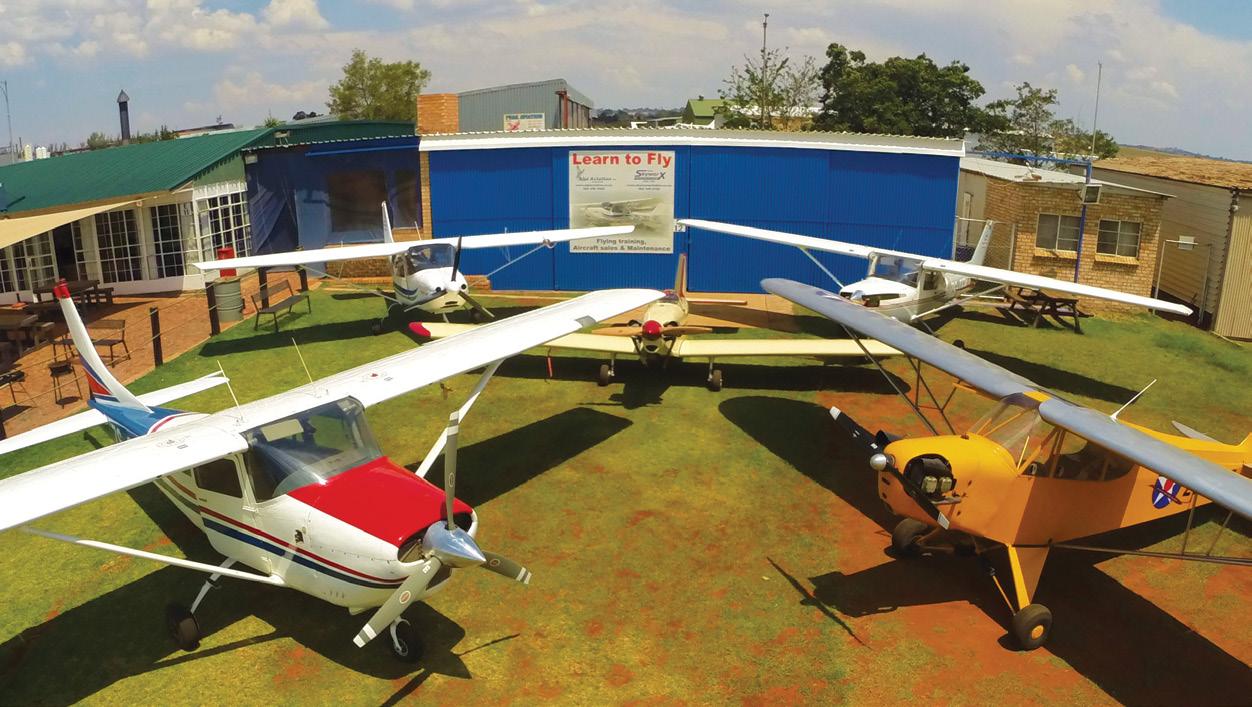








208 Aviation
Ben Esterhuizen +27 83 744 3412 ben@208aviation.co.za www.208aviation.com
A1A Flight Examiner (Loutzavia) Jannie Loutzis 012 567 6775 / 082 416 4069 jannie@loutzavia.co.za www.loutzavia.co.za
AES (Cape Town) Erwin Erasmus 082 494 3722 erwin@aeroelectrical.co.za www.aeroelectrical.co.za
AES (Johannesburg) Danie van Wyk 011 701 3200 office@aeroelectrical.co.za www.aeroelectrical.co.za
Aerocolour cc Alfred Maraun 082 775 9720 aeroeng@iafrica.com
Aero Engineering & PowerPlant Andre Labuschagne 012 543 0948 aerocolour@telkomsa.net
Aerokits Jean Crous 072 6716 240 aerokits99@gmail.com
Aeronav Academy Donald O’Connor 011 701 3862 info@aeronav.co.za www.aeronav.co.za
Aeronautical Aviation Clinton Carroll 011 659 1033 / 083 459 6279 clinton@aeronautical.co.za www.aeronautical.co.za
Aerospace Electroplating Oliver Trollope 011 827 7535 petasus@mweb.co.za
Aerotel Martin den Dunnen 087 6556 737 reservations@aerotel.co.za www.aerotel.co.za
Aerotric Richard Small 083 488 4535 aerotric@aol.com
Aviation Rebuilders cc Lyn Jones 011 827 2491 / 082 872 4117 lyn@aviationrebuilders.com www.aviationrebuilders.com
AVIC International Flight Academy (AIFA) Theo Erasmus 082 776 8883 rassie@aifa.co.za
Air 2000 (Pty) Ltd
Anne Gaines-Burrill 011 659 2449 - AH 082 770 2480 Fax 086 460 5501 air2000@global.co.za www.hunterssupport.com
Aircraft Finance Corporation & Leasing Jaco Pietersen +27 [0]82 672 2262 jaco@airfincorp.co.za Jason Seymour +27 [0]82 326 0147 jason@airfincorp.co.za www.airfincorp.co.za
Aircraft General Spares Eric or Hayley 084 587 6414 or 067 154 2147 eric@acgs.co.za or hayley@acgs.co.za www.acgs.co.za
Aircraft Maintenance International Pine Pienaar 083 305 0605 gm@aminternational.co.za
Aircraft Maintenance International Wonderboom Thomas Nel 082 444 7996 admin@aminternational.co.za
Air Line Pilots’ Association Sonia Ferreira 011 394 5310 alpagm@iafrica.com www.alpa.co.za
Airshift Aircraft Sales Eugene du Plessis 082 800 3094 eugene@airshift.co.za www.airshift.co.za
Alclad Sheetmetal Services Ed Knibbs 083 251 4601 ed@alclad.co.za www.alclad.co.za
Algoa Flying Club Sharon Mugridge 041 581 3274 info@algoafc.co.za www.algoafc.co.za
Alpi Aviation SA Dale De Klerk 082 556 3592 dale@alpiaviation.co.za www.alpiaviation.co.za
Apco (Ptyd) Ltd
Tony/Henk + 27 12 543 0775 apcosupport@mweb.co.za www.apcosa.co.za
Ardent Aviation Consultants Yolanda Vermeulen 082 784 0510 yolanda@ardentaviation.co.za www.ardentaviation.co.za
Ascend Aviation Marlo Kruyswijk 079 511 0080 marlo@ascendaviation.co.za www.ascendaviation.co.za
Atlas Aviation Lubricants
Steve Cloete 011 917 4220 Fax: 011 917 2100 sales.aviation@atlasoil.co.za www.atlasaviation.co.za
AVDEX (Pty) Ltd
Tania Botes 011 954 15364 info@avdex.co.za www.avdex.co.za
Aviatech Flight Academy Nico Smith 082 303 1124 viatechfakr@gmail.com www.aviatech.co.za
Aviation Direct
Andrea Antel 011 465 2669 info@aviationdirect.co.za www.aviationdirect.co.za
Avtech Riekert Stroh 082 749 9256 avtech1208@gmail.com
BAC Aviation AMO 115 Micky Joss 035 797 3610 monicad@bacmaintenance.co.za
Blackhawk Africa Cisca de Lange 083 514 8532 cisca@blackhawk.aero www.blackhawk.aero
Blue Chip Flight School Henk Kraaij 012 543 3050 bluechip@bluechip-avia.co.za www.bluechipflightschool.co.za
Border Aviation Club & Flight School Liz Gous 043 736 6181 admin@borderaviation.co.za www.borderaviation.co.za
Bona Bona Game Lodge MJ Ernst 082 075 3541 mj@bonabona.co.za www.bonabona.co.za
Breytech Aviation cc 012 567 3139 Willie Breytenbach admin@breytech.co.za
Celeste Sani Pak & Inflight Products Steve Harris 011 452 2456 admin@chemline.co.za www.chemline.co.za
Cape Town Flying Club Beverley Combrink 021 934 0257 / 082 821 9013 info@capetownflyingclub.co.za www.@capetownflyingclub.co.za
Century Avionics cc Carin van Zyl 011 701 3244 sales@centuryavionics.co.za www.centuryavionics.co.za
Chemetall
Wayne Claassens 011 914 2500 wayne.claassens@basf.com www.chemetall.com
Chem-Line Aviation & Celeste Products Steve Harris 011 452 2456 sales@chemline.co.za www.chemline.co.za
Clifton Electronics cc CJ Clifton / Irene Clifton 079 568 7205 / 082 926 8482 clive.iclifton@gmail.com
Comair Flight Services (Pty) Ltd Reception +27 11 540 7640/FAX: +27 11 252 9334 info@flycfs.co.za www.flycfs.co.za
Corporate-Aviators/Affordable Jet Sales
Mike Helm 082 442 6239 corporate-aviators@iafrica.com www.corporate-aviators.com
CSA Aviation – Cirrus South Africa Alex Smith 011 701 3835 alexs@cirrussa.co.za www.cirrussa.co.za
C. W. Price & Co Kelvin L. Price 011 805 4720 cwp@cwprice.co.za www.cwprice.co.za
Dart Aeronautical Pieter Viljoen 011 827 8204 pieterviljoen@dartaero.co.za www.dartaero.co.za
Dart Aircraft Electrical Mathew Joubert 011 827 0371 Dartaircraftelectrical@gmail.com www.dartaero.co.za
Diepkloof Aircraft Maintenance cc Nick Kleinhans 083 454 6366 diepkloofamo@gmail.com
DJA Aviation Insurance 011 463 5550 0800Flying mail@dja-aviation.co.za www.dja-aviation.co.za
Dynamic Propellers Andries Visser 011 824 5057 082 445 4496 andries@dynamicpropeller.co.za www.dynamicpropellers.co.za
Eagle Flight Academy Mr D. J. Lubbe 082 557 6429 training@eagleflight.co.za www.eagleflight.co.za
Execujet Africa 011 516 2300 enquiries@execujet.co.za www.execujet.com
Federal Air Rachel Muir 011 395 9000 shuttle@fedair.com www.fedair.com
Ferry Flights int.inc. Michael (Mick) Schittenhelm 082 442 6239 ferryflights@ferry-flights.com www.ferry-flights.com
F Gomes Upholsters Carla de Lima 083 602 5658 delimaCarla92@gmail.com
Fireblade Aviation 010 595 3920 info@firebladeaviation.com www.firebladeaviation.com
Flight Training College Cornell Morton 044 876 9055 ftc@flighttrainning.co.za www.flighttraining.co.za
Flight Training Services Amanda Pearce 011 805 9015/6 amanda@fts.co.za www.fts.co.za
Fly Jetstream Aviation Henk Kraaij 083 279 7853 charter@flyjetstream.co.za www.flyjetstream.co.za
Flying Unlimited Flight School (Pty) Ltd Riaan Struwig 082 653 7504 / 086 770 8376 riaan@ppg.co.za www.ppg.co.za
Flyonics (Pty) Ltd Michael Karaolis 010 109 9405 michael@flyonics.co.za www.flyonics.co.za
Gemair Andries Venter 011 701 2653 / 082 905 5760 andries@gemair.co.za
GIB Aviation Insurance Brokers Richard Turner 011 483 1212 aviation@gib.co.za www.gib.co.za
Guardian Air 011 701 3011 082 521 2394 ops@guardianair.co.za www.guardianair.co.za
Heli-Afrique cc Tino Conceicao 083 458 2172 tino.conceicao@heli-afrique.co.za
Henley Air Andre Coetzee 011 827 5503 andre@henleyair.co.za www.henleyair.co.za
Hover Dynamics Phillip Cope 074 231 2964 info@hover.co.za www.hover.co.za
Indigo Helicopters Gerhard Kleynhans 082 927 4031 / 086 528 4234 veroeschka@indigohelicopters.co.za www.indigohelicopters.co.za
IndigoSat South Africa - Aircraft Tracking Gareth Willers 08600 22 121 sales@indigosat.co.za www.indigosat.co.za
International Flight Clearances Steve Wright 076 983 1089 (24 Hrs) flightops@flyifc.co.za www.flyifc.co.za
Investment Aircraft
Quinton Warne 082 806 5193 aviation@lantic.net www.investmentaircraft.com
Jabiru Aircraft
Len Alford 044 876 9991 / 044 876 9993 info@jabiru.co.za www.jabiru.co.za
Jim Davis Books
Jim Davis 072 188 6484 jim@border.co.za www.jimdavis.co.za
Joc Air T/A The Propeller Shop Aiden O’Mahony 011 701 3114 jocprop@iafrica.com
Johannesburg Flying Academy
Alan Stewart 083 702 3680 info@jhbflying.co.za www.jhbflying.co.za
Kishugu Aviation +27 13 741 6400 comms@kishugu.com www.kishugu.com/kishugu-aviation
Khubenker Energy (Pty) Ltd T/A Benveroy Vernon Bartlett 086 484 4296 vernon@khubenker.co.za www.khubenker.co.za
Kit Planes for Africa
Stefan Coetzee 013 793 7013 info@saplanes.co.za www.saplanes.co.za
Kzn Aviation (Pty) Ltd Melanie Jordaan 031 564 6215 mel@kznaviation.co.za www.kznaviation.co.za
Lanseria Aircraft Interiors
Francois Denton 011 659 1962 / 076 810 9751 francois@aircraftcompletions.co.za
Lanseria Flight Centre
Ian Dyson
Tel: +27 11 312 5166, F: +27 11 312 5166 ian@flylfc.com www.flylfc.com
Lanseria International Airport
Mike Christoph 011 367 0300 mikec@lanseria.co.za www.lanseria.co.za
Leading Edge Aviation cc Peter Jackson Tel 013 741 3654 Fax 013 741 1303 office@leaviation.co.za www.leadingedgeaviation.co.za
Legend Sky 083 860 5225 / 086 600 7285 info@legendssky.co.za www.legendsky.co.za
Litson & Associates (Pty) Ltd OGP/BARS Auditing & Advisory Services & Aviation Safety Training Email: Phone:enquiries@litson.co.za 27 (0) 8517187 www.litson.co.za
Litson & Associates Risk Management Services (Pty) Ltd
eSMS-S™/ eTENDER/ e-REPORT / Aviation Software Systems
Email: Phone:enquiries@litson.co.za 27 (0) 8517187 www.litson.co.za
Loutzavia Aircraft Sales
Henry Miles 082 966 0911 henry@loutzavia.co.za www.loutzavia.co.za
Loutzavia Flight Training Gerhardt Botha 012 567 6775 ops@loutzavia.co.za www.loutzavia.co.za
Loutzavia-Pilots and Planes Maria Loutzis 012 567 6775 maria@loutzavia.co.za www.pilotsnplanes.co.za
Loutzavia Rand Frans Pretorius 011 824 3804 rand@loutzavia.co.za www@loutzavia.co.za
Lowveld Aero Club Pugs Steyn 013 741 3636 Flynow@lac.co.za
Maverick Air Charters Lourens Human 082 570 2743 ops@maverickair.co.za www.maverickair.co.za
MCC Aviation Pty Ltd
Claude Oberholzer 011 701 2332 info@flymcc.co.za www.flymcc.co.za
Mistral Aviation Services Peter de Beer 083 208 7249 peter@mistral.co.za
MH Aviation Services (Pty) Ltd
Marc Pienaar 011 609 0123 / 082 940 5437 customerrelations@mhaviation.co.za www.mhaviation.co.za
M and N Acoustic Services cc Martin de Beer 012 689 2007/8 calservice@mweb.co.za
Metropolitan Aviation (Pty) Ltd Gert Mouton 082 458 3736 herenbus@gmail.com
Money Aviation
Angus Money 083 263 2934 angus@moneyaviation.co.za www.moneyaviation.co.za
North East Avionics
Keith Robertson +27 13 741 2986 keith@northeastavionics.co.za deborah@northeastavionics.co.za www.northeastavionics.co.za
Orsmond Aviation 058 303 5261 info@orsmondaviation.co.za www.orsmondaviation.co.za
Owenair (Pty) Ltd
Clive Skinner 082 923 9580 clive.skinner@owenair.co.za www.owenwair.co.za
Par-Avion Exclusive Catering
Jakkie Vorster 011 701 2600 accounts@par-avion.co.za www.par-avion.co.za
PFERD-South Africa (Pty) Ltd Hannes Nortman 011 230 4000 hannes.nortman@pferd.co.za www.pferd.com
Plane Maintenance Facility Johan 083 300 3619 pmf@myconnection.co.za
Powered Flight Charters
Johanita Jacobs Tel 012 007 0244/Fax 0866 66 2077 info@poweredflight.co.za www.poweredflight.co.za
Powered Flight Training Centre
Johanita Jacobs Tel 012 007 0244/Fax 0866 66 2077 info@poweredflight.co.za www.poweredflight.co.za
Precision Aviation Services Marnix Hulleman 012 543 0371 marnix@pasaviation.co.za www.pasaviation.co.za
Propeller Centre Theuns du Toit +27 12 567 1689 / +27 71 362 5152 theuns@propcentre.co.za www.propcentre.com
Rainbow SkyReach (Pty) Ltd
Mike Gill 011 817 2298 Mike@fly-skyreach.com www.fly-skyreach.com
Rand Airport
Kevin van Zyl Kevin@horizonrisk.co.za +27 76 801 5639 www.randairport.co.za
Dr Rudi Britz Aviation Medical Clinic
Megan 066 177 7194 rudiavmed@gmail.com Wonderboom Airport
SAA Technical (SOC) Ltd
SAAT Marketing 011 978 9993 satmarketing@flysaa.com www.flysaa.com/technical
SABRE Aircraft
Richard Stubbs 083 655 0355 richardstubbs@mweb.co.za www.aircraftafrica.co.za
Savannah Helicopters De 082Jager 444 1138 / 044 873 3288 dejager@savannahhelicopters.co.za www.savannahhelicopters.co.za
Scenic Air Christa van Wyk +264 612 492 68 windhoek@scenic-air.com www.scenic-air.com
Sheltam Aviation Durban Susan Ryan 083 505 4882 susanryan@sheltam.com www.sheltamaviation.com
Sheltam Aviation PE Brendan Booker 082 497 6565 brendanb@sheltam.com www.sheltamaviation.com
Signature Flight Support Cape Town Alan Olivier 021 934 0350 cpt@signatureflight.co.za www.signatureaviation.com/locations/CPT
Signco (Pty Ltd)
Archie Kemp Tel 011 452 6857 Fax 086 504 5239 info@signco.zo.za www.signco.co.za
Skytrim Rico Kruger +27 11 827 6638 rico@skytrim.co.za www.skytrim.co.za
SleepOver
Michael Richardson 010 110 9900 michael.richardson@sleepover-za.com www.sleepover-za.com
Sling Aircraft Kim Bell-Cross 011 948 9898 sales@airplanefactory.co.za www.airplanefactory.co.za
Solenta Aviation (Pty Ltd) Paul Hurst 011 707 4000 info@solenta.com www.solenta.com
Southern Energy Company (Pty) Ltd Elke Bertram +264 8114 29958 johnnym@sec.com.na www.sec.com.na
Southern Rotorcraft cc Mr Reg Denysschen Tel no: 0219350980 sasales@rotors-r-us.com www.rotors-r-us.com
Starlite Aero Sales Klara Fouché +27 83 324 8530 / +27 31 571 6600 klaraf@starliteaviation.com www.starliteaviation.com
Starlite Aviation Operations Trisha Andhee +27 82 660 3018/ +27 31 571 6600 trishaa@starliteaviation.com www.starliteaviation.com
Starlite Aviation Training Academy Durban: +27 31 571 6600 Mossel Bay: +27 44 692 0006 train@starliteaviation.com www.starliteaviation.com
Status Aviation (Pty) Ltd Richard Donian 074 587 5978 / 086 673 5266 info@statusaviation.co.za www.statusaviation.co.za
Superior Pilot Services Liana Jansen van 0118050605/2247Rensburg info@superiorair.co.za www.superiorair.co.za
Swift Flite Linda Naidoo Tel 011 701 3298 Fax 011 701 3297 info@swiftflite.com / linda@swiftflite.com www.swiftflite.co.za
The Aviation Shop
Karel Zaayman 010 020 1618 info@aviationshop.co.za www.aviationshop.co.za
The Copter Shop Bill Olmsted 082 454 8555 execheli@iafrica.com www.execheli.wixsite.com/the-copter-shop-sa
The Pilot Shop Helen Bosland 082 556 3729 helen@pilotshop.co.za www.pilotshop.co.za
Titan Helicopter Group 044 878 0453 info@titanhelicopters.com www.titanhelicopters.com
Top Flight Academy Nico Smith 082 303 1124 topflightklerksdorp@gmail.com
Turbo Prop Service Centre 011 701 3210 info@tpscsa.co.za www.tpscsa.co.za
Ultimax Aviation (Pty) Ltd Aristide Loumouamou +27 72 878 8786 aristide@ultimax-aviation.com www.ultimax-aviation.com
United Charter cc Jonathan Wolpe 083 270 8886 jonathan.wolpe@unitedcharter.co.za www.unitedcharter.co.za
United Flight Support Clinton Moodley/Jonathan Wolpe 076 813 7754 / 011 788 0813 ops@unitedflightsupported.com www.unitedflightsupport.com
Velocity Aviation Collin Pearson 011 659 2306 / 011 659 2334 collin@velocityaviation.co.za www.velocityaviation.co.za
Villa San Giovanni Luca Maiorana 012 111 8888 info@vsg.co.za www.vsg.co.za
Vortx Aviation Bredell Roux 072 480 0359 info@vortx.co.za www.vortxaviation.com
Wanafly Adrian Barry 082 493 9101 adrian@wanafly.net www.wanafly.co.za
Windhoek Flight Training Centre Thinus Dreyer 0026 40 811284 180 pilots@flywftc.com www.flywftc.com
Wings n Things Colin Blanchard 011 701 3209 wendy@wingsnthings.co.za www.wingsnthings.co.za
Witbank Flight School Andre De Villiers 083 604 1718 andredv@lantic.net www.waaflyingclub.co.za
Wonderboom Airport Peet van Rensburg 012 567 1188/9 peet@wonderboomairport.co.za www.wonderboomairport.co.za
Zandspruit Bush & Aero Estate Martin Den Dunnen 082 449 8895 martin@zandspruit.co.za www.zandspruit.co.za
Zebula Golf Estate & SPA Reservations 014 734 7700 reception@zebula.co.za www.zebula.co.za